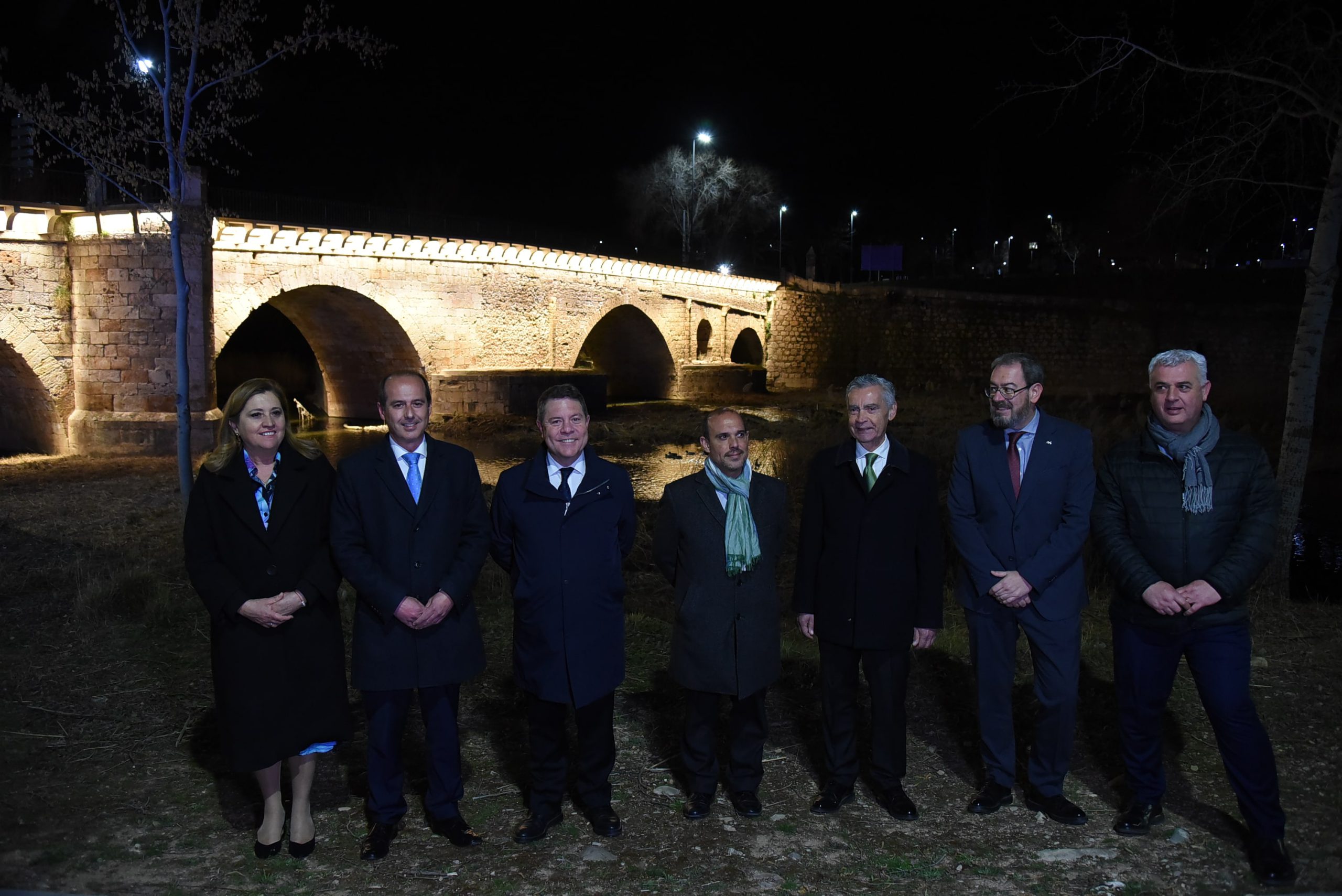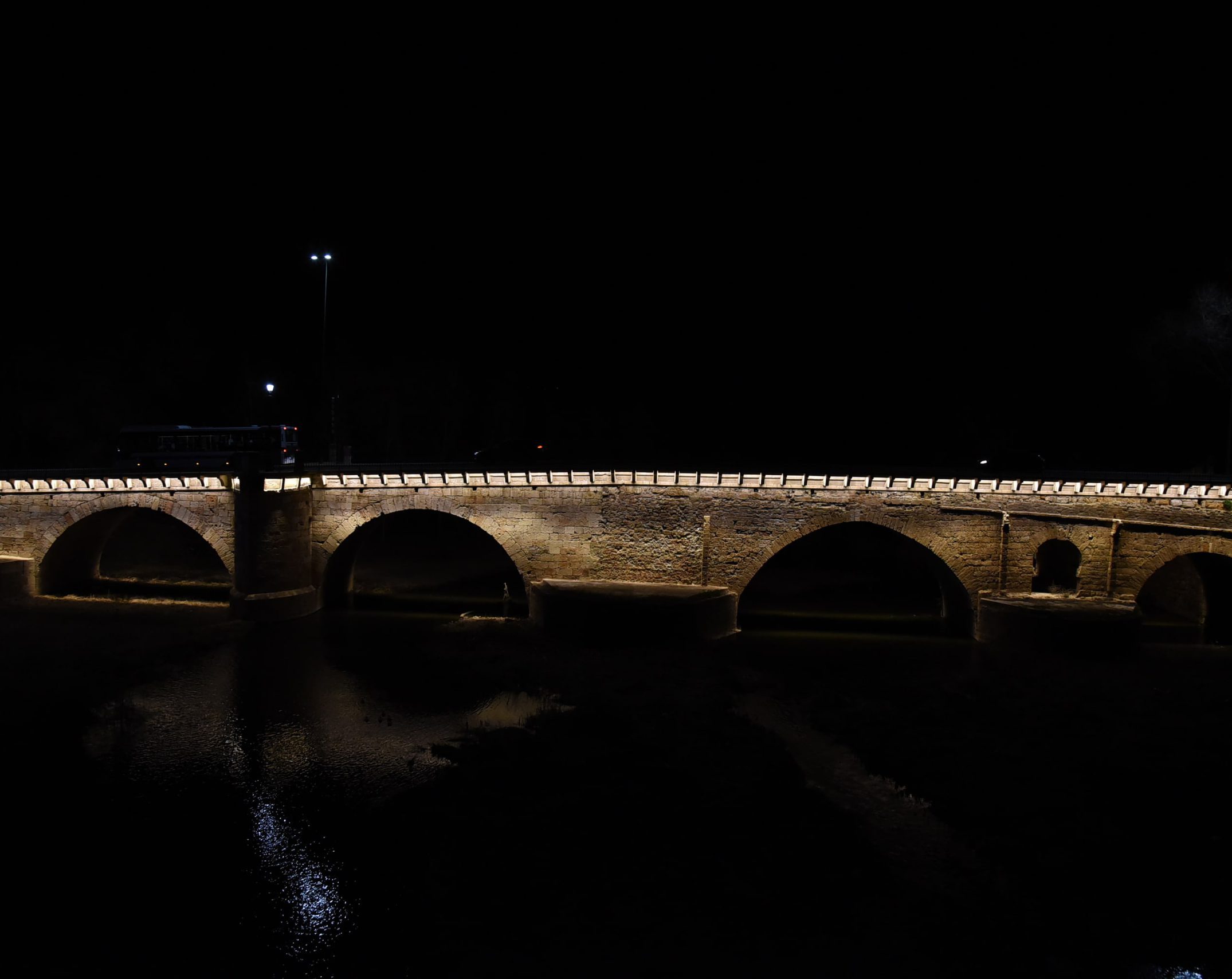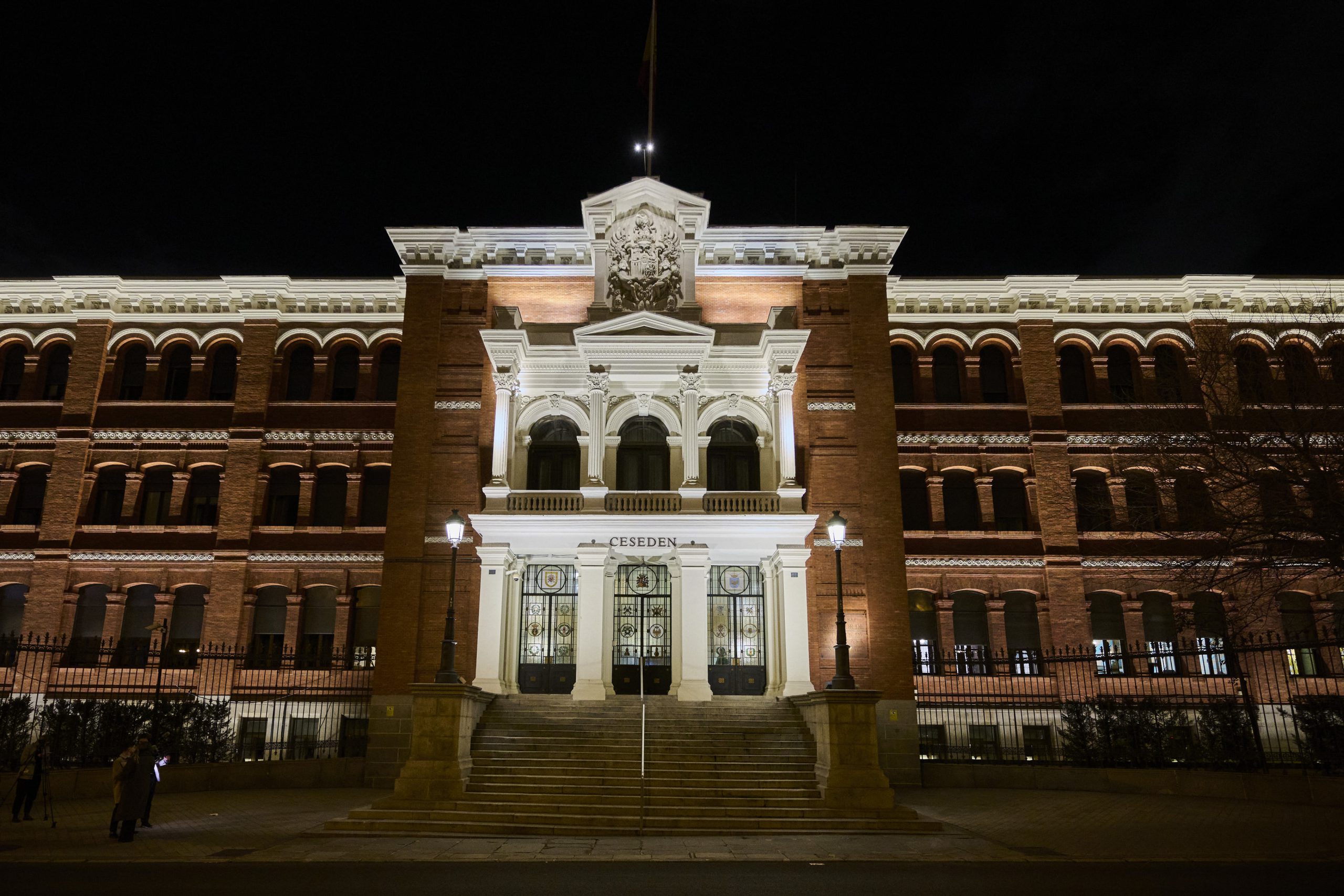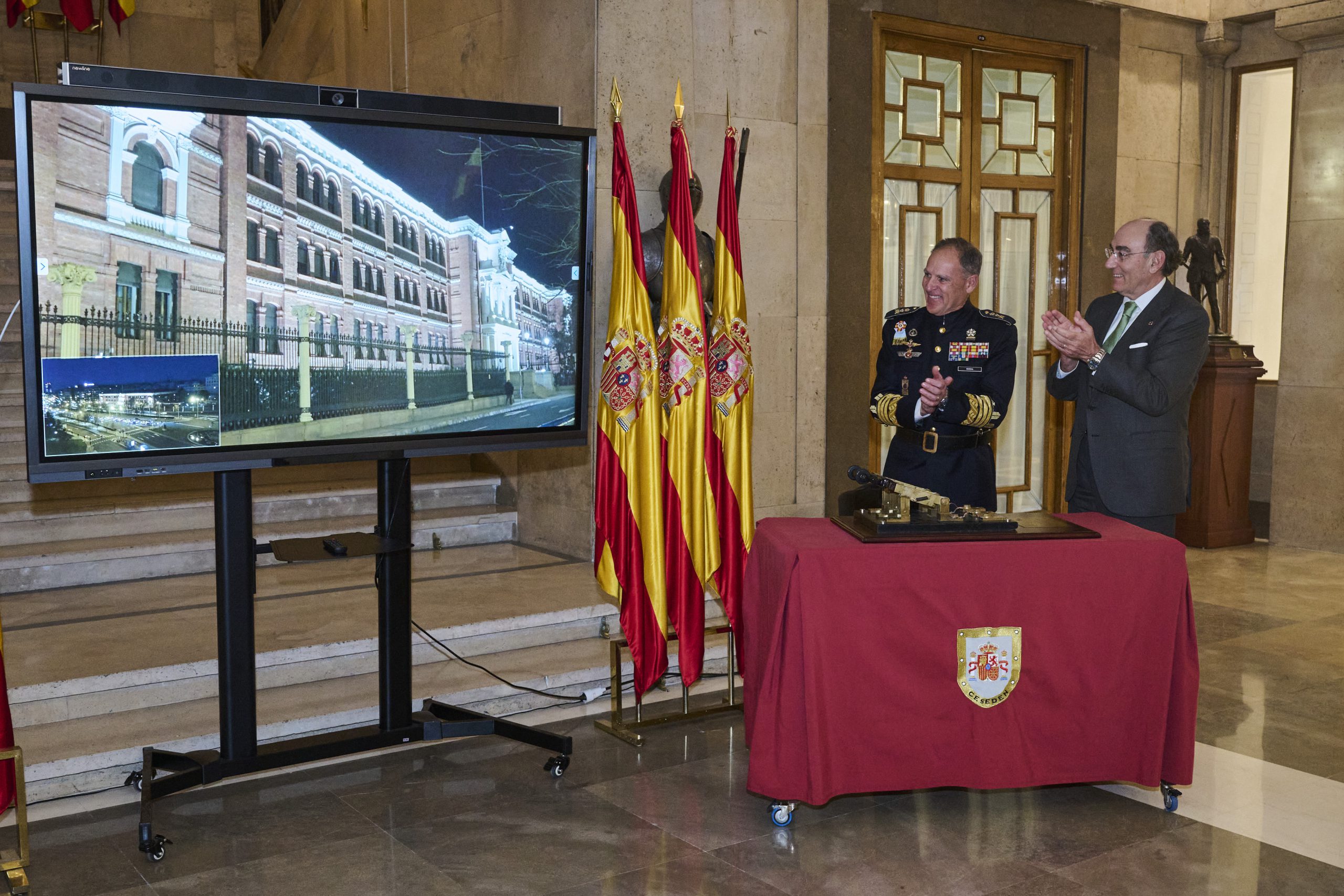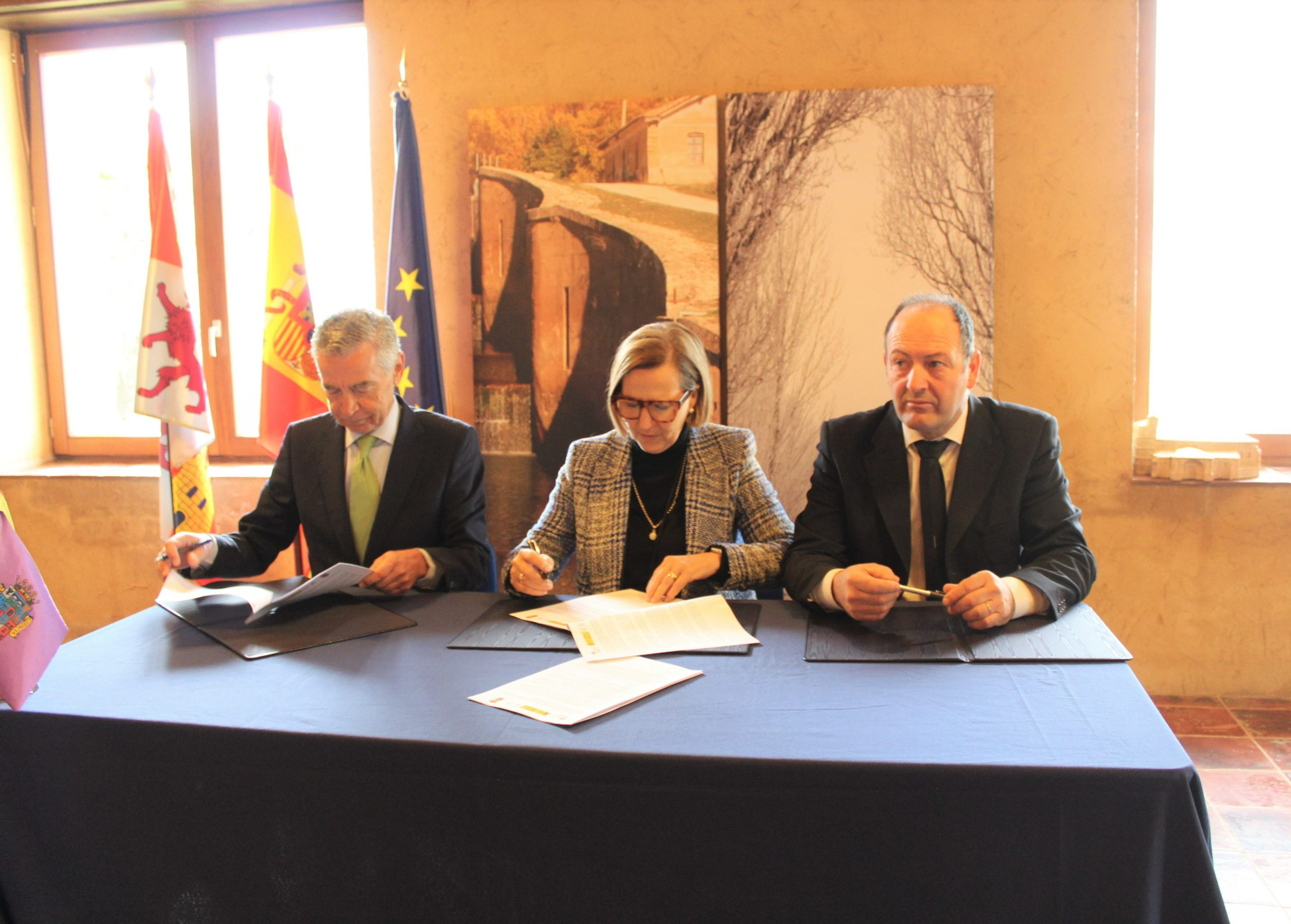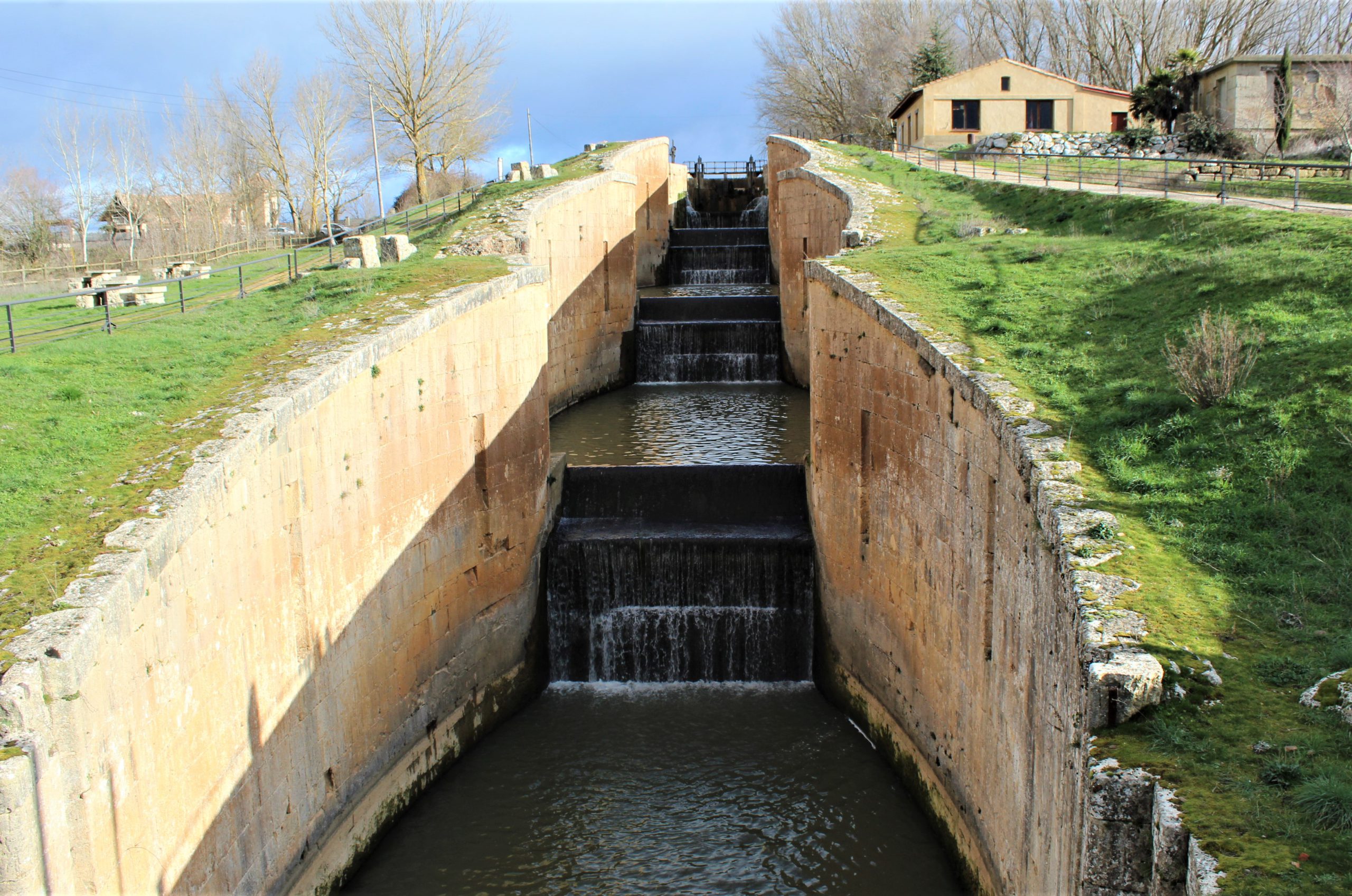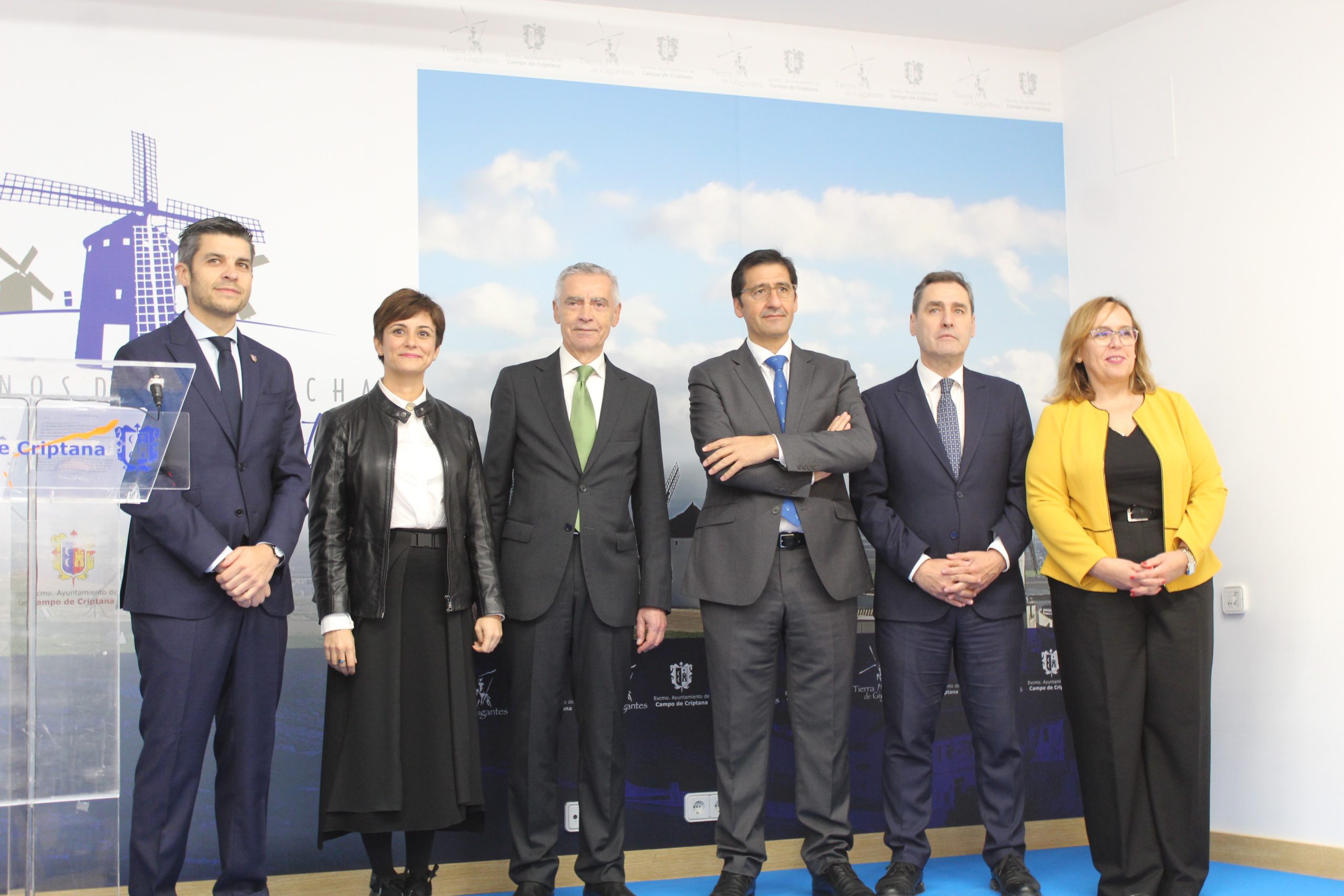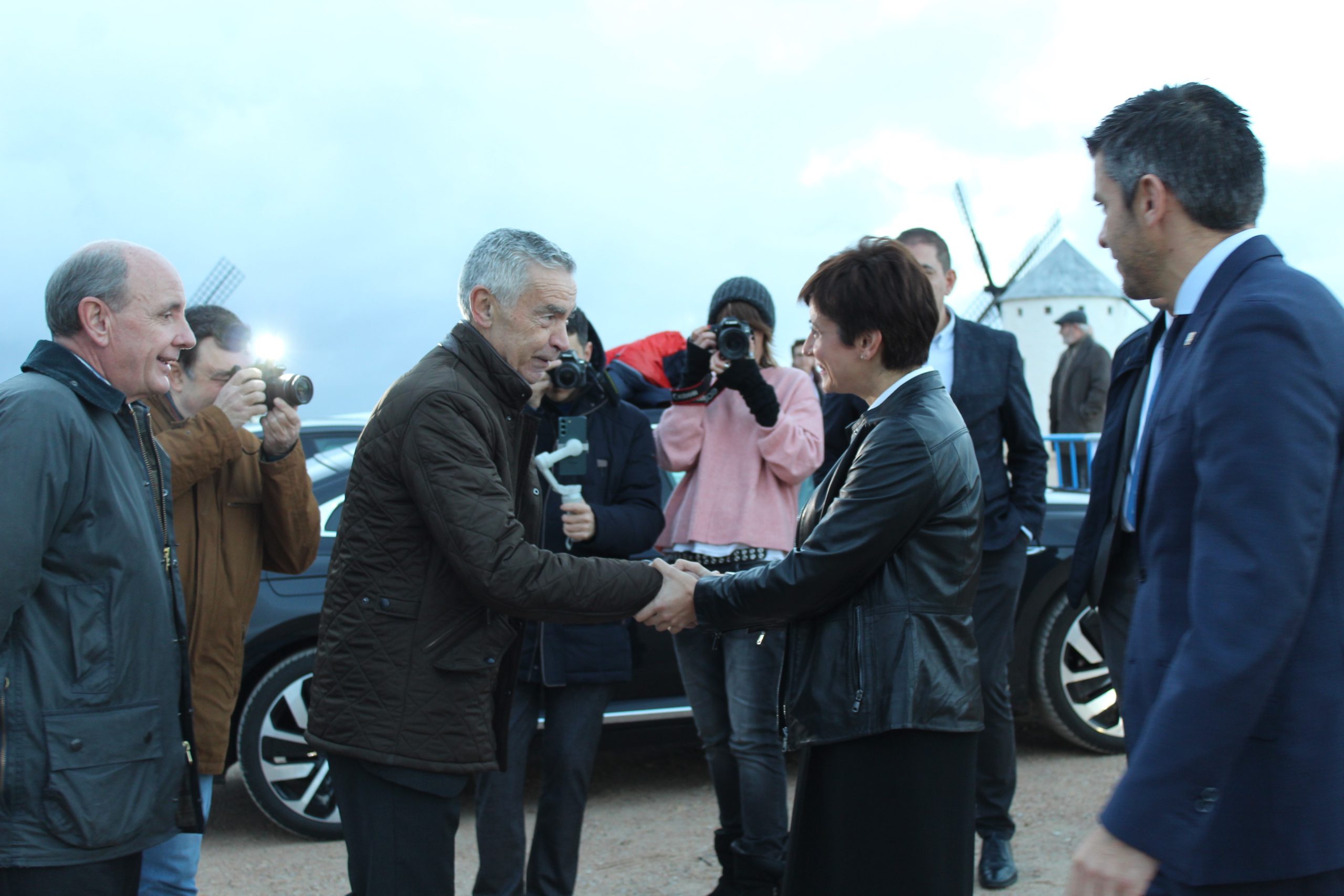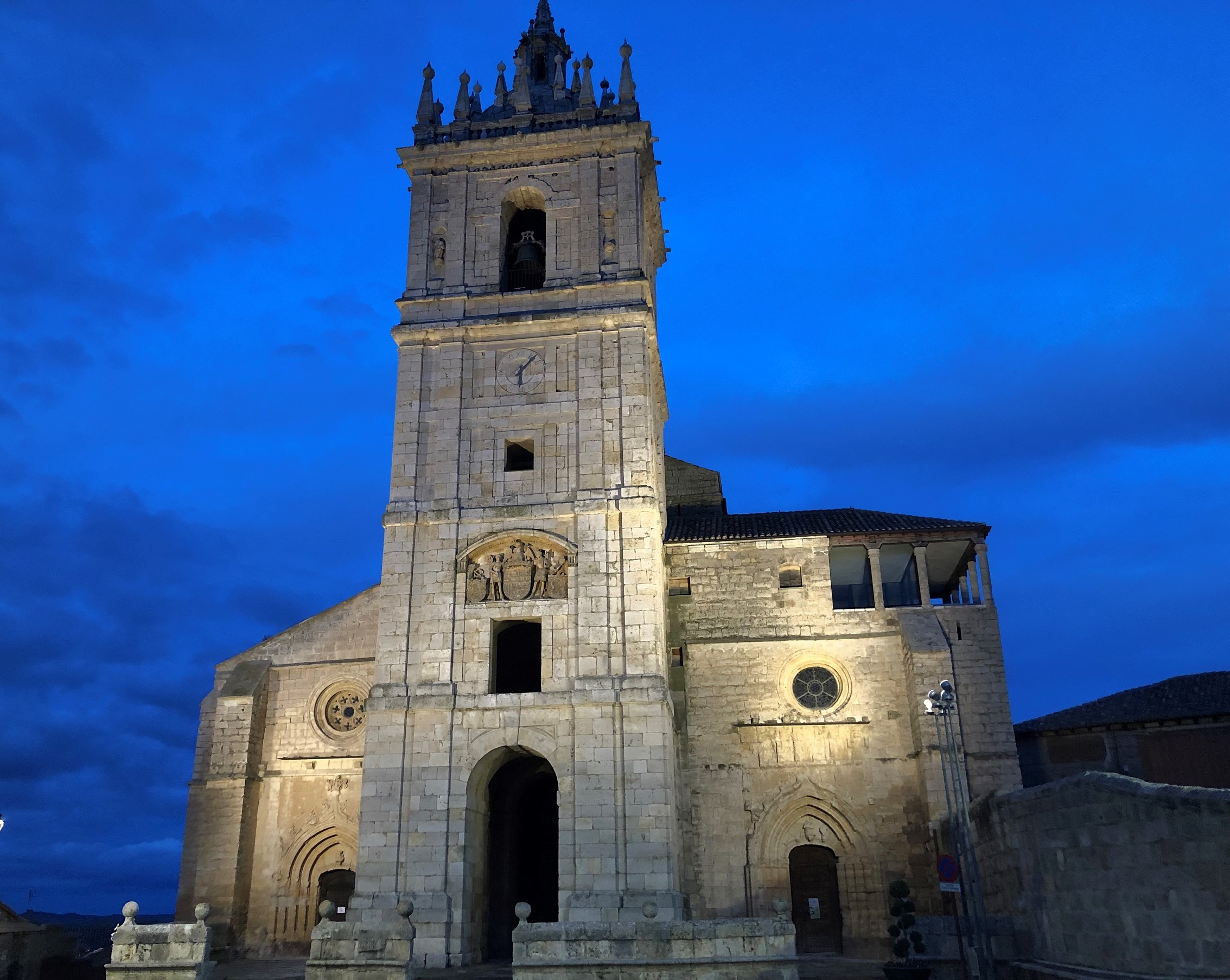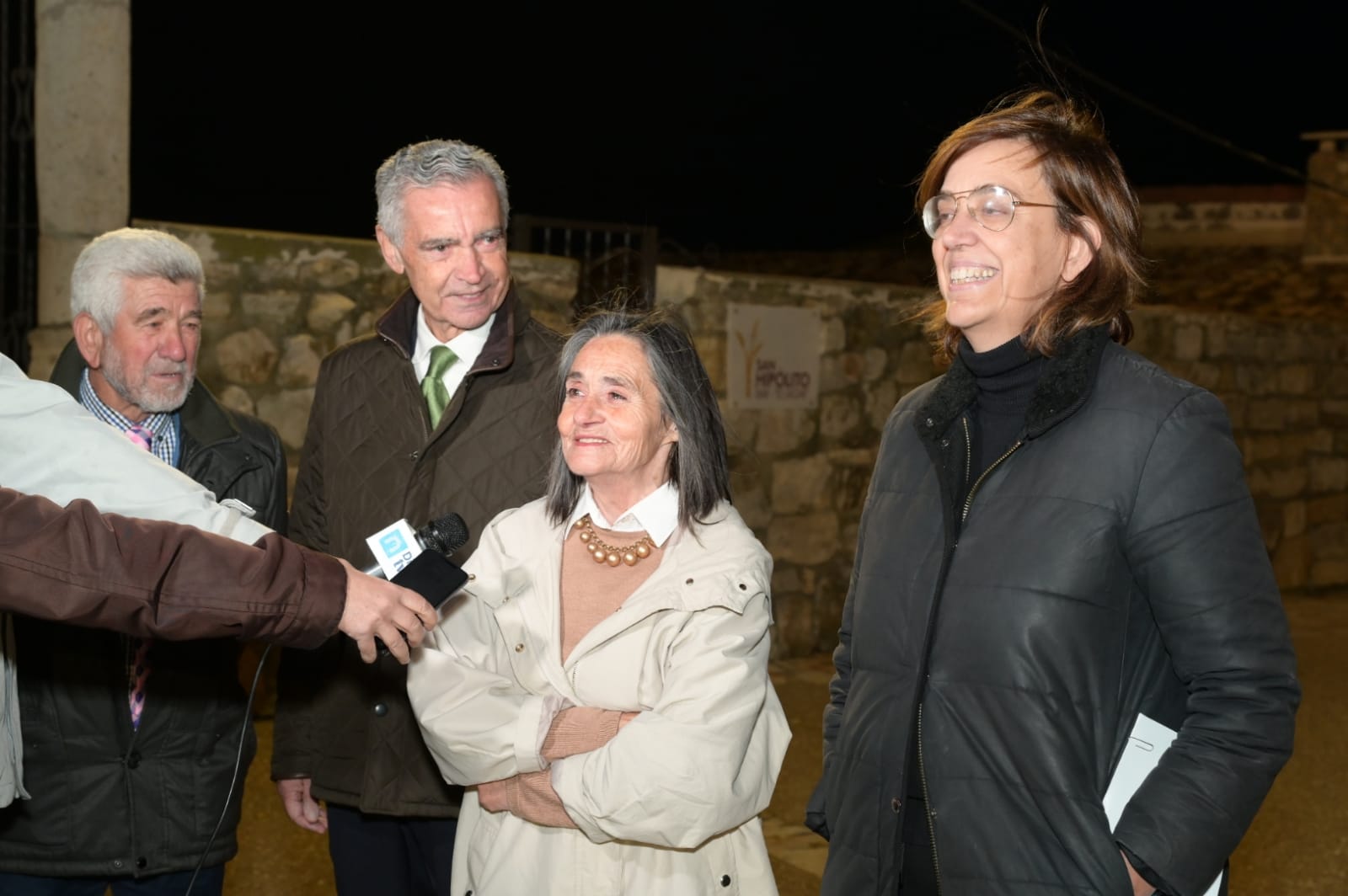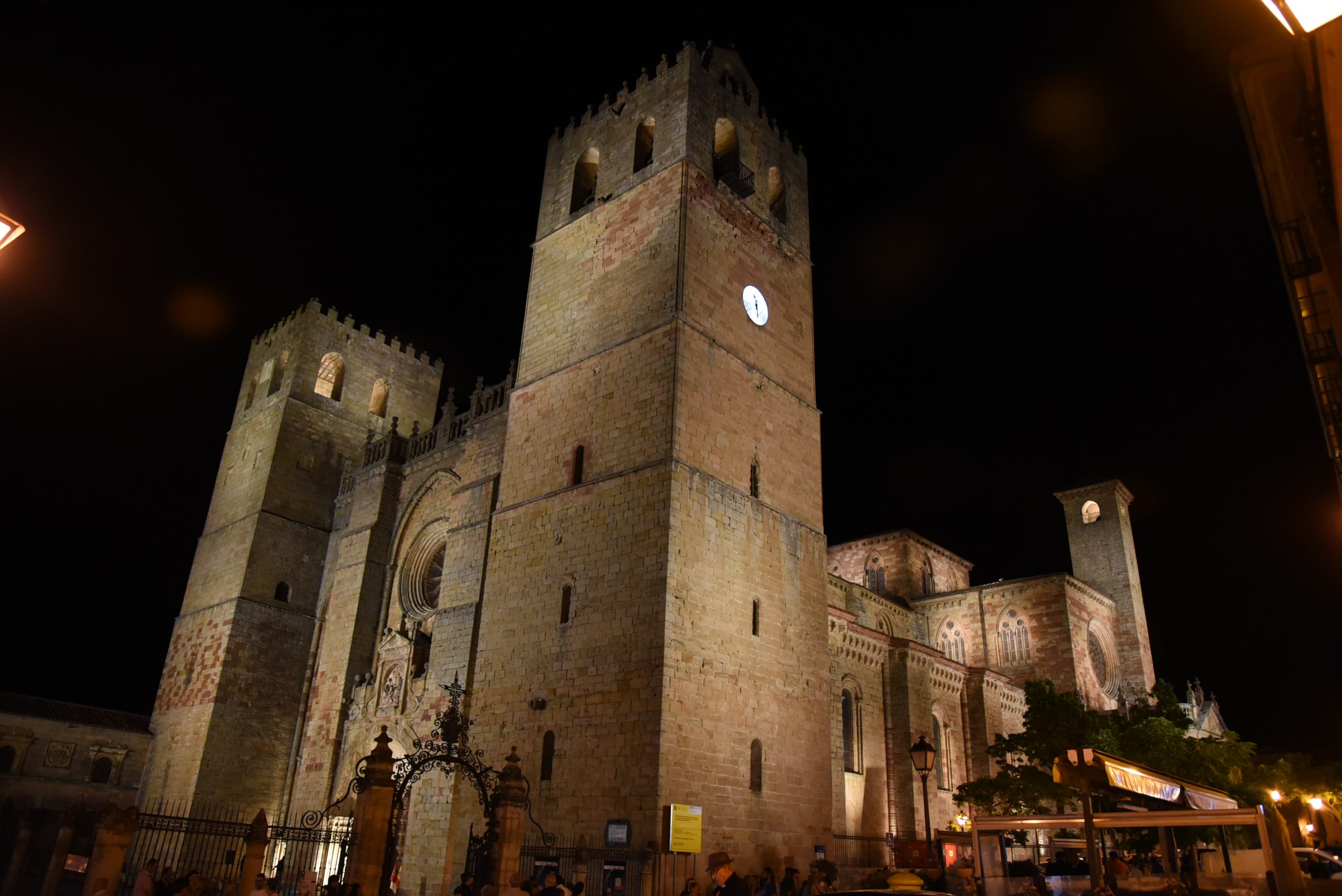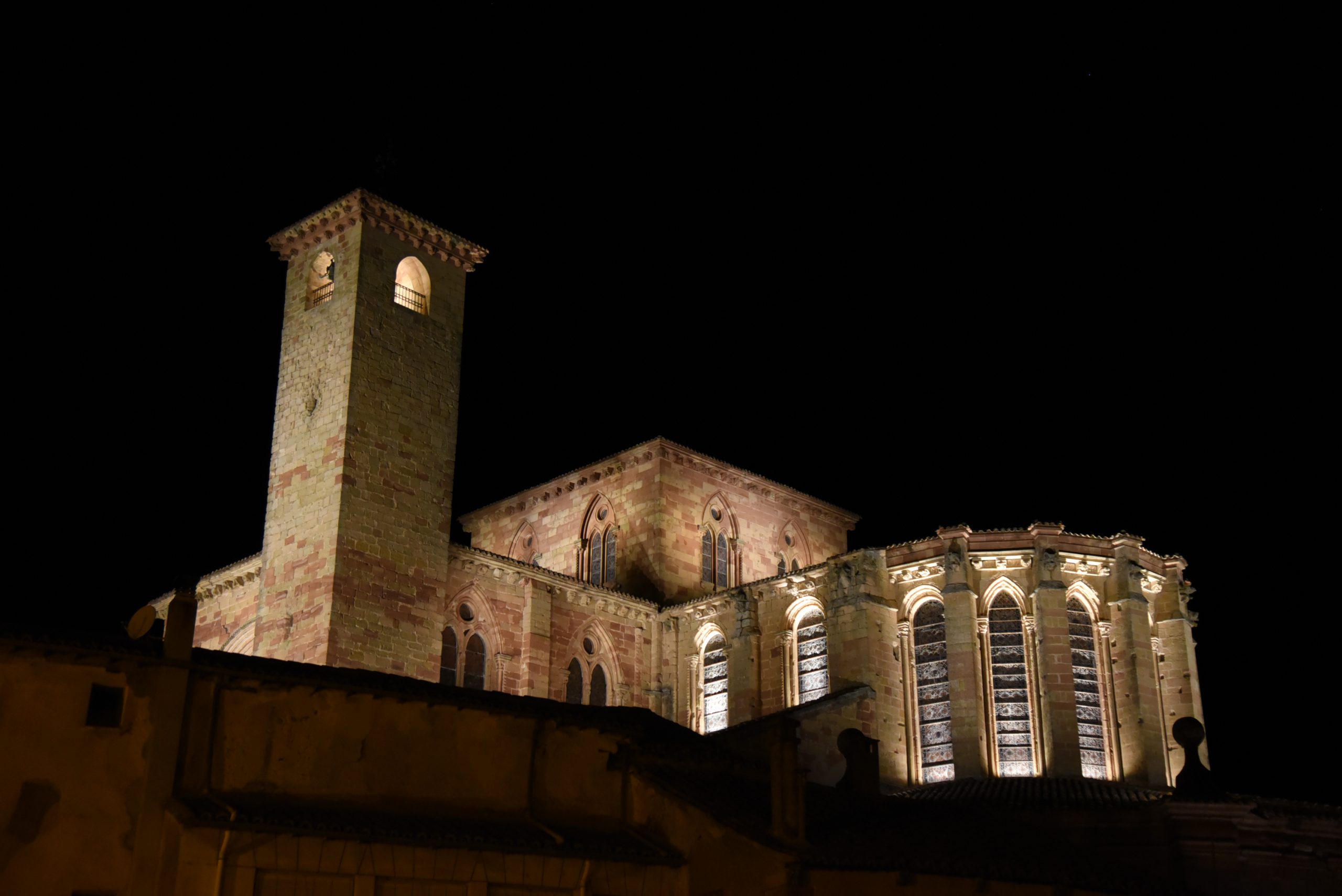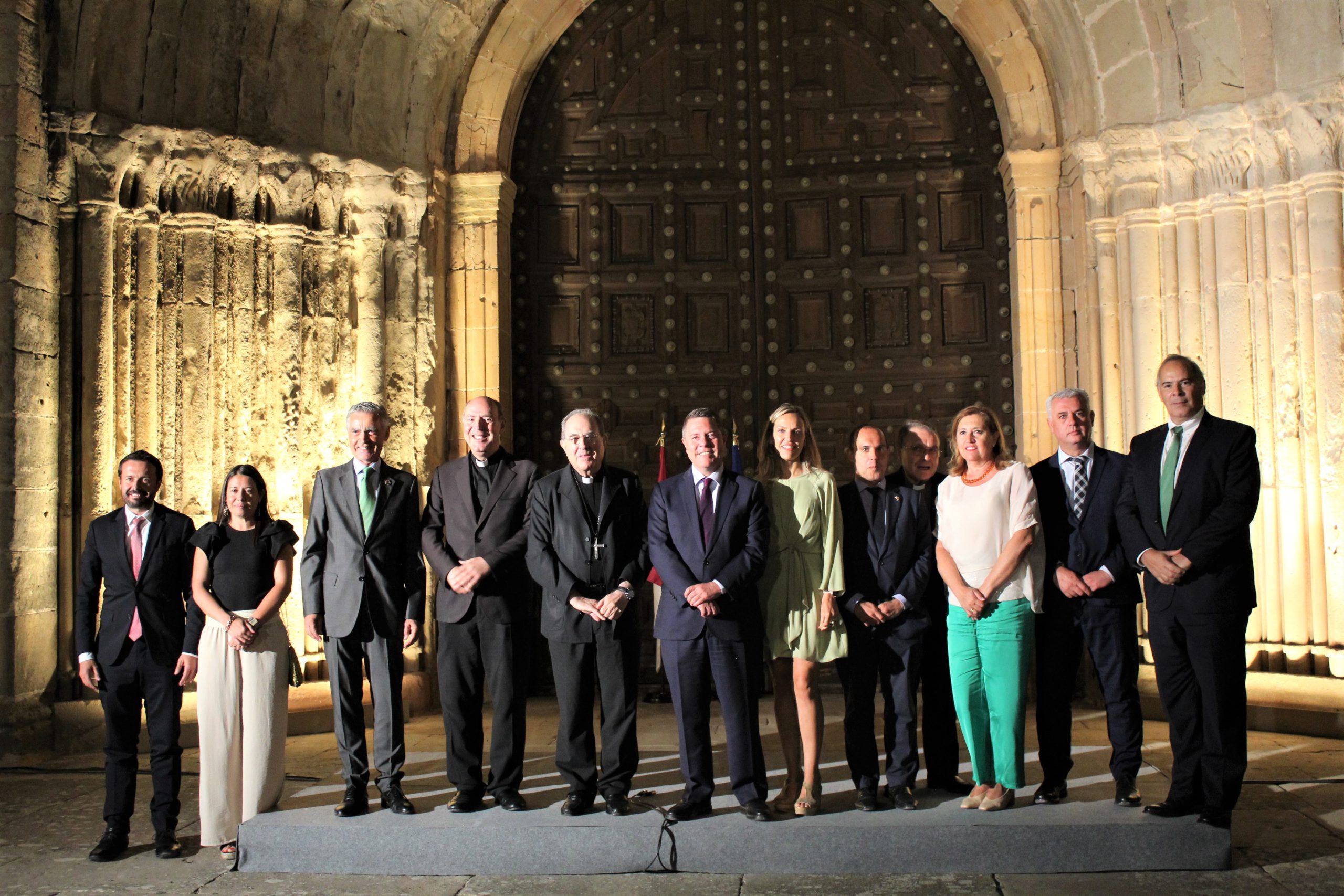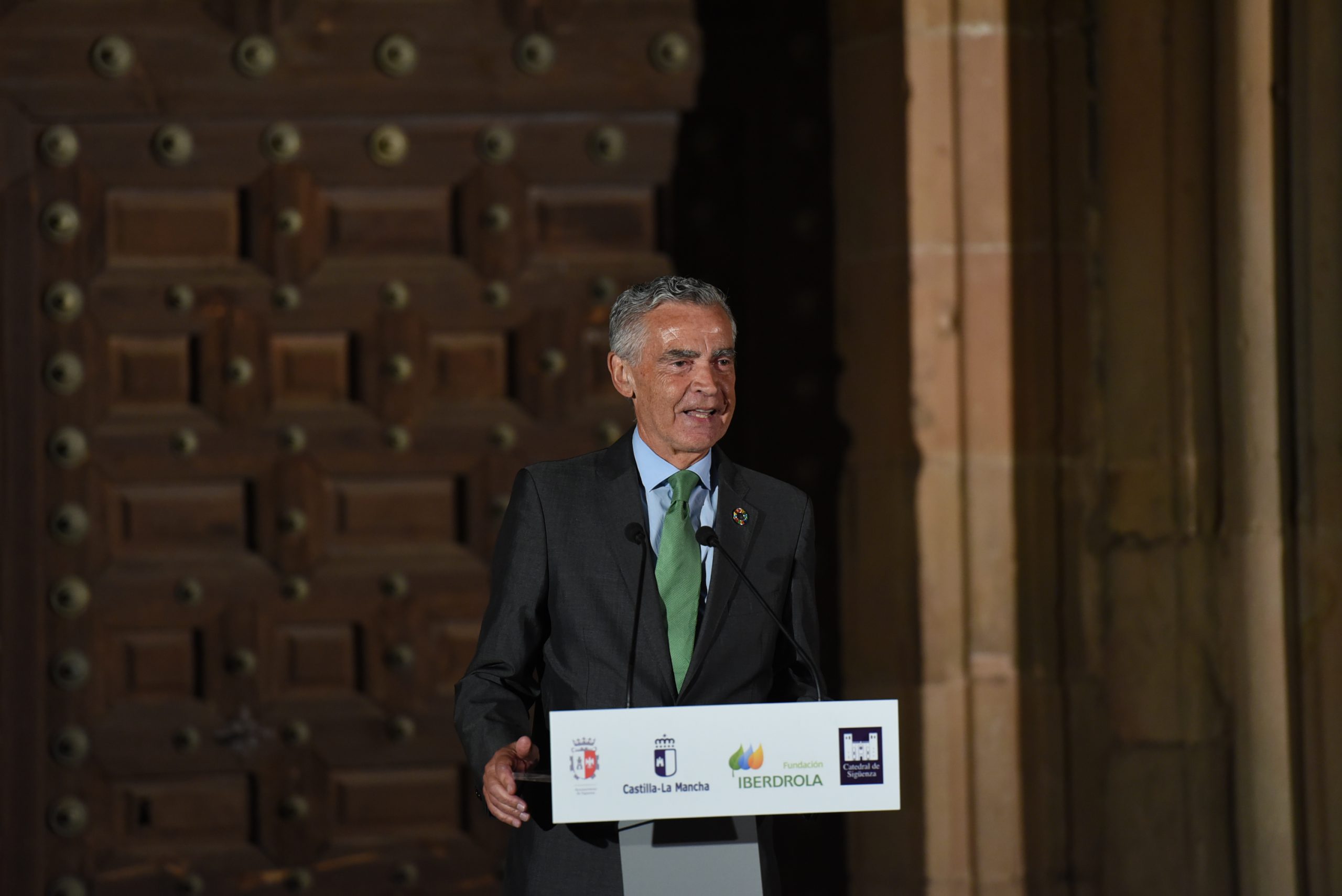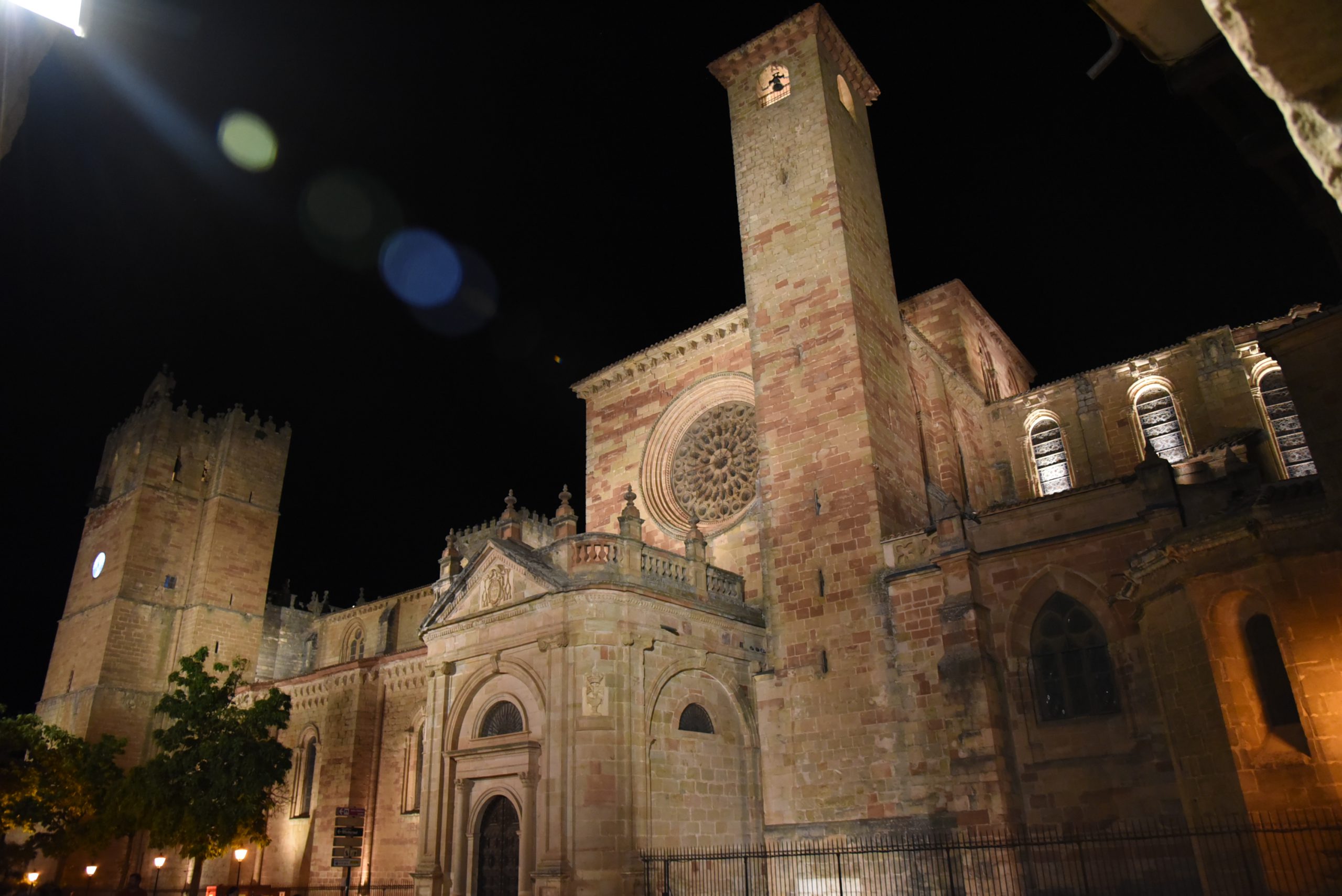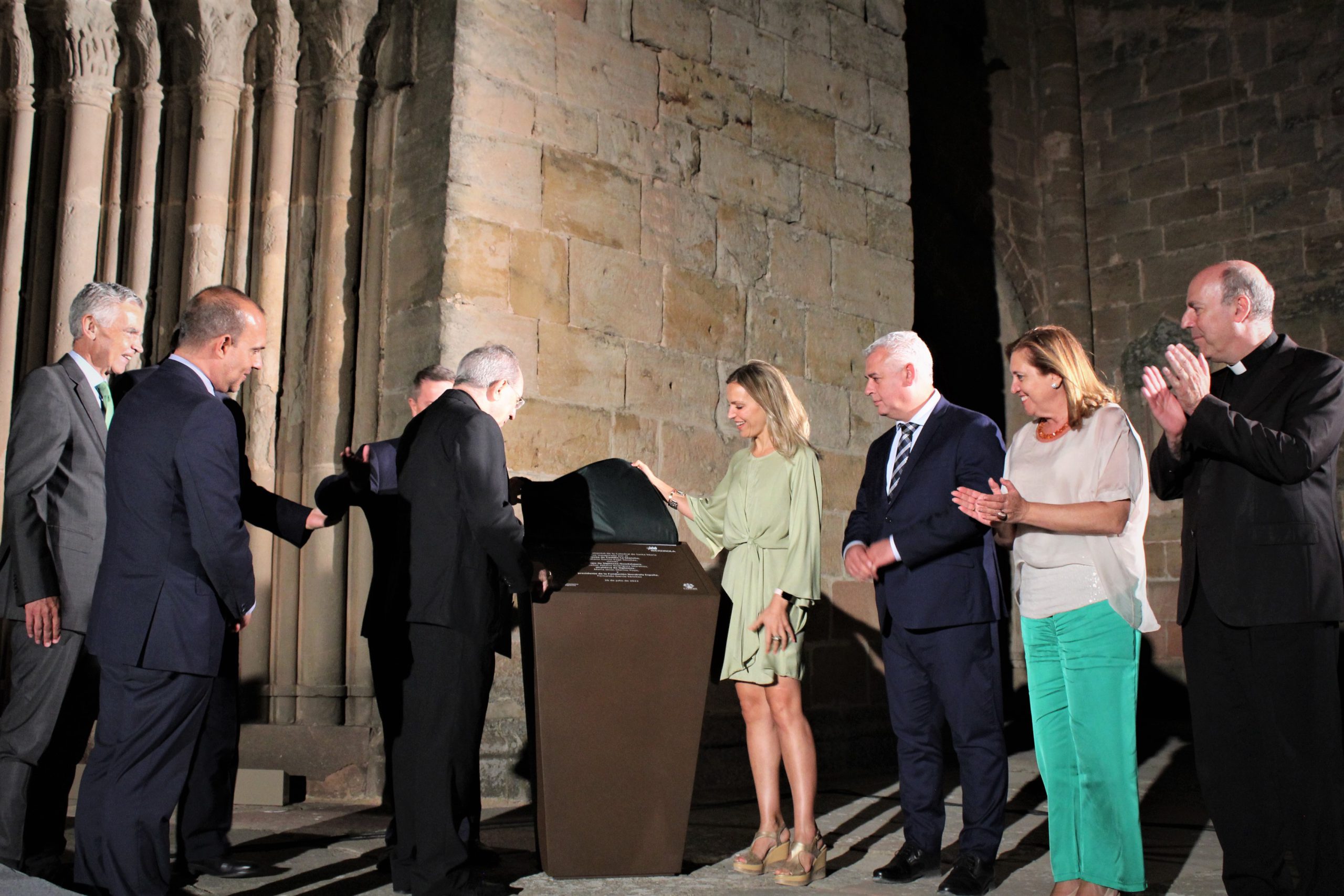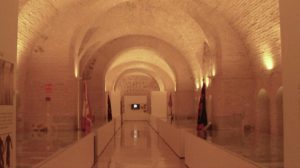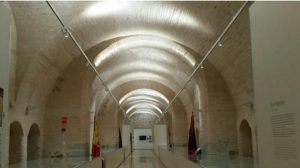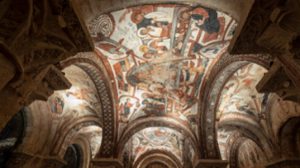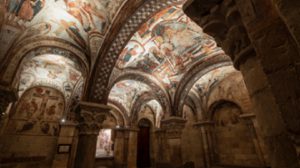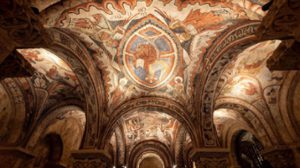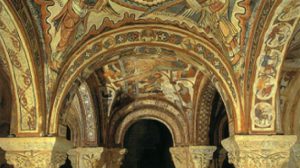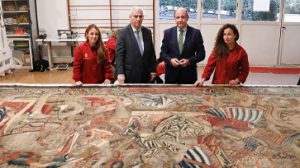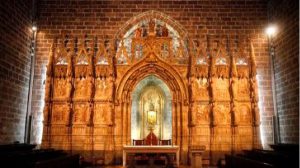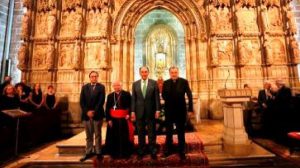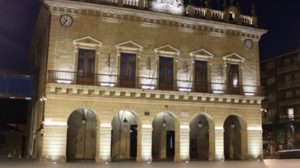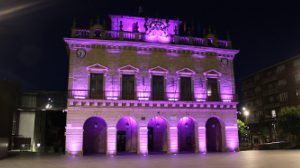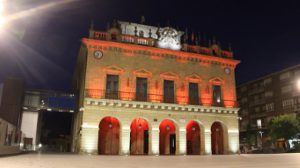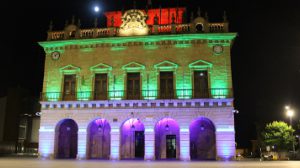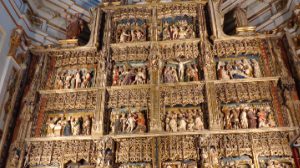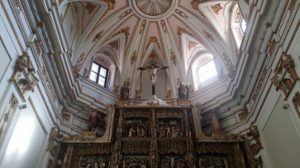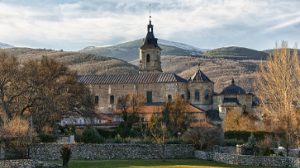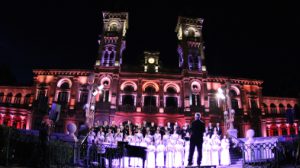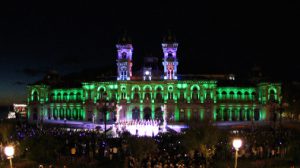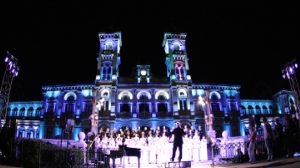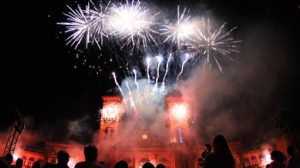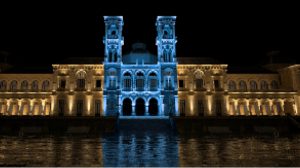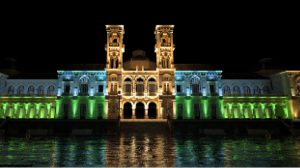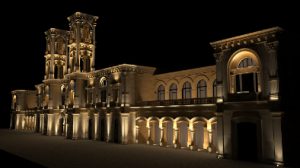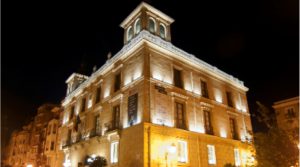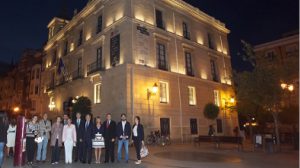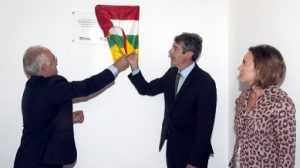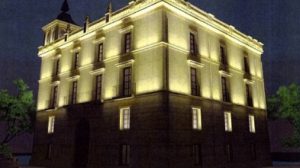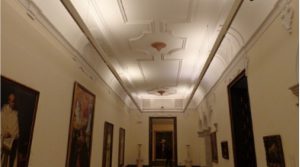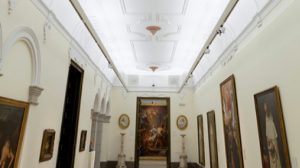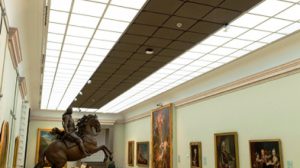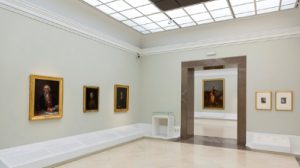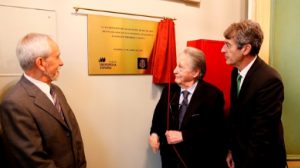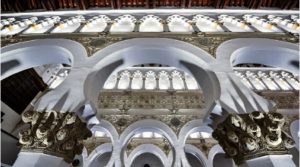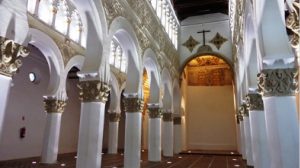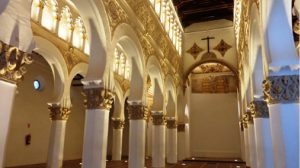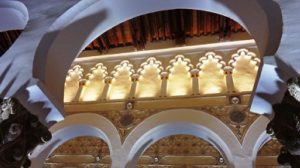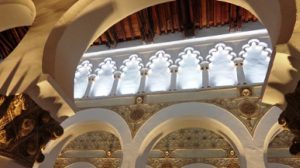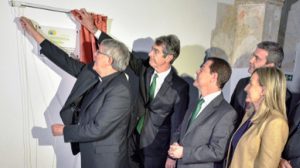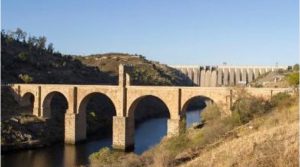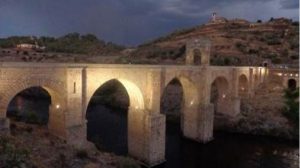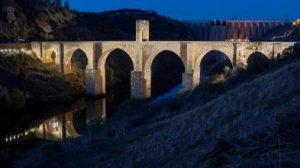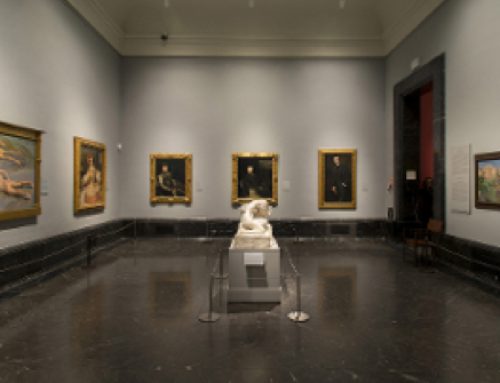Actions in emblematic buildings
These are some of the lighting projects in emblematic buildings that Fundación Iberdrola España has been involved in:
- Fundación Iberdrola has enhanced the temple with an innovative project that achieves a 50% improvement in its energy efficiency and saving in atmospheric emissions of 320 kg of CO2 per year
- With an investment of 90,000 euros, the works are another example of Iberdrola’s commitment to Galicia and its commitment to the conservation of the region’s historical and artistic heritage
The interior of the church of the Colegio de Nuestra Señora de la Antigua de Monforte de Lemos (Lugo), has a new artistic lighting system. This is one of the most emblematic buildings of the town, listed as a Cultural Interest Asset, where uniform and medium type lighting has been installed that acts on the nave, the transept, and the chancel, respecting the environment and reducing light pollution. Fundación Iberdrola has carried out this innovative project that enhances and adds value to the church with a more efficient system.
The objective is to highlight the height and depth of the church, with an installation that emphasizes the monumentality of the vaults. The main altarpiece is given special attention with small projectors that focus on certain areas, so that it does not lose its volume with the lighting, and the side chapels have been given a general illumination.
In addition, a specific design has been made with a very careful installation for the alabaster luminaires that hang on the two sides of the nave and illuminate the worship area. LED technology has been used for this purpose. A total of 80 luminaires have been installed, combined with more than 200 meters of LED strips.
The total installed power is 3,167W. This represents an efficiency of 50% compared to the previous installation and will save 320 kg of CO2 emissions into the atmosphere per year. In addition to the energy savings, the project meets the objective of offering versatility so that the new lighting can respond to different uses of the church.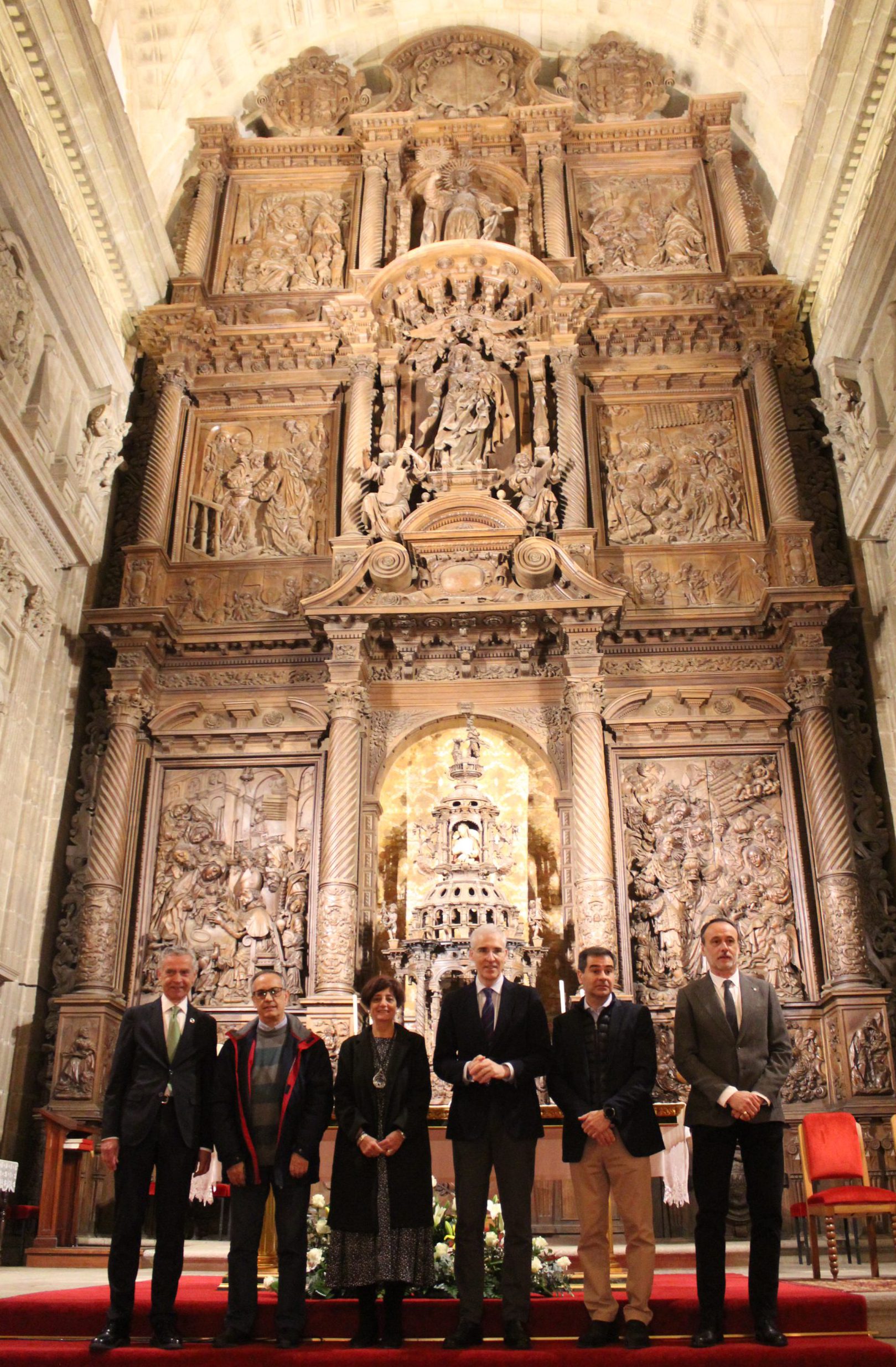
The inauguration of the lighting was attended by the first vice president of the Xunta de Galicia, Francisco Conde; the deputy mayor of the City of Monforte de Lemos, Gloria Prada; the director of the Colegio de los Padres Escolapios, Pablo Blanco and the president of the Fundación Iberdrola España, Fernando García.
The execution of the project, which is part of Iberdrola’s Lighting Program, has involved an investment of 90,000 euros. It is one more of the company’s commitments to Galicia and its permanent purpose of promoting the social value of culture and conservation of the historical and artistic heritage of the region.
Since 2011, the program has allocated more than 3 million euros and has led to the improvement of more than 40 monuments in Spain, including the Cathedral of Avila, the interior of the Cathedral of Palencia and the New Cathedral of Salamanca, the historic Roman Bridge of Alcántara in Cáceres, the facade of the Congress of Deputies, the Palace of the Supreme Court in Madrid, the Cathedral of Santiago de Compostela and the Cathedral of Sigüenza.
Colegio de Ntra. Sra. de la Antigua Church
It is a building of the sixteenth century, which has the declaration of BIC. Built-in the Herrerian style, it is often referred to as the Galician Escorial for being one of the few manifestations of this style in Galicia. Work on the school began in 1593 under the patronage of Cardinal Rodrigo de Castro, considered by many to be the last great ecclesiastical prince of the Renaissance, archbishop of Seville, benefactor of Monforte, and patron of the arts.
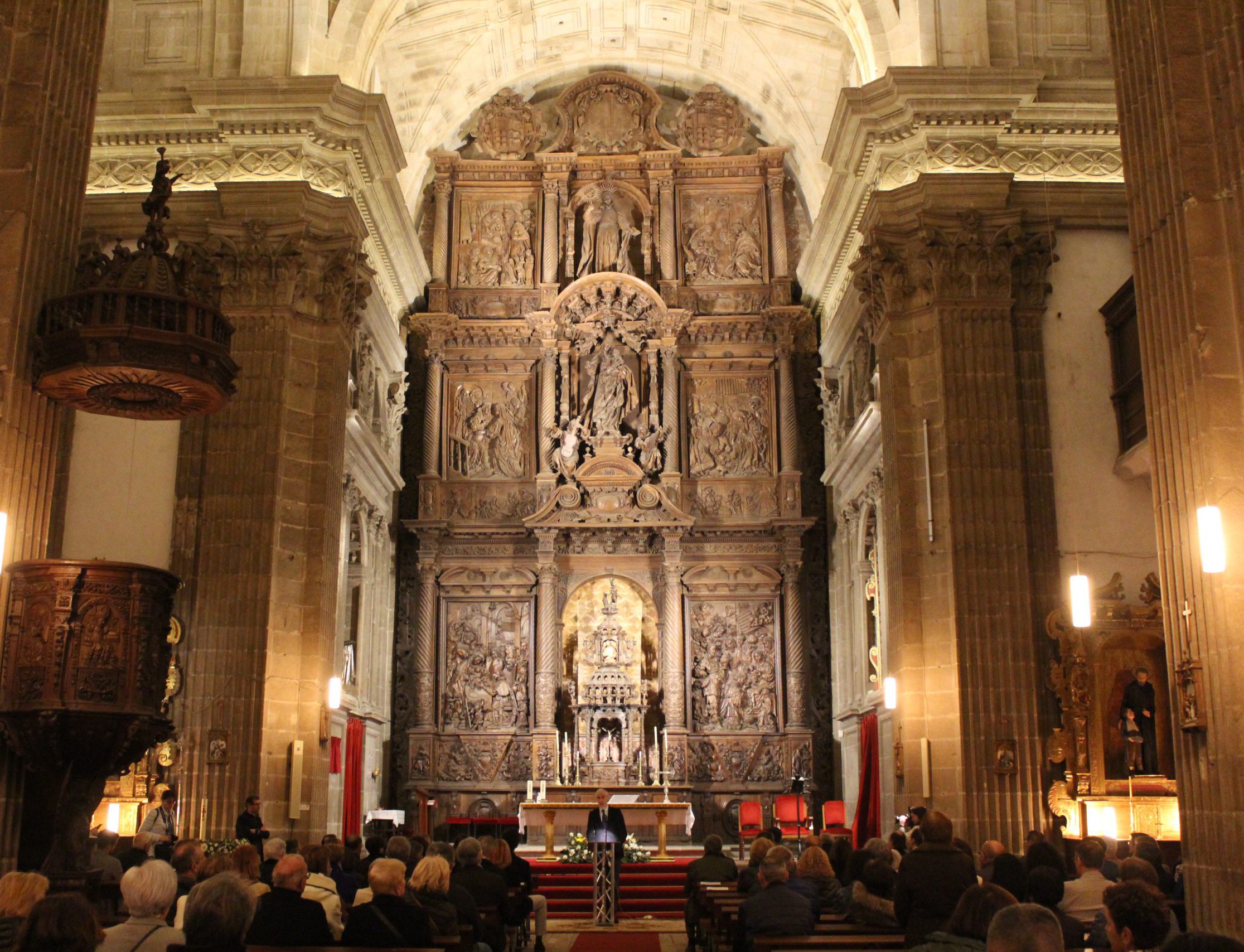
- Inaugurated by the President of the Junta de Castilla-La Mancha, Emiliano Garcia-Page, the new facility enhances its heritage value, favors road circulation, and promotes efficiency and energy savings
- This action is part of Iberdrola’s initiatives for the care and conservation of the historical and artistic wealth of our country. Improvements have been made to more than 40 monuments in Spain
One of Guadalajara’s most emblematic and historic monuments now boasts more efficient lighting, highlighting its important historical and heritage value. Iberdrola, through its Foundation in Spain, has been in charge of the ornamental project. It is a zenithal lighting that emulates sunlight, which, in addition to highlighting its relevance, provides greater energy efficiency with minimal CO2 emissions while avoiding glare on the bridge’s road traffic.
In total, more than 147 luminaires have been installed, tailor-made, and designed specifically for this project, with optics that have allowed lighting that highlights the “skin” of the bridge and with a warm color temperature following the color of the stone. The power of the luminaires, only 4.3 kW, guarantees their sustainability over time.
The lighting was inaugurated by Emiliano García-Page, president of the Junta de Comunidades de Castilla-La Mancha, in a ceremony attended by Fernando García, president of Fundación Iberdrola España, Alberto Rojo Blas, mayor of Guadalajara, Pablo Bellido Acevedo, president of the Cortes de Castilla-La Mancha, and Rosa Ana Rodríguez Pérez, minister of Education, Culture, and Sports.
The initiative, which is part of Iberdrola’s Illuminations Program, has had an investment of 150,000 euros and “is another example of the company’s commitment to Castilla-La Mancha, the conservation of the historical and artistic heritage of the region and the promotion of the social value of culture,” said Fernando García, president of the Iberdrola Foundation at the inauguration.
History and modernity, united in the new bridge light
“Illuminating from modernity the latent history of the Arab Bridge of Henares” is the title of the project that seeks to preserve and enhance the history of the monument through new lighting.
The origins of the bridge date back to the years of transition from the tenth to the eleventh century, in the Arab Caliphate, the time of Abderraman III. During the Middle Ages, it was considered a monumental bridge. In the early seventeenth century it suffered major damage in the War of Succession and was subsequently rebuilt in several interventions since the mid-nineteenth century until its last intervention in 1922 to widen the upper roadway with a new deck.
All these periods and their interventions can still be read in the bridge’s cuttings and materials.
Fundación Iberdrola with culture
Since its creation, Iberdrola has been committed to the energy, cultural and social development of the communities in which it is present. In this regard, Fundación Iberdrola España represents a further step in this commitment by promoting initiatives that contribute to improving people’s quality of life. One of the Foundation’s main areas of action focuses on the care, maintenance, and promotion of art and culture.
This project is in addition to others that the company has carried out in Castilla-La Mancha in recent years, including the illuminations of the Monastery of Uclés, the Old Bridge of Talavera de la Reina and the Plaza Mayor of Sigüenza, among others, as well as exhibition projects such as El Prado en las Calles or Un Patrimonio de Todos.
Media error: Format(s) not supported or source(s) not found
Download File: https://www.kaltura.com/p/0/sp/0/playManifest/entryId/1_j213tyuv/format/url/flavorParamId/0/video.mp4?_=1- With this action, Iberdrola has already allocated 3 million euros to initiatives for the improvement of more than 40 monuments in Spain
- The new lighting of the building, in the heart of Madrid’s Paseo de la Castellana, enhances its architecture, improves its energy efficiency, and will reduce CO2 emissions into the atmosphere
The Centro Superior de Estudios de la Defensa Nacional (CESEDEN) has unveiled today its exterior lighting, according to the agreement signed between the Iberdrola Spain Foundation and the Ministry of Defense. This action is part of Iberdrola’s initiatives for the care and conservation of historical-artistic wealth.
The inauguration of the lighting took place this afternoon. It has a total of 70 luminaires with a power of 1,138 W, which uses the most advanced LED technology, and with which it is possible to reduce the energy consumption of the building, reduce light pollution, as well as minimize maintenance work.
The new design demonstrates the Iberdrola Foundation’s commitment to promoting innovation and respect for the environment and provides the façade with general, dim, and continuous lighting, taking advantage of its warm, flattened brick surface. In addition, the different degrees of light reflection of the system will be responsible for maintaining the same sensation and light perception that is generated with natural light, enhancing its architecture.
The switch-on ceremony, in Madrid’s Paseo de la Castellana, was attended by Admiral General Teodoro Esteban López Calderón, JEMAD; Lieutenant General Francisco de Paula Bisbal Pons, DICESEDEN; the Chairman of Iberdrola, Ignacio Galán; and the Chairman of Fundación Iberdrola España, Fernando García Sánchez.
In his speech, Ignacio Galán expressed his satisfaction with this contribution to the conservation of historical and artistic heritage, which is part of Iberdrola’s lighting program: “Today we want to contribute to the “lighthouse of knowledge” of the three armies having the exterior lighting it deserves. Our technicians have carried out a project that enhances the characteristics of this magnificent building, helping the residents of Madrid and visitors from Spain and around the world to appreciate its beauty, and to learn more about the importance of the mission of this Center”.
The execution of the project has involved an investment of 79,500 euros. This is in addition to the actions of the Illuminations Program since 2011, with which Iberdrola has allocated more than 3 million euros to the improvement of more than 40 monuments in Spain. These include the historic Roman Bridge of Alcántara, in Cáceres; the façade of the Congress of Deputies and the Supreme Court, in Madrid; the interior of the New Cathedral of Salamanca or the Cathedral of Santiago.
Centro Superior de Estudios de la Defensa (CESEDEN)
The original design of the building that houses the CESEDEN is from the end of the 19th century, by the architect Ricardo Velázquez Bosco; it was designed to house the National School for the Deaf, Dumb, and Blind of Madrid. It is a longitudinal building that combines red brick and white access and cornices. It is an extraordinary example of the best eclectic architecture of Madrid, which even today, more than a century after its construction, plays a representative role in the urban scene of the main artery of the capital, the Paseo de la Castellana.
The building has undergone several renovations over the years, the first to house the headquarters of the National Pedagogical Museum, the Teacher Training College, or the Board of Pedagogical Missions, during the Second Republic. After the Civil War, reforms were carried out to convert it into the Escuela Superior del Ejército (Army High School). That is to say, from the beginning, the educational and pedagogical uses of this building were defined, which have been maintained to the present day.
- The Duero Hydrographic Confederation, the Frómista Town Council, and Fundación Iberdrola España have joined forces to carry out this project that will contribute to sustainability by improving its energy efficiency
- The new lighting will use LED technology and will accentuate its beauty through a design adapted to the heritage values of the enclave
The Duero Hydrographic Confederation, the Frómista Town Council, and Fundación Iberdrola España have joined forces to carry out the lighting project of the quadruple lock, a tourist landmark in the town of Frómista that represents one of the most important hydraulic engineering works of the Canal de Castilla, which saves four slopes with a total height of 14.20 meters.
The president of the Duero Hydrographic Confederation (CHD), María Jesús Lafuente, the mayor of the town, Fernando Díez Mediavilla, and the president of the Fundación Iberdrola España, Fernando García, presented this morning an alliance to formalize this initiative that will contribute to the sustainability of the ornamental lighting of the lock.
The project, which is part of the Illuminations Program of Fundación Iberdrola España, will involve an investment of 30,000 euros to provide this enclave with new lighting that will accentuate its beauty through a design adapted to the lock’s heritage values.
The design contemplates the criteria of efficiency and energy saving as well as the use of LED technology: reduction of environmental light pollution and respect for the natural environment of the enclave. A very careful installation will be carried out, considering reversibility criteria.
The renovation of the lighting of this engineering work is another example of Iberdrola’s commitment to Castilla y León and its permanent aim to promote the social value of the culture, origin, and conservation of the historical and artistic heritage of the region.
A Strategy to promote the value of the Canal de Castilla
The Duero Hydrographic Confederation is currently developing the 2021-2024 Strategy, to combine the social and historical value of the Canal de Castilla with its environmental potential. A project with a global investment of more than 16 million euros.
The actions contemplated include the restoration of part of the canal’s infrastructures (hydraulic and related buildings) to improve the conservation of its rich material heritage. The project for the creation of a green corridor around the Canal is also being drafted, for an amount of 9.6 million euros, as a cultural landscape and a backbone of the territory.
The Canal de Castilla is one of the most paradigmatic hydraulic works of all those managed by the Duero Hydrographic Confederation. The Strategy implemented by the Agency contemplates actions along the 207 kilometers through which the Canal runs in the provinces of Palencia, Valladolid, and Burgos. At present, its waters irrigate more than 21,000 hectares and supply 400,000 inhabitants in the provinces of Valladolid and Palencia.
Iberdrola, with the promotion of art and culture
One of Iberdrola’s main areas of action, through its foundation in Spain, focuses on the care, conservation, and enhancement of historical and artistic wealth.
The main objective of the Illumination Program is to develop interventions in unique buildings to install or improve their interior and/or exterior lighting systems to contribute to the enhancement of heritage.
Since 2011, the volume of investment allocated to the Illumination Program has amounted to more than 3 million euros and has involved improvements of over 40 monuments in Spain, including the Cathedral of Avila, the interior of the Cathedral of Palencia and the New Cathedral of Salamanca, the church of San Hipólito el Real in Palencia, the historic Roman Bridge of Alcántara in Cáceres, the façade of the Congress of Deputies, the Palace of the Supreme Court in Madrid, the Cathedral of Santiago de Compostela and the Cathedral of Sigüenza.
- Fundación Iberdrola España has contributed more than 18,000 euros to this new lighting project.
- It is a uniform, medium-type lighting that respects the environment and reduces light pollution.
Iberdrola, within the framework of the collaboration agreement signed with the City Council of Campo de Criptana in November 2022, has developed the lighting project for the archaeological remains of the Historic Mills of the Marqués de Ensenada Cadastre. This project is another example of Iberdrola’s commitment to Castilla-La Mancha, the conservation of historical and artistic heritage, and the promotion of the social value of culture.
The lighting is carried out using projectors, using two types: one for the exterior walls and the other to illuminate the interior of the buildings. Each projector includes a remote control system that works with Bluetooth Low Energy (BLE), the most advanced wireless communication standard, and is fully compatible with all recent smartphones, tablets, and even smartwatches. Thanks to the use of open and standardized technologies combined with a practical app, it is a remote control solution to exploit the full potential of lighting installation.
The design has sought to obtain a “natural lighting” effect, enhancing the volumes of the architectural ensemble. For this purpose, the most advanced LED technology has been used. Specifically, 12 projectors with a combination of warm color temperatures have been installed.
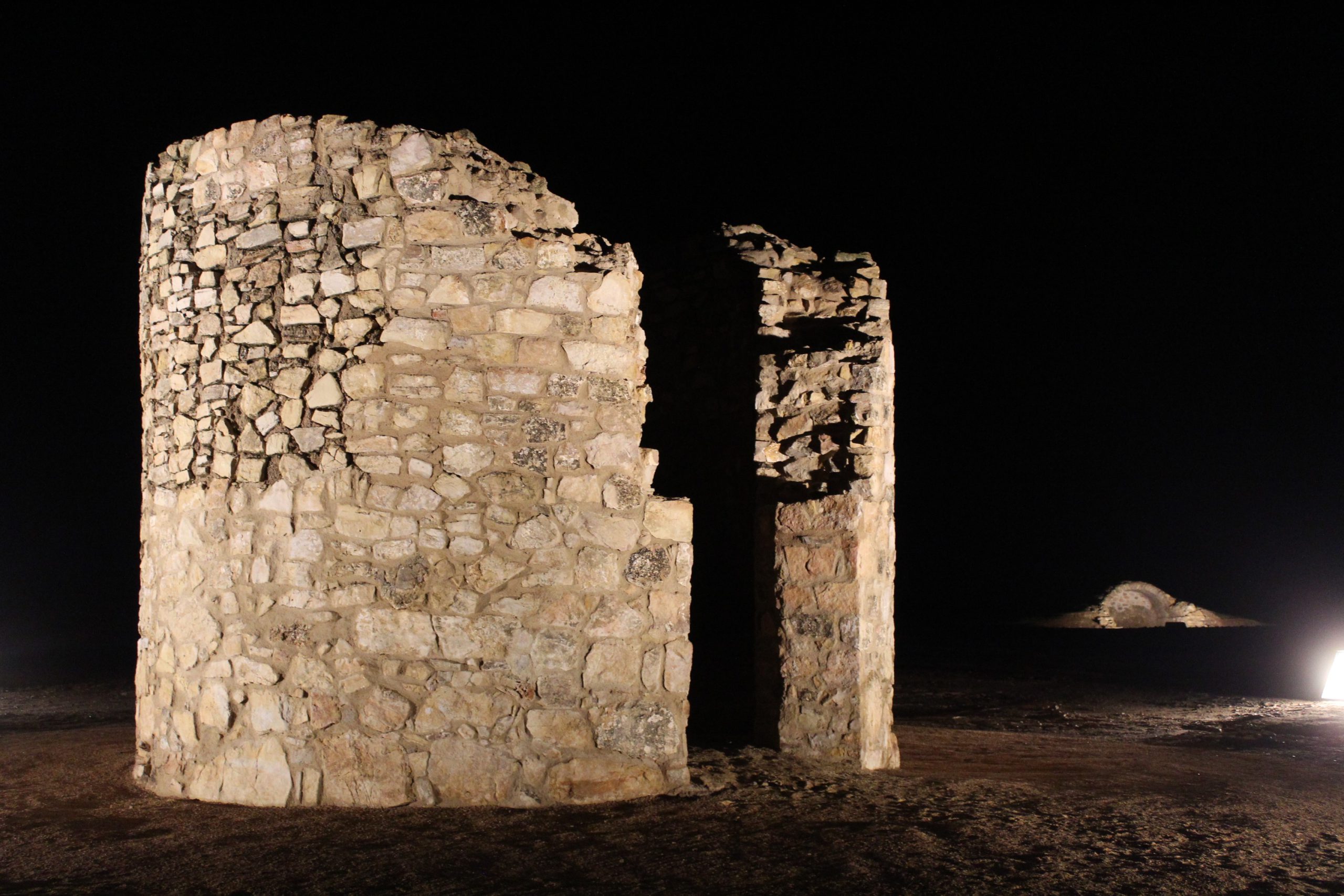
The inauguration ceremony was attended by Isabel Rodríguez, Minister of Territorial Policy and Government Spokesperson; Ana Muñoz, Deputy Minister of Culture of the Regional Government of Castilla-La Mancha; Jose Manuel Caballero, President of the Provincial Council of Ciudad Real; Santiago Lázaro, Mayor of Campo de Criptana and the President of the Iberdrola Spain Foundation, Fernando García Sánchez.
“Involving private initiative in the enhancement of our heritage, to expand our resources and promote tourism, is also one of the objectives of the Sustainability Plan,” explained the mayor of Criptana, Santiago Lazaro, at the launch of the historic mills.
For his part, Fernando García, president of Fundación Iberdrola España, added that this lighting is one more commitment of the foundation with Castilla – La Mancha to value the historical heritage of the region.
Fundación Iberdrola España has enhanced the value of the archaeological remains with this project, carrying out a uniform, medium type of lighting, respecting the environment, and reducing light pollution.
The execution of the project has involved an investment of more than 18,000 euros. This is one more commitment of Iberdrola with Castilla – La Mancha and its permanent purpose of promoting the social value of the culture and conservation of the historical-artistic heritage of the region.
Historic Marqués de la Ensenada Cadastre mills
The mill of Campo de Criptana is known as a tower mill. The drum is built with stone masonry, reducing its section in height with two levels. The exterior is plastered with lime and sand mortar and whitewashed to protect it. The circular floor plan, with a thick wall, supports a wooden structure roof, sometimes covered with zinc and in the older ones with wood, so that it can be oriented to the wind.
The cave-silo follows the guidelines of the construction of the Mill, thick rectilinear walls of lateral masonry, attached to the surrounding terrain, and a circular masonry vault supported by the lateral walls. The front enclosure is made by a rectangular wall of constant thickness where the access hole to the silo is executed, utilizing a wooden door of a leaf, sufficient for the access to manually ensile the sacks that contained the grain to be processed and also allowed the access of small horses (mules or donkeys).
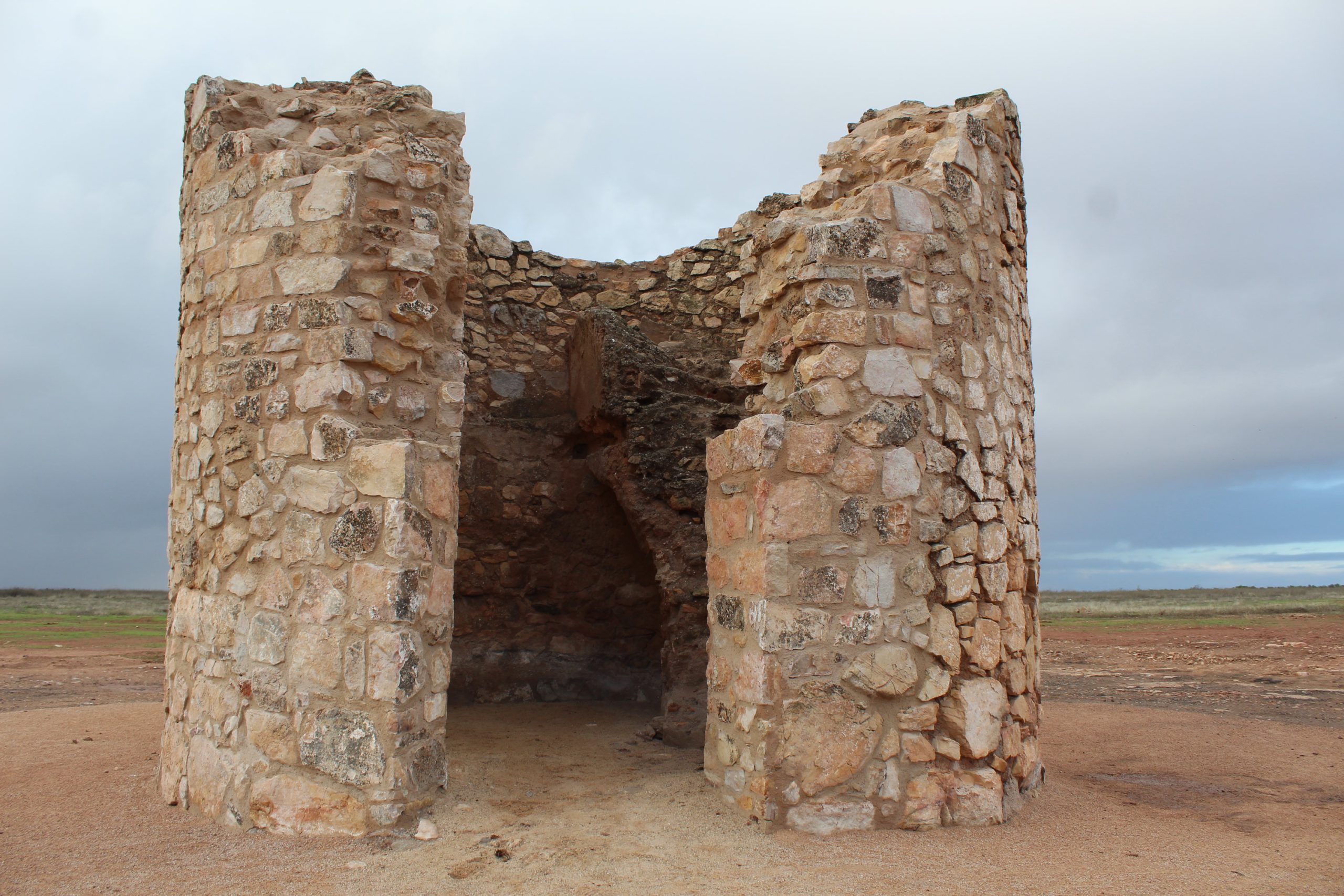
Iberdrola, with the promotion of art and culture
One of Iberdrola’s main areas of action, through its foundation in Spain, focuses on the care, conservation, and enhancement of historical and artistic wealth. The main objective of the Lighting Program is to develop interventions in unique buildings to install or improve their interior and/or exterior lighting systems to contribute to the enhancement of heritage.
Since 2011, the volume of investment allocated to the Lighting Program has amounted to more than 3 million euros and has led to improvements in more than 40 monuments in Spain, including the Cathedral of Avila, the interior of the Cathedral of Palencia and the New Cathedral of Salamanca, the historic Roman Bridge of Alcántara in Cáceres, the façade of the Congress of Deputies, the Palace of the Supreme Court in Madrid, the Cathedral of Santiago de Compostela and the Cathedral of Sigüenza.
-
- Fundación Iberdrola España collaborates with the Provincial Council of Palencia and the City Council of the town, as well as with the Diocese itself, assuming 40% of the total cost of the lighting, in this sustainable project, in which the provincial institution contributes 60% and Támara de Campos will be in charge of the maintenance of the new electrical infrastructure
The president of the Provincial Council of Palencia, Ángeles Armisén, the mayor of the Palencia town of Támara de Campos, María Concepción Gallardo, and the president of the Fundación Iberdrola España, Fernando García, inaugurated this afternoon, together with the bishop of the Diocese, Manuel Herrero, the new exterior lighting of the church of San Hipólito el Real in the Palencia town of Támara de Campos, in the presence of the director of the Fundación Iberdrola España, Ramón Castresana; the deputies of Area and Territorial Action, José Antonio Arija and Urbano Alonso; the heritage delegate of the Diocese, José Luis Calvo; the trustee of Fundación Iberdrola España, Germán Delibes, and the delegate of Iberdrola in Castilla y León, Miguel Calvo. 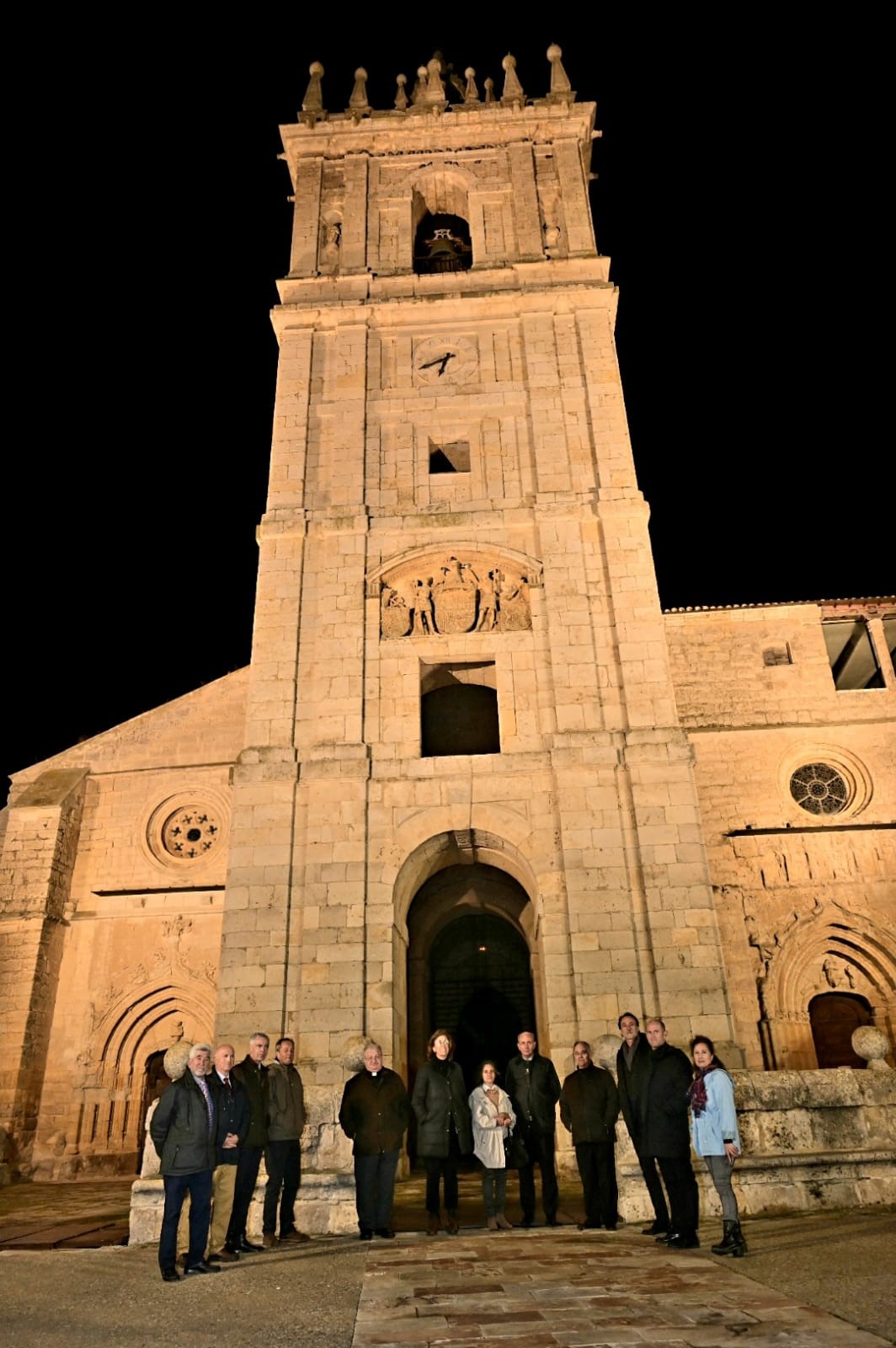
The Provincial Council of Palencia, the Town Council of Támara de Campos, and Fundación Iberdrola España have joined forces to carry out this lighting project, which will also contribute to sustainability and avoid CO2 emissions into the atmosphere. The Provincial Council has contributed 60% of the total amount of the project, the Fundación Iberdrola España contributes 40% and the Town Council of Támara de Campos will be responsible for the maintenance of the new electrical infrastructure.
Fundación Iberdrola wanted to enhance the value of the Palencia church with this innovative project. It has carried out a uniform lighting, of medium type, to avoid excess, respecting the environment and reducing light pollution.
The new lighting applies the most advanced LED technology that accentuates the beauty of the architectural elements that make up the whole through a design that respects the heritage and spiritual values of the church. The total installed power is 1580W, only 18 projectors have been necessary and ensure the sustainability of the installation over time.
The replacement and renovation of the lighting in the Church of Támara de Campos is another example of Iberdrola’s commitment to Castilla y León and of its permanent aim to promote the social value of the culture, origin, and conservation of the historical and artistic heritage of the region.
Institutional commitment to the province’s heritage
For years, the Provincial Institution has been collaborating with the Diocese of Palencia in the opening and diffusion of monuments. In this field, it is worth mentioning the Church of San Hipólito, a temple that is part of this agreement that aims to facilitate the access of tourists to these temples, which are undoubtedly a reference at a historical and artistic level.
The church of San Hipólito is a building of great proportions, built in the 14th century, in Gothic style, with Renaissance and Baroque additions. Its impressive tower stands out, in the Herrerian style, built in the 17th century after the collapse of the Gothic tower in 1568. It has been declared an Asset of Cultural Interest (BIC) since 1991 in the category of historical-artistic monument.
In addition, the temple has the presence of an Iberian organ of 45 notes that sound 26 half registers. This organ is part of the Provincial Organ School of Palencia (EPOP), an institution with which the Provincial Council of Palencia collaborates to promote an organ culture that favors the conservation of this valuable instrumental heritage in society.
During this year, up to the Easter holiday, 8,508 national and international tourists visited the church of San Hipólito.
Iberdrola, with the promotion of art and culture
One of Iberdrola’s main areas of action, through its foundation in Spain, focuses on the care, conservation, and enhancement of historical and artistic wealth.
The main objective of the Illuminations Program is to develop interventions in singular buildings to install or improve their interior and/or exterior lighting systems in order to contribute to the enhancement of their heritage.
Since 2011, the volume of investment allocated to the Illuminations Program has amounted to more than 3 million euros and has involved improvements of over 40 monuments in Spain, including the Cathedral of Avila, the interior of the Cathedral of Palencia and the New Cathedral of Salamanca, the historic Roman Bridge of Alcántara, in Cáceres, or the facade of the Congress of Deputies, the Palace of the Supreme Court, in Madrid, the Cathedral of Santiago de Compostela and the Cathedral of Sigüenza.
-
- Fundación Iberdrola España has invested 210,000 euros in this new ornamental lighting
-
- The project has improved energy efficiency by 72% and will avoid the emission of 3.2 tons of CO2 per year
Iberdrola, through its Foundation in Spain, today inaugurated the exterior ornamental lighting of the Cathedral of Sigüenza. The event was attended by the President of the Regional Government of Castilla-La Mancha, Emiliano García-Page; the CEO of Iberdrola Spain, Mario Ruiz-Tagle; the Mayor of Sigüenza, Maria Jesús Merino; the Regional Minister of Education, Culture and Sports, Rosa Ana Rodríguez; the President of the Provincial Council of Guadalajara, Jose Luis Vega Pérez and the President of the Fundación Iberdrola España Spain, Fernando García.
The Fundación Iberdrola España has enhanced the cathedral complex with this innovative project. It has carried out uniform lighting, of medium type, to avoid excess, respect the environment, and reduce light pollution.
The design has sought to obtain a “natural lighting” effect, enhancing the volumes of the architectural complex, and reducing intrusive or disturbing light. In addition, one of the most important objectives has been achieved: to offer versatility so that the new lighting can be used for different purposes: daily lighting and complete lighting for festive events, weekends, etc.
The most advanced LED technology has been used, with a very careful installation maintaining, as far as possible, the previous locations. Specifically, 150 luminaires have been installed (including projectors and linear) with a combination of warm color temperatures.
The total power installed is 6,346 W. This power corresponds to the complete lighting, while only 49 luminaires with a power of only 1.1 KW will be needed daily. The energy efficiency and savings of the project have improved by 72% and will avoid the emission of 3.2 tons of CO2 per year. All this ensures the sustainability of the installation over time.
The execution of the project has involved an expenditure of 210,000 euros. This is one more commitment of Iberdrola to Castilla – La Mancha and its permanent purpose of promoting the social value of the culture and conservation of the historical-artistic heritage of the region.
The Cathedral of Santa María de Sigüenza, Guadalajara
The cathedral complex that we see today is the result of a process of aggregations and transformations. It has a Romanesque origin, from the mid-twelfth century, and develops until the mid-eighteenth century, when it reaches its final configuration. Subsequently, it has undergone several transformations, especially due to the damage caused during the Civil War.
Thus, while the Clock Tower with a height of 40.5 meters, was built in the fourteenth century during the bishopric of Pedro Gómez Barroso, its companion, the Tower of San Pedro, was built in the sixteenth century by Bishop Don Fadrique de Portugal, with a height of 41.7 meters. The long construction process of the Cathedral (more than eight centuries), which brings together Romanesque, Gothic, Renaissance, and Baroque elements, has made it a true legacy of the past.
Fundación Iberdrola with culture
Since its creation, Iberdrola has been committed to the energy, cultural and social development of the communities in which it operates. In this regard, Fundación Iberdrola España represents a further step in this commitment by promoting initiatives that contribute to improving people’s quality of life. One of the Foundation’s main areas of action focuses on the care, maintenance, and promotion of art and culture.
This project is in addition to others that the company has carried out in Castilla-La Mancha in recent years, including the illuminations of the Monastery of Uclés, the Old Bridge of Talavera de la Reina and the Plaza Mayor of Sigüenza, among others, as well as exhibition projects such as “El Prado en las Calles” or “Un Patrimonio de todos”.
- The project, which is part of Iberdrola’s Illuminations Program, will require an investment of 75,000 euros.
- The new lighting will use the latest LED technology and highlight the most emblematic architectural elements.
Iberdrola, as part of the collaboration agreement signed with the Talavera City Council in May 2021, has developed the ornamental lighting project on the Old Bridge of Talavera de la Reina. The renovation of the bridge lighting is another example of Iberdrola’s commitment to Castilla-La Mancha, the conservation of the region’s historical and artistic heritage, and the promotion of the social value of culture.
The inauguration ceremony was presided over by Emiliano García – Page, president of the Junta de Castilla La Mancha, and was also attended by the mayoress of Talavera de la Reina, Tita García, and the president of Fundación Iberdrola España, Fernando García Sánchez.
The initiative, which is part of Iberdrola’s Illuminations Program, has involved an investment of 75,000 euros to provide the bridge with new lighting using LED technology. A very careful installation has been carried out, taking into account reversibility criteria, with the placement of 25 luminaires and total power of 3 KW.
This new lighting, which uses the latest LED technology, improves color rendering, unifies colors, minimizes light pollution, and improves maintenance. In addition, a total of four strips have been installed in the soffit of the arches of the bridge.
All this will contribute to the enhancement of the bridge, which is listed as an Asset of Cultural Interest (BIC), by highlighting the most emblematic architectural elements with a warm and soft light.
The Old Bridge of Talavera de la Reina
The Old Bridge of Talavera de la Reina is one of the most representative works of civil architecture of the city. It is located on a north-south communication axis over the Tagus River. Traditionally known as “Puente Viejo” (Old Bridge), it has served as the main access to the city through its southern sector by land until a new bridge, popularly known as “the iron bridge”, was built in 1908.
Fundación Iberdrola and culture
One of Iberdrola’s main areas of action, through its Foundation in Spain, focuses on the care, conservation, and enhancement of historical and artistic wealth. The main objective of the Lighting Program is to develop interventions in unique buildings to install or improve their interior and/or exterior ornamental lighting systems to enhance heritage.
Since 2011, the volume of investment allocated to the Lighting Program has amounted to more than 3 million euros and has led to the improvement of more than 40 monuments in Spain, including the historic Roman Bridge of Alcántara, in Cáceres; the facade of the Supreme Court, in Madrid; the Plaza Mayor of Sigüenza, or the Monastery of Guadalupe.
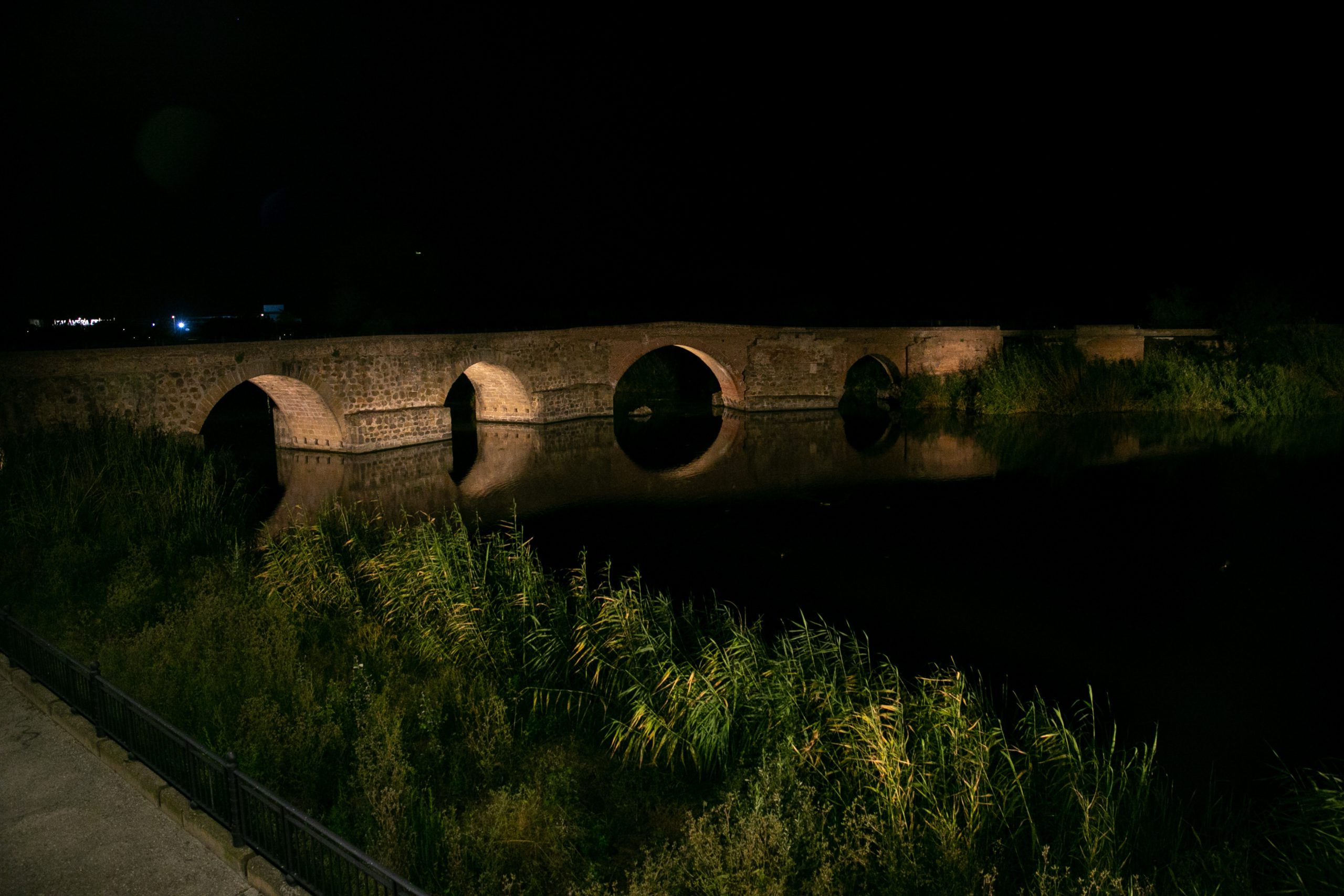
- In his speech, Ignacio Galán highlighted Santiago as the nerve center of artistic and cultural movements since the early Middle Ages. “We are carrying out this action in the most universal of Galicia’s monuments, with the same enthusiasm and commitment with which we are committed to this land, which is ours, promoting energy transition, industrial development and job creation”.
- The action carried out by the company includes the installation of 700 luminaires -which improve energy efficiency by 61% and avoid the emission of 6.7 t of CO2/year- and 36 lamps designed exclusively, inspired by the old votive lamps.
Iberdrola has been committed to Galicia for decades: it is the leading renewable energy company in the region – it operates more than 2,000 MW of green power – and has made this community an industrial benchmark for offshore wind power, with the participation of local suppliers in the projects it develops around the world.
The Cathedral of Santiago de Compostela has unveiled its interior lighting today, following the culmination of a project developed over the last two years by Iberdrola – through its Foundation in Spain – and the Cathedral Chapter, with the aim of revitalizing the temple in the Jubilee Year of Compostela and providing it with a light that respects both the history and the current reality of the monument.
The inauguration ceremony of the new lighting, held this afternoon, was attended by the president of the Xunta de Galicia, Alberto Núñez Feijóo; the president of Iberdrola, Ignacio Galán; the archbishop of Santiago de Compostela, Julián Barrio Barrio; the dean president of the Cathedral, José Fernández Lago; and the canon director of the Cathedral Foundation, Daniel C. Lorenzo Santos, among other authorities.
In his speech, Ignacio Galán emphasized that it is “a real honor for Iberdrola to have contributed, once again, to the conservation of this temple, which we have carried out with the same emotion as so many thousands of devotees when they arrive in Santiago, the destination of all the major pilgrimage routes of Christianity and the nerve center of so many artistic and cultural movements since the early Middle Ages”. He also added that “we are carrying out this action in the most universal of Galicia’s monuments, with the same enthusiasm and the same commitment with which we are committed to this land, which is ours, promoting energy transition, industrial development and the generation of sustainable and quality employment”.
The interior lighting of Santiago is part of Iberdrola’s Illuminations Program and is in addition to other collaborations developed in the Cathedral of Santiago since 2004 by the company, with the lighting of the Holy Door, or the total renovation of the lighting in 2015, along with the control and electrical installations, of the Main Chapel and the Sepulchre of the Apostle.
Combining the history and the current reality of the temple.
The interior lighting works of the Cathedral of Santiago have included the installation of 700 luminaires, with a total power of 15.8 kW, which allow a renewed lighting of different elements of the temple, such as the naves, the transept, the ambulatory, the triforium and the Pórtico de la Gloria. With this action, energy efficiency has been improved by 61% with respect to the previous lighting, and the emission into the atmosphere of 6.7 tons of CO2 per year will be avoided.
Among other elements, the project has exclusively designed 36 new lamps inspired by the old votive lamps of the Cathedral which, suspended in the central nave and transepts, recover the lighting of the time when the temple was illuminated with candles. Equipped with the latest lighting technology, they have 12 LED emitters each and are powered directly from the cables that anchor them to the ceiling and keep them suspended.
The installation of the new lamps, managed from a control system together with other lighting components, helps to create different scenes depending on the time of visit: without worship, with ordinary worship or solemn worship.
After several years of studies by experts and in coordination with the rest of the restoration work being carried out in the Cathedral, the natural light of the basilica during the day has been evaluated to design a scheme of artificial light that is superimposed as a different visual layer, avoiding the classic lighting of vaults.
The light in the Cathedral has traditionally been expressed on two different levels. On the one hand, artificial light, on a plane more or less close to the ground for reasons of available technology and maintenance, with warm color temperatures and deployed through solutions such as candle lanterns, candlesticks, candle holders, votive lamps, etc. On the other hand, natural light has been the protagonist of the higher sections. An abundant light and cold color temperatures.
The current project relies on this duality to generate an attractive visual experience for visitors and worshippers. The sequence of suspended lamps in contrast to the natural light provided by the rose windows and the dome allows for a narrative that respects both the history and the current reality of the church.
Energy transition, industrial development and sustainable, quality employment.
Iberdrola has been operating for decades in Galicia, a region where it has consolidated its position as the leading renewable energy company, managing more than 2,000 MW of green power, and where it continues to promote the energy transition and, with it, industrial development and the generation of sustainable and quality employment.
The socio-economic impact of its activity in the region exceeds 400 million euros per year between investments, purchases, salaries and tax contributions.
The company’s commitment to future technologies has also made Galicia an industrial benchmark in offshore wind power, with the participation of local suppliers in the projects it is developing around the world. This is the case of the Wikinger offshore wind farm, which Iberdrola operates in the German Baltic Sea, whose foundations were manufactured in Fene/Navantia; and, more recently, the contracts for Saint Brieuc, which will contribute to the construction of this offshore wind farm in Brittany, France; and the agreements for the manufacture of components for future offshore wind farms.
Enhancing the value of historical and artistic heritage in Spain.
Through its Foundation in Spain, Iberdrola dedicates a significant part of its actions to promoting the social value of culture and the enhancement of the country’s artistic wealth.
Since 2011, and with an investment of 12.6 million euros, it has been developing two main lines of work: the Restorations Program, for the conservation of pictorial and artistic heritage; and the Illuminations Program, focused on the care, conservation and enhancement of historical-artistic wealth.
The main objective of the Illuminations Program is to develop interventions in unique buildings to install or improve their interior and/or exterior lighting systems in order to contribute to the enhancement of the historical and artistic heritage.
Since 2011, the actions carried out in this area have led to the improvement of more than 40 monuments in Spain, including the historic Roman Bridge of Alcántara, in Cáceres; the façade of the Congress of Deputies, in Madrid; the Cathedral of Ávila, and the interior of the New Cathedral of Salamanca. Another unique initiative is the Illuminating the Prado program, a comprehensive lighting project for the Prado Museum using LED technology that is a pioneer and a benchmark in Europe.
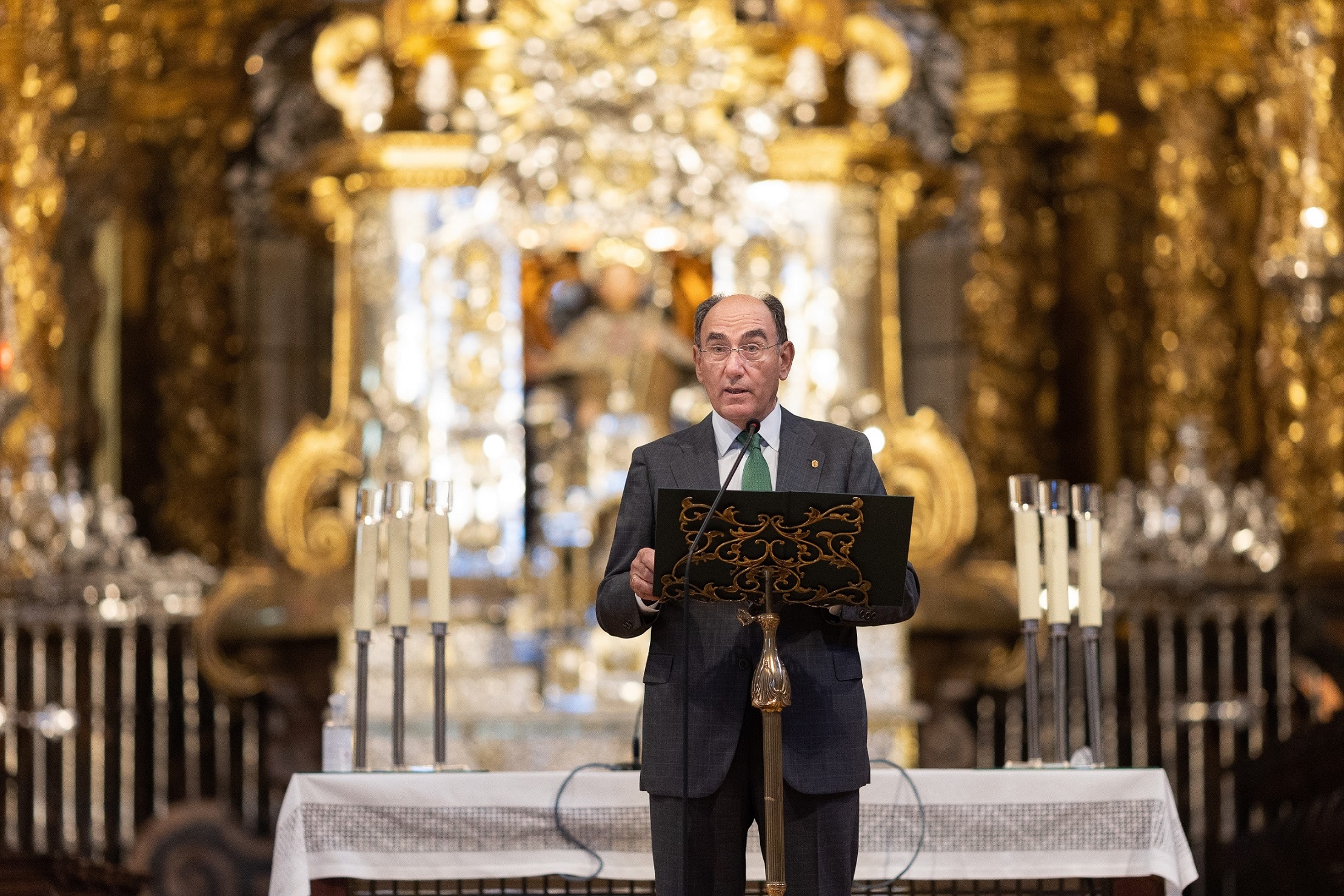
- The project, which is part of Iberdrola’s Illuminations Program, will require an investment of approximately 130,000 euros.
- The new lighting will use LED technology and will enhance the volumes of the architectural ensemble.
Iberdrola, as part of the collaboration agreement signed with the Sigüenza City Council in July 2020, has developed the ornamental lighting project for the town’s Plaza Mayor. The renovation of the lighting of the Plaza Mayor is another example of Iberdrola’s commitment to Castilla-La Mancha, the conservation of the historical and artistic heritage of the region and the promotion of the social value of culture.
The opening ceremony was presided over by Emiliano García – Page, president of the Junta de Castilla La Mancha, and was also attended by the mayoress of Sigüenza; María Jesús Merino; the president of the Provincial Council of Guadalajara, Jose Luis Vega Pérez; the president of the Cortes de Castilla-La Mancha, Pablo Bellido Acevedo and the president of Fundación Iberdrola España, Fernando García Sánchez.
The initiative, which is part of Iberdrola’s Illuminations Program, has involved an investment of 130,000 euros to provide the square with new lighting using LED technology. A very careful installation has been carried out, taking into account reversibility criteria, with the placement of 141 luminaires and a total power of 3.2 KW.
The new lighting will enhance the volumes of the architectural ensemble while controlling the luminous glare at night, reducing intrusive or disturbing light. In addition, different lighting levels have been designed to respond to the different uses of the Plaza.
The initiative enhances the Plaza Mayor as an element in itself and in relation to the unique buildings that delimit it, the Town Hall and the Cathedral.
The mayor of Sigüenza, María Jesús Merino, stressed that “in the midst of the darkness of the pandemic, it is projects such as our IX Centenary or the World Heritage Candidacy that have kept our spirits high. The fact that today the lights of our Plaza Mayor are turned on and illuminated in such a spectacular way is, without a doubt, the materialization of this collective dream. And I would also dare to say that it is the symbol of the optimism with which we face the end of this time”.
In his speech, Fernando García, president of Fundación Iberdrola España explained that “with the illuminations program we want to attract citizens to see, look and observe the square. The philosophy of Fundación Iberdrola España with these actions is to transmit the soul of the historical heritage and the people who inhabit it”.
During his speech, García-Page thanked Iberdrola for its close collaboration with Castilla-La Mancha “because it is always betting on this land”. In this regard, he highlighted the cultural projects that the Iberdrola Foundation has underway in the region, such as the lighting of the Cathedral of Sigüenza, a project that will be a continuation of the one inaugurated yesterday.
The Main Square of Sigüenza
The Plaza Mayor is located in the historic center of Sigüenza, of rectangular structure, is bordered at its southern end by the Town Hall and at the northern end by the Cathedral of Santa Maria. It has its origin in the sixteenth century and was ordered by Cardinal Mendoza. It is a magnificent example of Renaissance urbanism in which stands out its porticoed gallery that runs from the Palacio de los Deanes, now the City Hall, to the Puerta del Toril.
Fundación Iberdrola with culture
One of Iberdrola’s main areas of action, through its Foundation in Spain, focuses on the care, conservation and enhancement of historical and artistic wealth. The main objective of the Lighting Program is to develop interventions in unique buildings to install or improve their interior and/or exterior ornamental lighting systems in order to contribute to the enhancement of heritage.
Since 2011, the volume of investment allocated to the Lighting Program has amounted to more than 3 million euros and has led to the improvement of more than 40 monuments in Spain, including the historic Roman Bridge of Alcántara, in Cáceres; the façade of the Congress of Deputies, in Madrid; the Cathedral of Ávila, or the interior of the New Cathedral of Salamanca.
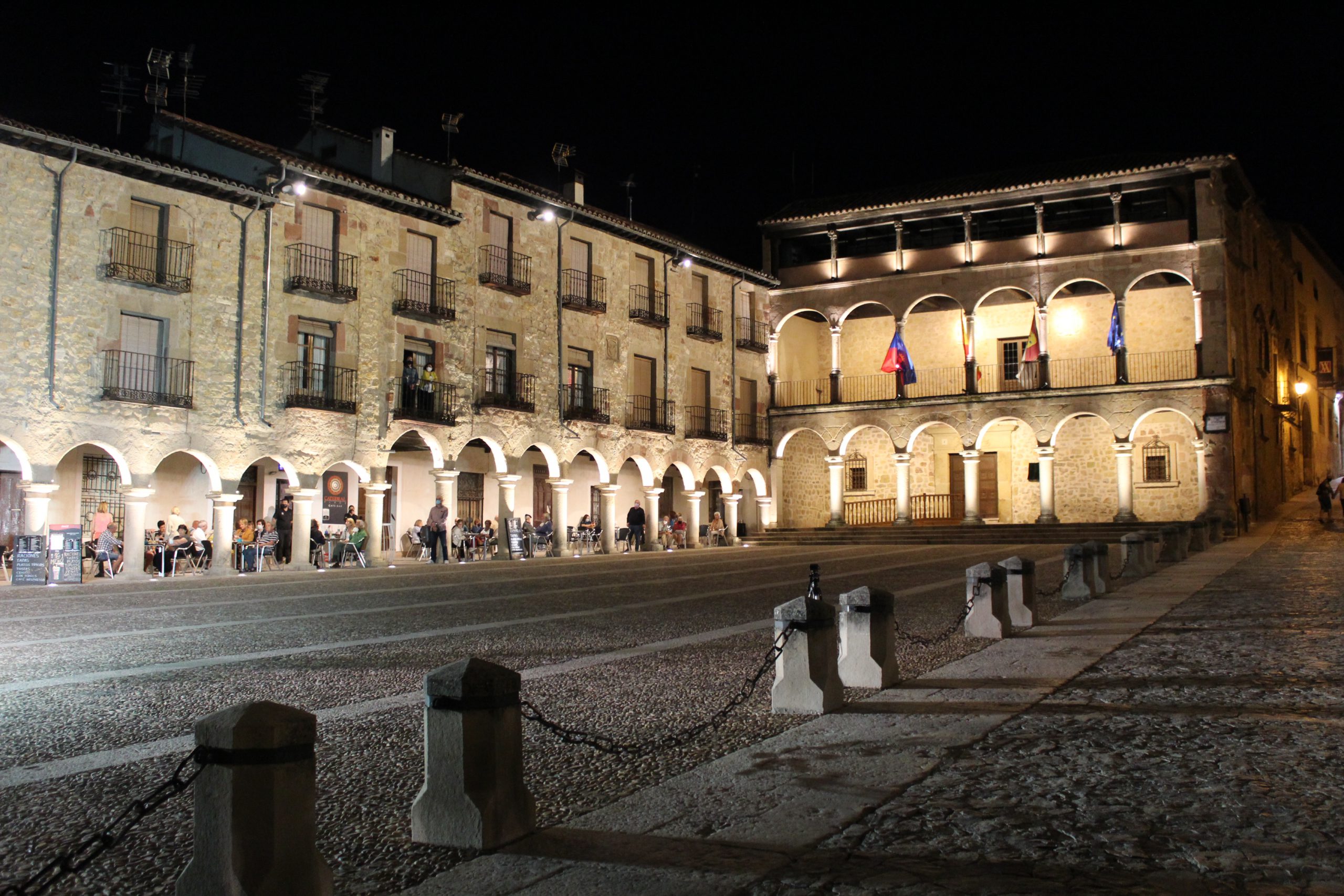
- These lamps are designed and manufactured exclusively for the central nave and transepts.
- The lamps are powered from their own cables that keep them suspended from the ceiling.
- Inspired by votive lamps, they seem to “float” inside the Cathedral.
- They recover the historical light plane corresponding to the time when the Temple was illuminated by candles.
- These lamps incorporate the latest lighting technology with 12 LED emitters each.
The lighting works continue after finishing this part of the project following the specifications of the Cathedral’s Master Plan. The aim is to renew the interior lighting of the monument, highlighting the distinctive elements of the naves, transept, ambulatory, triforium and Portico de la Gloria. For the development of this initiative, the Iberdrola Spain Foundation will contribute 800,000 euros.
The project was born after several years of previous studies and reflections by experts and is developed in coordination with all the restoration works being carried out in the Cathedral, in order to ensure their compatibility. In this sense, the natural light of the basilica during the day has been evaluated and, based on this reality, progress has been made in the construction of a criterion for the light in the night scene. This means that the artificial light will not try to compensate or replace natural light, but will be understood as a different visual layer, with levels typical of night light, at warm color temperatures, avoiding the classic lighting of vaults.
The suspended lamps that have just been installed in the Cathedral are inspired by the old votive lamps in the Cathedral, although in this case the lighting is directed towards the floor. Located in the central nave and the transepts, they incorporate the latest technology in lighting with 12 LED emitters each, which in addition to offering a different lighting provides them with great energy efficiency. This light will be the protagonist of the space, as these lamps have been designed exclusively for the Cathedral.
The project was born after several years of previous studies and reflections by experts and is developed in coordination with all the restoration work being carried out in the Cathedral, so as to ensure their compatibility. In this sense, the natural light of the basilica during the day has been evaluated and, based on this reality, progress has been made in the construction of a criterion for the light in the night scene. This means that the artificial light will not try to compensate or replace natural light, but will be understood as a different visual layer, with levels proper to night light, at warm color temperatures, avoiding the classic lighting of vaults.
In addition, from the point of view of use, we will work to make compatible a use of light that, on the one hand, allows to describe the architecture of the monument and, on the other hand, to create an atmosphere of meditation in accordance with the meaning of the temple. Thus, the project sets the guidelines for the implementation of an advanced control system that will make it possible to create different scenes and regulate the lighting levels individually in each of the points, according to the times of visit without worship, ordinary worship and solemn worship.
In short, it is a question of arranging a narrative according to a criterion that is compatible with the history and reality of the Cathedral itself. This “light of the Cathedral” has always been expressed on two very different planes: traditionally, artificial light colonized a plane more or less close to the ground, for reasons of available technology and maintenance, always with warm color temperatures and low levels, and deployed through multiple solutions (candle lanterns for offerings, candlesticks on the consecration crosses, votive lamps, such as those of the angels of the ambulatory that the project proposes to recover).
For its part, natural light is the main protagonist of the higher sections, an abundant light and cold color temperatures, which enhances with its presence the technical and symbolic effort involved in the amazing elevation of the medieval naves, and that, during the night, it is its absence that associates the vast expanse of space in the upper part to the mystery, to the unfathomable. This interesting duality is a narrative on which the project is also based, providing a very significant visual experience for visitors and the faithful.
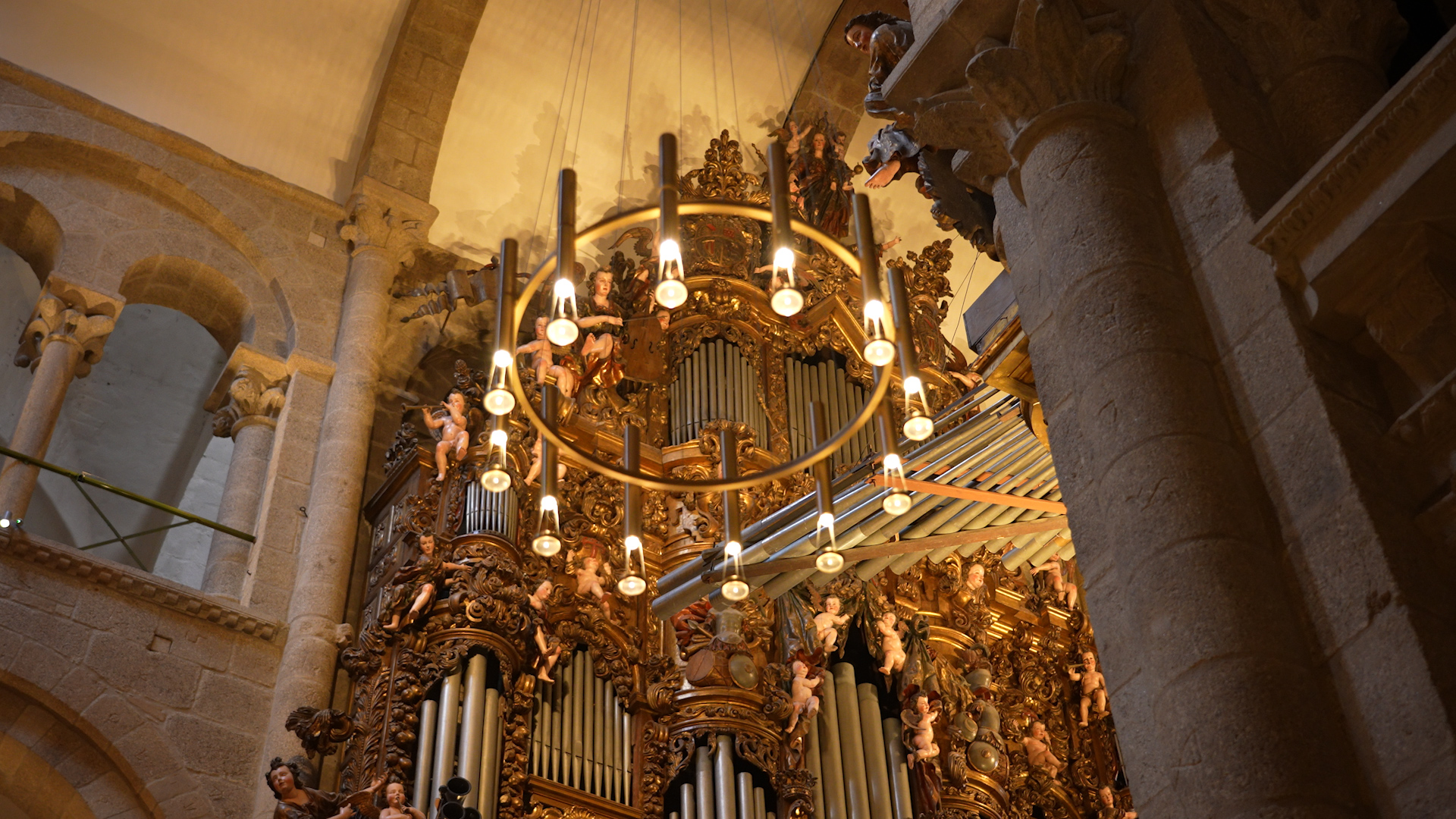
- The Bishop of Palencia, Manuel Herrero; the Mayor of the city, Mario Simón Martín; the Director of the Iberdrola Spain Foundation, Ramón Castresana; the Minister of Culture and Tourism of the Regional Government of Castile and León, Javier Ortega; the Dean-President of the Chapter, Ángel de la Torre; the Iberdrola delegate in Castile and León, Miguel Calvo, and the diocesan delegate for heritage and canon of the Chapter, José Luis Calvo, attended the first switch-on.
- The project, which has been supported by local companies, highlights the beauty of the architectural elements that make up the complex and, by applying the most advanced LED technology, contributes to sustainability by improving energy efficiency by almost 55% and avoiding the emission of 3.5 tonnes of CO2 per year.
The interior of Palencia Cathedral now has new lighting after the completion of the project developed by Iberdrola, which has had the support of Palencia companies, and which has filled with light one of the greatest symbols of the city – declared a National Monument in 1929 -, highlighting and enhancing the architectural ensemble and modernising its ornamental lighting.
The inauguration of the new lighting was attended by the Bishop of Palencia, Manuel Herrero; the Mayor of the city, Mario Simón Martín; the Director of the Iberdrola Spain Foundation, Ramón Castresana; the Regional Minister of Culture and Tourism of the Castilla y León Regional Government, Javier Ortega; the Dean-President of the Chapter, Ángel de la Torre; the Iberdrola delegate in Castilla y León, Miguel Calvo, and the diocesan delegate for heritage and canon of the Chapter, José Luis Calvo.
The work carried out over the last four months highlights the beauty of the architectural elements that make up the complex through a design that respects the heritage and spiritual values of the building by applying the most advanced LED technology with the installation of a total of 239 spotlights of different types with a power of only 9.6 kW.
The project also contributes to sustainability by improving energy efficiency by almost 55% and avoiding the emission of 3.5 tonnes of CO2 per year.
The new interior ornamental lighting has focused on the vaults of the central and lateral nave, the choir stalls, the choir, the High Altarpiece and the Chapel of the Sagrario. In addition, special treatment has been given to the new lighting of the crypt by fitting it with luminaires embedded in alabaster cylinders that have been designed expressly for this project.
This artistic lighting enhances the intrinsic meaning of the cathedral’s architecture through light and complements the functional lighting that is maintained in the church. It is also flexible and versatile enough to programme different levels of lighting for worship and for tourist visits.
Iberdrola, with the promotion of art and culture
One of Iberdrola’s main areas of action, through its foundation in Spain, focuses on the care, conservation and enhancement of historical and artistic wealth. The main objective of the Lighting Programme is to develop interventions in unique buildings to install or improve their interior and/or exterior lighting systems in order to contribute to the enhancement of historical and artistic heritage.
Since 2011, the volume of investment allocated to the Lighting Programme has amounted to more than 3 million euros and has led to the improvement of more than 40 monuments in Spain, including the Cathedral of Ávila, the interior of the New Cathedral of Salamanca, the historic Roman Bridge of Alcántara in Cáceres, and the façade of the Congress of Deputies and the Palace of the Supreme Court in Madrid.
About Iberdrola
Iberdrola is a global energy leader, the world’s largest wind power producer and one of the largest electricity companies by market capitalisation in the world. The group supplies energy to close to 100 million people in dozens of countries such as Spain, the United Kingdom (ScottishPower), the United States (AVANGRID), Brazil (Neoenergia), Mexico, Germany, Portugal, Italy and France. With a workforce of more than 35,000 people and assets of more than 122 billion euros, it had a turnover of 36,438 million euros and a net profit of 3,406 million euros in 2019. Iberdrola is leading the energy transition towards a sustainable model through its investments in renewable energies, smart grids, large-scale energy storage and digital transformation to offer the most advanced products and services to its customers. Thanks to its commitment to clean energy, it is one of the companies with the lowest emissions and an international benchmark for its contribution to the fight against climate change and sustainability.
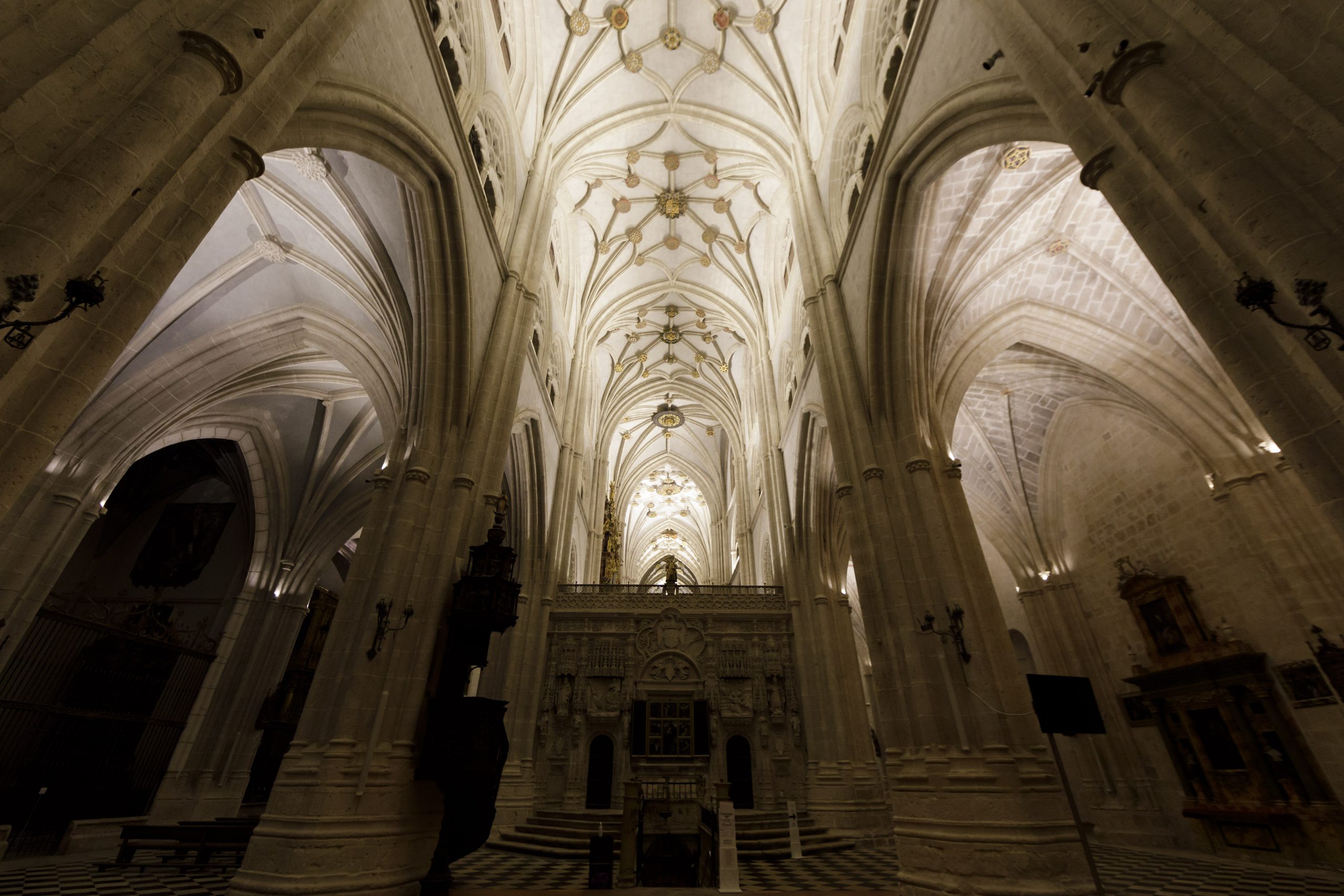
- The Supreme Court and Fundación Iberdrola España have inaugurated the exterior ornamental lighting of the Plaza Villa de París and Marqués de la Ensenada gates of this emblematic Madrid building at an institutional event held this afternoon.
- Fundación Iberdrola has designed and executed the lighting project using the most advanced LED technology, which seeks to improve the building’s energy efficiency.
Madrid. Iberdrola, through its Foundation in Spain, today inaugurated the exterior ornamental lighting of the main façades of the Supreme Court Palace in Madrid. The event was attended by the President of the Supreme Court and the General Council of the Judiciary, Carlos Lesmes, the Minister of Justice, Juan Carlos Campo, and the President of Fundación Iberdrola España, Fernando García.
With this innovative lighting project, the Iberdrola Foundation has highlighted and highlighted the central bodies of each of the facades of the Supreme Court, placing them as a reference axis in each of the environments: Plaza Villa de París and Calle Marqués de la Ensenada, leaving the rest of the building’s walls unlit. This solution seeks to minimise the invasion of light from the building into the rest of the urban environment.
The design has sought to obtain a “natural lighting” effect, which has been achieved by combining uniform vertical lighting starting from the ground, but limiting its height, thus leaving the lower face of the cornices in shadow; in this way, horizontal strips of descending shadow are generated, reminiscent of those produced by sunlight.
Power-adjustable spotlights have been used to achieve uniform lighting with a neutral white colour temperature. More than 70 floodlights and more than 130 metres of flexible LED strips have been installed, with a total power of only 4.3 KW, which guarantees its sustainability over time.
The project, which required more than 180,000 euros, is part of one of the main areas of activity of the Iberdrola Spain Foundation: cultural development and conservation of historical and artistic heritage.
About the Supreme Court Palace in Madrid
The complex was created on the initiative of Queen Bárbara de Braganza to install the nuns of the Visitation order in Spain, with the intention that, in addition to the convent, a school for noble girls would be established. The institution remained in this location until 1870, when the nuns were expelled and the convent was converted into the Palace of Justice. The building suffered two serious fires, the worst of them in 1915, which barely affected the church, but almost completely destroyed the Palace. In 1926, the reconstruction project began, with the aim of building a real courthouse with a national character, in line with those existing in the rest of Europe.
Iberdrola, with the promotion of art and culture
One of Iberdrola’s main areas of action, through its Foundation in Spain, focuses on the care, conservation and enhancement of historical and artistic wealth. The main objective of the Lighting Programme is to develop interventions in unique buildings to install or improve their interior and/or exterior ornamental lighting systems in order to contribute to the enhancement of heritage.
Since 2011, the volume of investment allocated to the Lighting Programme has amounted to more than 3 million euros and has led to the improvement of more than 40 monuments in Spain, including the historic Roman Bridge of Alcántara, in Cáceres; the façade of the Congress of Deputies, in Madrid; the Cathedral of Ávila, or the interior of the New Cathedral of Salamanca.
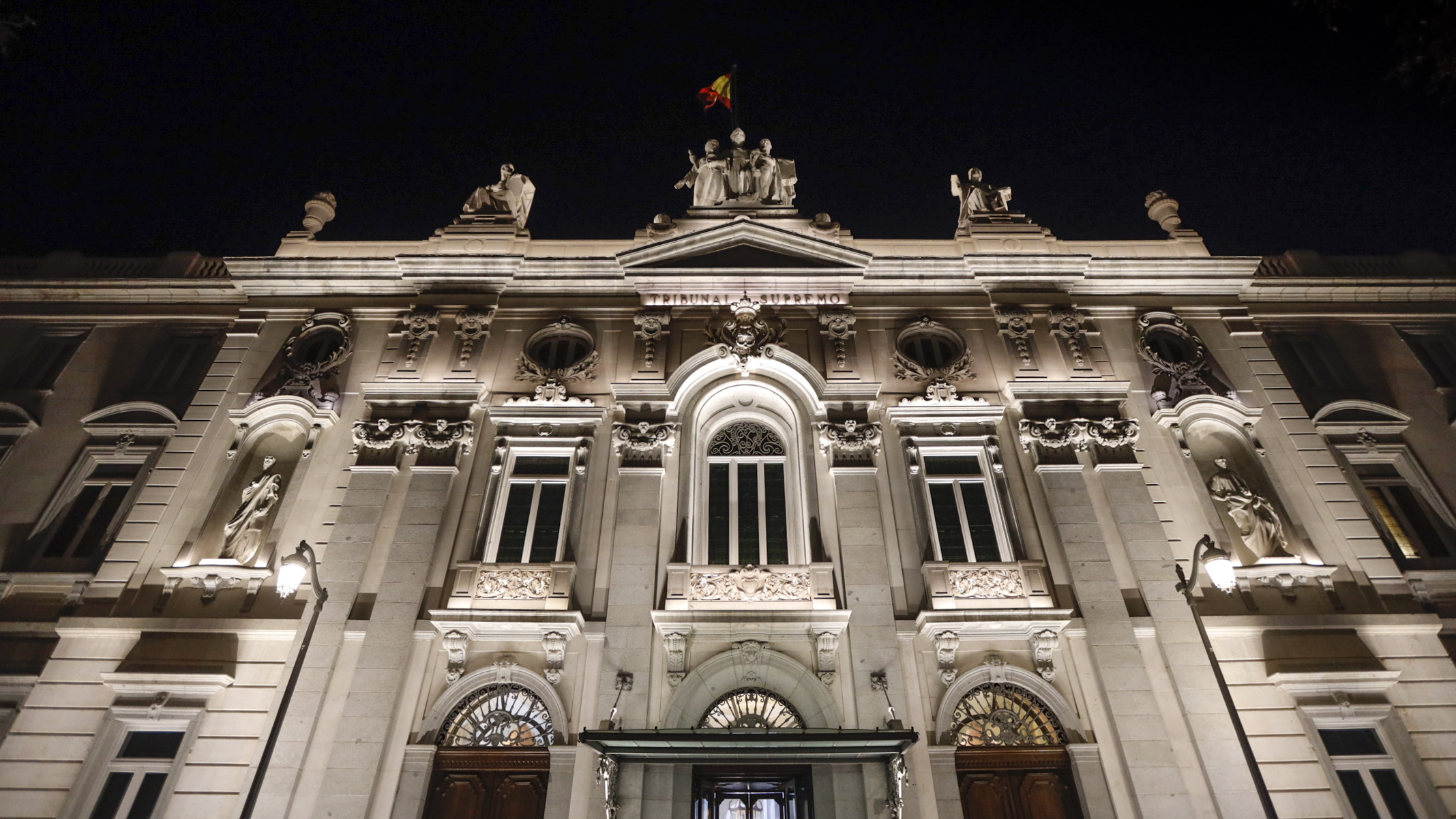
- This century-old church, closed to worship since 1985, has undergone a complete refurbishment, including its structure and interior ornamental lighting.
- A total of 68 luminaires with a total power of only 1,700 W have been installed.
Valdepeñas (Ciudad Real). Valdepeñas Town Council, the Ministry of Public Works, the Fundación Iberdrola España, together with the parishioners of the Santo Cristo de Valdepeñas Parish Church (Ciudad Real), have inaugurated the refurbishment of this church, located in the municipality of Valdepeñas in the province of Ciudad Real.
The public-private partnership has made possible the comprehensive recovery of the Santo Cristo church, after a complete refurbishment work was carried out over the last nine years (2011-2020).
The inauguration of the opening of the Santo Cristo de la Misericordia Church in Valdepeñas was attended by the president of the Iberdrola España Foundation, Mr Fernando García Sánchez, the parish priest of the church, Mr Emilio Jesús Montes Romero, the mayor of Valdepeñas, Mr Jesús Martín Rodríguez, and the sub-delegate of the government, Ms Ángeles Herreros Ramírez.
Iberdrola, through its foundation, has completed the refurbishment with the design and execution of the interior ornamental lighting of the church, highlighting the starting line of the central and lateral vaults as well as the central dome, highlighting the Latin cross composition of the church and its main decorative motifs, as well as highlighting unique elements such as the main altarpiece, altar and side chapel altarpieces with accent lighting. To this end, 68 luminaires have been installed (including spotlights and linear lights) with a total power of only 1,700W. The design of the project combines aesthetics and energy efficiency, making the use of the temple for religious worship and tourism compatible.
The project, which cost around 50,000 euros, is part of one of the main areas of activity of the Iberdrola Spain Foundation: cultural development and the conservation of historical and artistic heritage.
Iberdrola, with the promotion of art and culture
One of Iberdrola’s main areas of action, through its foundation in Spain, focuses on the care, conservation and enhancement of historical and artistic wealth. The main objective of the Lighting Programme is to develop interventions in unique buildings to install or improve their interior and/or exterior lighting systems in order to contribute to the enhancement of historical and artistic heritage.
Since 2011, the volume of investment allocated to the Lighting Programme has amounted to more than 3 million euros and has led to the improvement of more than 40 monuments in Spain, including the historic Roman Bridge of Alcántara in Cáceres, the façade of the Congress of Deputies in Madrid, the Cathedral of Ávila, and the interior of the New Cathedral of Salamanca.
About the Church of Santo Cristo de la Misericordia in Valdepeñas.
It has been declared an Asset of Cultural Interest (BIC) since 1982, and its architectural style is that which predominated in the 16th century: Latin cross, with a single transept and central dome. The exterior alternates between tiled or rough brickwork, with mortar decorating the ordinary masonry walls.
The Santo Cristo de Valdepeñas Parish Church was closed to public worship on 8 April 1984, and its deterioration gradually increased after that date.
The first works began in 1995 with the restoration of the façade through a Workshop School carried out by the Consistory. Later, in 2011, at the proposal of the parish and its newly arrived parish priest, the project for the restoration of the roof, spire, construction of the sacristy, annexes and excavation in the old cemetery and interior restoration of walls, plasterwork and heating and lighting installations began under the direction of the Alia-Coronado Architecture Studio.
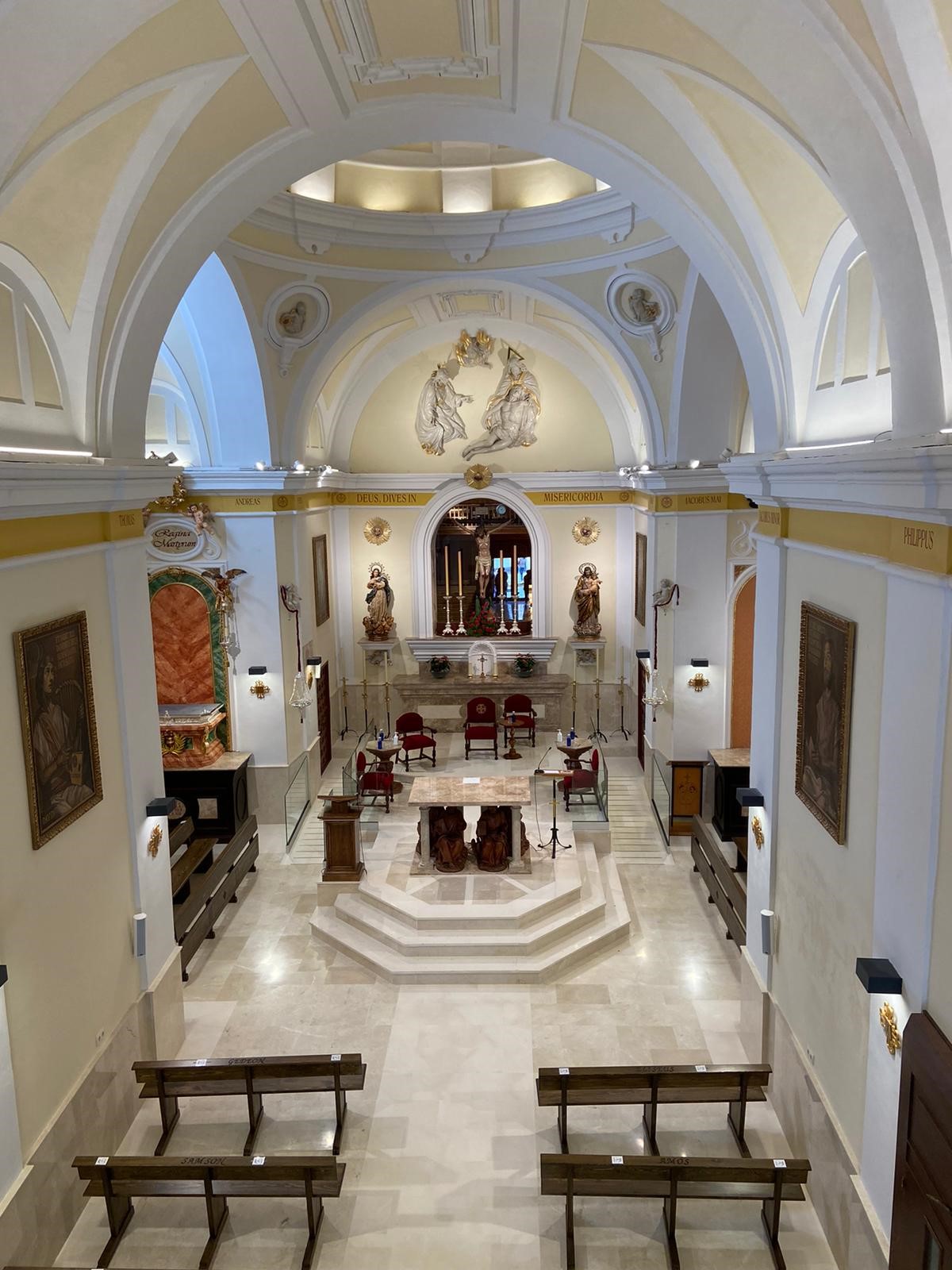
- At the inauguration, the company’s president, Ignacio Galán, explained that “the work of preserving our historical and artistic heritage allows us to disseminate our origins and our culture and promote quality tourism, which is key to the economic recovery of the region”.
- The project manages to enhance the volumes of the architectural ensemble, highlight its heights and depths and contribute to sustainability by improving energy efficiency by 60% and avoiding the emission of 5.3 t CO2 per year.
- Through its Foundation’s Lighting Programme, the company has worked on more than 40 monuments in Spain, including the Puente Románico de Alcántara, the Congreso de los Diputados, the Cathedral of Ávila and the New Cathedral of Salamanca.
The Royal Monastery of Santa María de Guadalupe now has new lighting, following the completion of the project developed by Iberdrola, aimed at revitalising one of the greatest architectural symbols of Extremadura – declared a World Heritage Site by UNESCO in 1993 – by enhancing and enhancing the silhouette of the Monastery and modernising its exterior ornamental lighting.
The inauguration of the new lighting of the Royal Monastery of Santa María tonight was attended by the President of Iberdrola, Ignacio Galán, accompanied by the President of the Regional Government of Extremadura, Guillermo Fernández Vara; the Minister Provincial of the Franciscan Province of the Immaculate Conception, Fr Juan Carlos Moya; and the Mayor of Guadalupe, Felipe Sánchez Barba.
In his speech, Ignacio Galán explained that “this work to conserve our historical and artistic heritage allows us to contribute to disseminating our origins and our culture and to promote quality tourism, which will be key to the economic recovery of regions such as the one in which we find ourselves”.
He also added that “promoting economic and social development is a responsibility and a commitment for us, with which we create sustainable value in all the regions in which we are present”.
The work carried out by Iberdrola over the last four months has managed to enhance the volumes of the architectural complex – with Gothic, Mudejar, Renaissance, Baroque and Neoclassical styles – and to enhance its heights and depths, after reinforcing the upper bodies of the monastery: towers, main façade with its crests and dome.
The project also contributes to sustainability, improving energy efficiency by 60% and avoiding the emission of 5.3 t CO2 per year.
The lighting combines the use of the most advanced LED technology with careful installation and control of night-time light glare. The lighting perimeter of the Monastery has also been extended with the installation of 197 floodlights.
The action is part of the Commemorative Programme for the 25th Anniversary of the declaration of the Royal Monastery as a World Heritage Site.
Committed to creating value in communities
The project is part of Iberdrola’s commitment to creating value in the communities where it operates, such as Extremadura, which has become the centre of its renewable development strategy in Spain, where it will develop 2,000 MW of renewable energy by 2022.
Following the commissioning of Europe’s largest photovoltaic plant, Núñez de Balboa, Iberdrola will in the coming months build seven renewable projects in the region, with a total capacity of 728 MW. It also has the Francisco Pizarro plant (590 MW) in the pipeline. These projects will entail an investment of more than 1.5 billion euros and the creation of thousands of jobs in the region.
In Extremadura, the company already manages a dozen energy facilities, with an installed capacity of 3,600 MW, and has more than 12,000 km of power lines, serving more than 350,000 customers.
Iberdrola is the leader in renewable energy in Spain, with an installed wind power capacity of more than 6,000 MW and more than 16,600 MW of renewable energy; a volume that in the world amounts to 32,700 MW, making its generation park one of the cleanest in the energy sector.
Iberdrola, with the promotion of art and culture
One of Iberdrola’s main areas of action, through its foundation in Spain, focuses on the care, conservation and enhancement of historical and artistic wealth. The main objective of the Lighting Programme is to develop interventions in unique buildings to install or improve their interior and/or exterior lighting systems in order to contribute to the enhancement of historical and artistic heritage.
Since 2011, the volume of investment allocated to the Lighting Programme has amounted to more than 3 million euros and has led to the improvement of more than 40 monuments in Spain, including the historic Roman Bridge of Alcántara, in Cáceres; the façade of the Congress of Deputies in Madrid; the Cathedral of Ávila, or the interior of the New Cathedral of Salamanca.
About Iberdrola
Iberdrola is a global energy leader, the world’s largest wind power producer and one of the largest electricity companies by market capitalisation in the world. The group supplies energy to close to 100 million people in dozens of countries such as Spain, the United Kingdom (ScottishPower), the United States (AVANGRID), Brazil (Neoenergia), Mexico, Germany, Portugal, Italy and France. With a workforce of more than 35,000 people and assets of more than 122 billion euros, it had a turnover of 36,438 million euros and a net profit of 3,406 million euros in 2019. Iberdrola is leading the energy transition towards a sustainable model through its investments in renewable energies, smart grids, large-scale energy storage and digital transformation to offer the most advanced products and services to its customers. Thanks to its commitment to clean energy, it is one of the companies with the lowest emissions and an international benchmark for its contribution to the fight against climate change and sustainability.

As part of the company’s commitment to the enhancement of historical-artistic heritage in its areas of operation
Fundación Iberdrola España renews the exterior ornamental lighting of the Basílica de Nuestra Señora del Prado in Talavera
- The event was attended by the Group Chairman, Ignacio Galán; the President of the Castilla-La Mancha Regional Parliament, Emiliano García-Page; and the Mayor of Talavera de la Reina, Tita García
- This work, which is part of Iberdrola’s Lighting Programme, improves the appearance of the Basilica at night, highlighting its architecture and the artistic elements of its façades
Talavera de la Reina (Toledo). Iberdrola, through its Lighting Programme, has renewed and modernised the exterior ornamental lighting of the Basílica de Nuestra Señora del Prado, in Talavera de la Reina. The inauguration was attended by the Group Chairman, Ignacio Galán; the President of the Castilla-La Mancha Regional Parliament, Emiliano García-Page; and the Mayor of Talavera de la Reina, Tita García.
During his speech, Ignacio Galán pointed out that “Castilla-La Mancha is a real jewel of history for the whole of Spain” and stressed the significance of the Basilica within the artistic and cultural heritage of Talavera and the Region. “Today we inaugurate the lighting of a building that is the emblem and the pride of everyone in Talavera. We stand without doubt before one of the symbols of Castilla-La Mancha: for its famous ceramic tiling, its magnificent dome and its remarkable gardens, which, moreover, have been designated a Site of Cultural Interest since 1993”.
It has also raised awareness of the social action of Iberdrola’s Lighting Programme, “which has been safeguarding and enhancing the valuable artistic heritage of our country for decades”.
This project employs the most advanced LED technology in 45 floodlights, capable of illuminating a surface of over 2,000 m2. With its new lighting, the Basilica achieves an energy efficiency of 60%, thereby avoiding the emission of 1.6 tons of CO2 into the atmosphere every year.
Thanks to the work of its engineers, Iberdrola has succeeded in accentuating and enhancing the nocturnal outline of this place of worship, highlighting the architectural whole of a construction which unites renaissance and baroque styles and was declared a Site of Cultural Interest in 1993 in the Monument category.
The renewal of the lighting for the Basílica de Nuestra Señora del Prado is another example of the company’s commitment to Castilla-La-Mancha and its enduring mission to promote the region’s culture and protect and conserve its historical-artistic heritage.
Iberdrola, committed through its social dividend
As part of its social dividend, Iberdrola is putting into practice its commitment to culture through important acts of patronage, support for new forms of artistic expression and collaboration in the restoration of cultural legacy. This latter area includes its lighting programme for unique buildings, one of its principal initiatives in the preservation of historical-artistic heritage.
This project adds to others that the company has completed in recent years in Castilla-La Mancha, most notably the Monasterio de Uclés, the ancient Cristo de la Luz Mosque, the Santa María la Blanca synagogue, the Santo Tomé Church Tower, San Antonio Abad church and the lighting project for the banks of the River Tagus as it passes through Toledo.
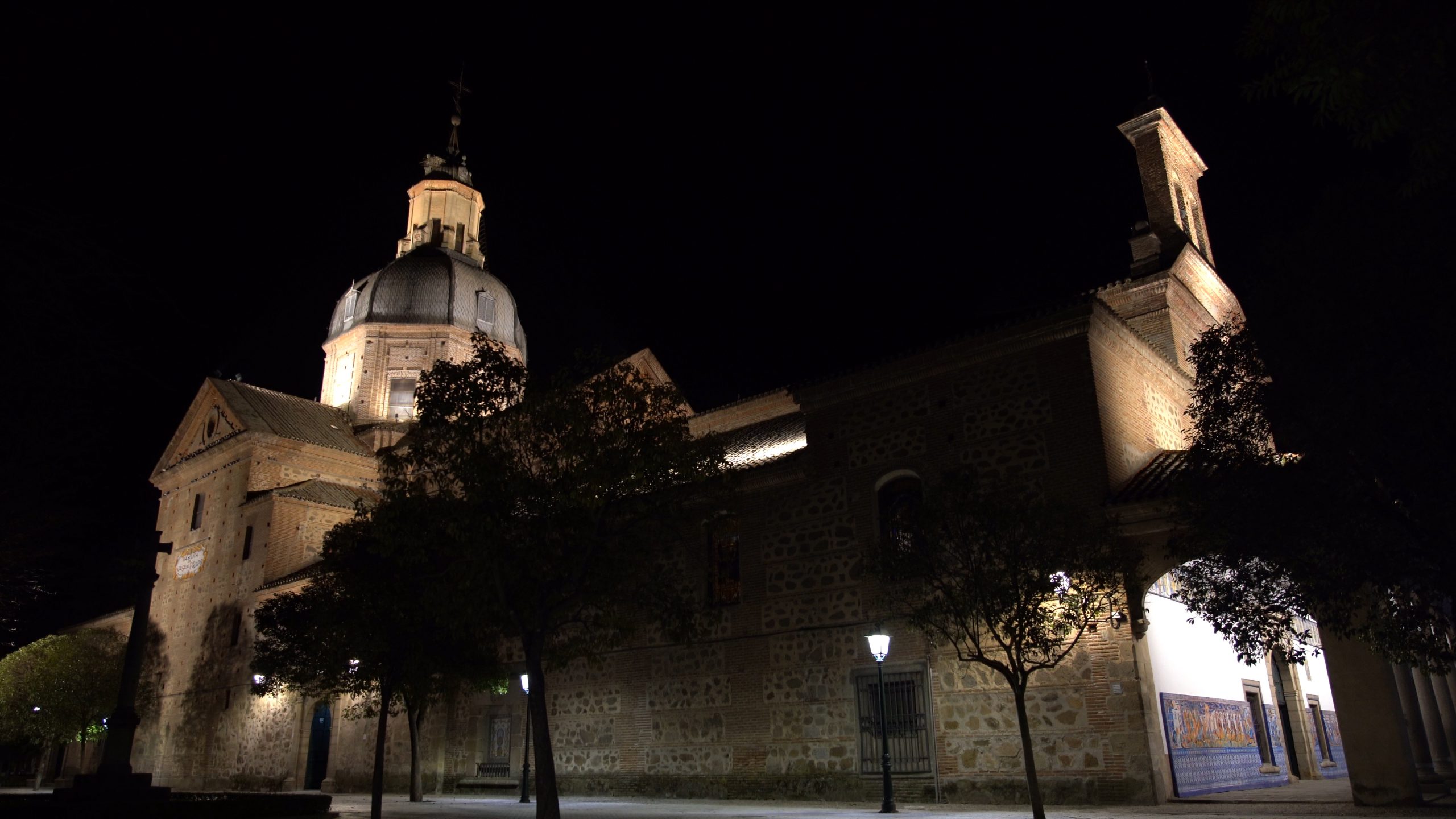
Fundación Iberdrola and the Spanish Navy inaugurate the lighting of the monumental staircase in the Navy General Headquarters in Madrid
- The project relates to new ornamental lighting that will not only highlight its architectural features but will also improve the maintenance and energy efficiency of this monument.
- The 117 LED luminaires that have been installed add up to a total power of only 2,500 watts, which is equivalent to the power of a domestic radiator and improves energy efficiency by 48%
Madrid. The chairman of Fundación Iberdrola España, Fernando García, and the chief of navy staff, Admiral Teodoro López Calderón, have inaugurated the new ornamental lighting of the monumental staircase in the Spanish Navy’s General Headquarters. This empire-style staircase presides over the entrance from the main door (calle Montalbán) and now has lighting that highlights the architectural features of the space while minimising the visual impact of the luminaires by blending them into their surroundings, thanks to their design.
The project was undertaken in the entrance to this early 20th-century building, which was the headquarters of the Ministry of the Navy until 1977, it is located on the Paseo del Prado and also houses the Naval Museum. It has involved an investment of 50,000 euros and is part of a collaboration agreement between Fundación Iberdrola España and the Naval Museum Foundation.
The new ornamental illumination, which will consist of over 117 LED lights to replace the old bulbs, will emphasise the architectural and eclectic style of the interior of the building, as well as highlighting the three flights and landing of this beige and brown Carrara marble staircase, which is one of the most beautiful examples of Madrid architecture. Above the arch that frames the staircase is a sculptural frieze from the Godoy Palace and it is crowned by leaded windows that illuminate the space overhead.
The purpose of the project – part of the Fundación Iberdrola’s Illumination Programme – underlines Iberdrola’s commitment to maintaining and promoting art and culture as well as driving innovation and respect for the environment.
The new lighting has state-of-the-art LED technology which will reduce energy costs for this monument and CO2 emissions, as well as minimising maintenance. The total power of the new lighting system will be only 2,500 watts, the equivalent of a household radiator. This will make it possible to improve energy efficiency by 48%.
IBERDROLA, committed to society
Since its beginnings, Iberdrola has been committed to the energy, cultural and social development of the communities in which it operates. In this regard, Fundación Iberdrola España represents one more step in this commitment; through the development of initiatives to help improve people’s quality of life.
One of the Foundation’s main areas of activity focuses on the care, conservation and promotion of historic and artistic treasures. Since 2011, the investment assigned to the Lighting Programme has reached almost 3 million euros, and has resulted in improvements to around 40 monuments in Spain, including the Roman Bridge in Alcántara, Cáceres; the façade to the Congress of Deputies in Madrid; the Cathedral in Ávila and the interior of the New Cathedral in Salamanca.
The Naval Museum Foundation, an institution dedicated to raising awareness regarding the maritime history of Spain
The aims of the Naval Museum Foundation include protecting, expanding and disseminating the information on the historical heritage of the Navy contained in its museums in Madrid, Torre del Oro (Seville), Ferrol, San Fernando, Cartagena and Las Palmas de Gran Canaria, as well as in the Naval Historical Archive in Viso del Marqués, Ciudad Real.
One of the Naval Museum Foundation’s most important tasks is to facilitate historical research relating to navigation, war at sea and shipbuilding; in addition to providing support to the Naval Institute of Naval History and Culture.
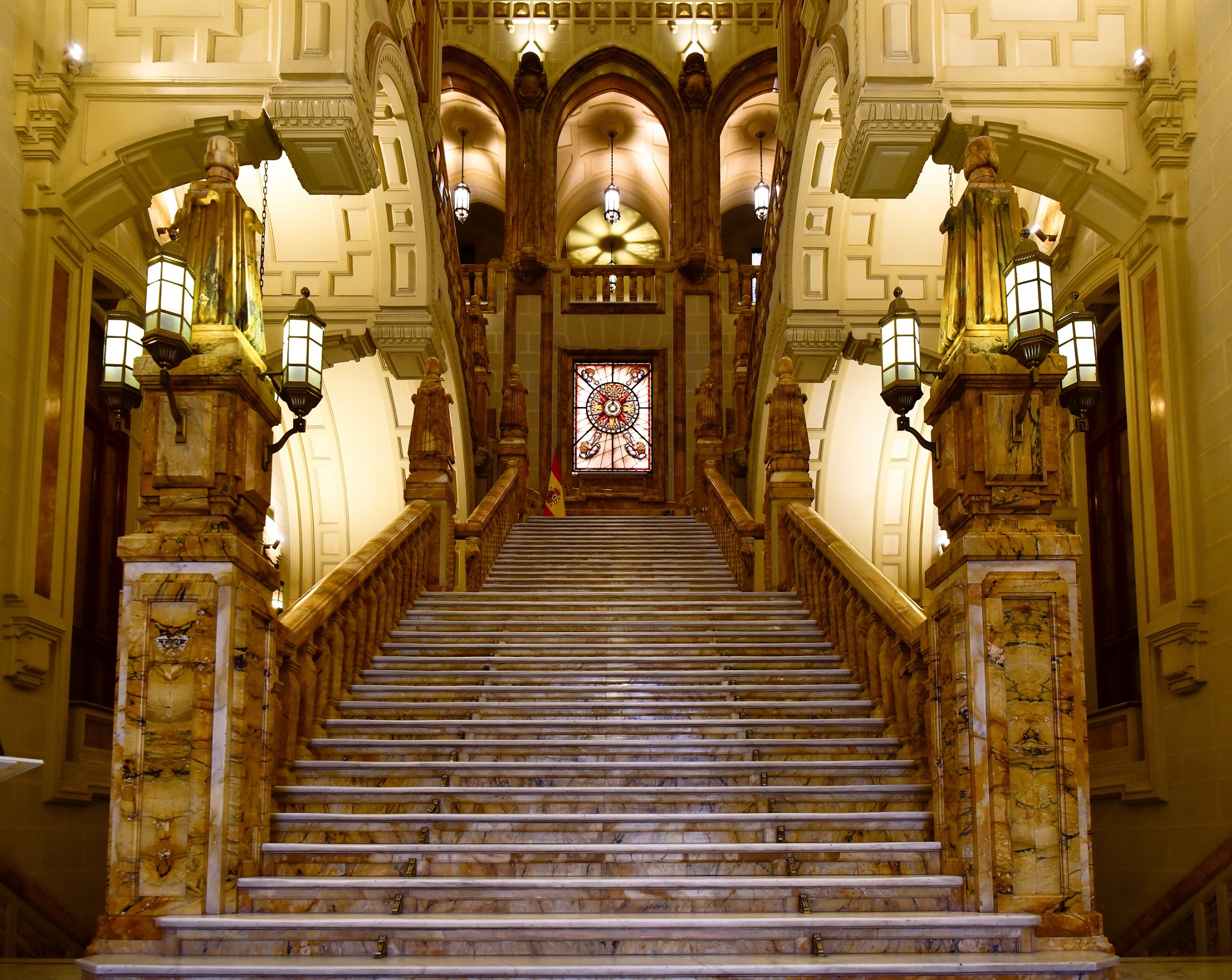
Iberdrola is to illuminate the altarpiece of the Old Cathedral of Salamanca
- The Dean/Chairman of the Cathedral Council, Florentino Gutiérrez, and the Director of the Fundación Iberdrola España, Ramón Castresana, have this morning signed an agreement to proceed with this initiative.
- This act, under the auspices of the Fundación Iberdrola España’s Illumination Programme will safeguard its conservation and endow the altarpiece with modern and efficient lighting.
Salamanca. The Dean/Chairman of the Salamanca Cathedral Council, Florentino Gutiérrez, and the Director of the Fundación Iberdrola España, Ramón Castresana, have this morning signed an agreement to renew the lighting of the great altarpiece of the Old Cathedral of Salamanca.
For the illumination of the altarpiece, a thorough study was carried out of angles, power and optics to correct the obsolete and poor lighting that exaggerated shine and reflections.
The aim of the project, part of the Fundación Iberdrola España’s Illumination Programme, is to provide the whole area with up-to date and efficient lighting that avoids glare and fully safeguards its conservation. In addition, the operation intends to achieve a colour reproduction that does not alter the paintings.
The great altarpiece and the Old Cathedral
Salamanca’s Old Cathedral, in Romanesque and Gothic style, was built around the 12th and 14th century on the initiative of the first bishop of the city, Jerónimo de Perigord. The building was constructed around 5 chapels, a cloister and its chapterhouses. When the New Cathedral was planned, the possibility was discussed of knocking down the old one, but finally this idea was abandoned and currently the Salamancan capital boasts two cathedrals.
The great altarpiece, produced between 1430 and 1450, adorns the semicircular apse of the building which is rounded off with a half-dome. It is structured around a narrow platform above which are 1eleven sections and five rows depicting scenes from the life of the Virgin Mary and Jesus Christ, the work of three artists, most notably the Italian Dello Delli. The use of bright colours, typical of Flemish art, is testament to the influence of the Italian and Sienese schools.
In addition, the altarpiece is presided over by a sculpture of the patron saint of the city, the Virgen de la Vega, which came from the former monastery of Santa María de la Vega. The statue, in Byzantine style, is showing the Baby Jesus to the faithful and is covered in gilt bronze encrusted with enamel and precious stones, a task undertaken by Salamancan workshops.
Iberdrola’s strong commitment to Salamanca and Castilla y León
The new lighting for the great altarpiece is the crowning glory of a series of projects carried out in the Salamancan capital as part of the Fundación Iberdrola España’s Illumination Programme. In April the company inaugurated the ornamental lighting for the interior of the New Cathedral which highlighted the most important elements of this place of worship.
Iberdrola used the most highly-advanced LED technology to draw attention to the vaulted ceilings in the lateral and central naves, the transept and the lantern tower and also to highlight specific items in the main chapel and altar, using 6.9 kilowatts (kW) of total installed power.
To achieve this it installed a total of 144 spotlights and almost 1,400 metres of cabling in the galleries of the triforia of the cathedral, which, thanks to meticulous installation, remain unseen to the eyes of visitors.
Likewise, in May Iberdrola inaugurated the illumination of the interior of the Chapel of the Colegio Mayor del Arzobispo Fonseca, declared a Site of Cultural Interest. This operation succeeded in limiting light pollution by obtaining uniform illumination that highlighted the altarpiece, the dome and the transept.
The illumination of the altarpiece of Salamanca’s Old Cathedral is another example of Iberdrola’s commitment to Castilla y León and its enduring mission to promote the social value of the culture, origins and conservation of the region’s historical-artistic heritage.
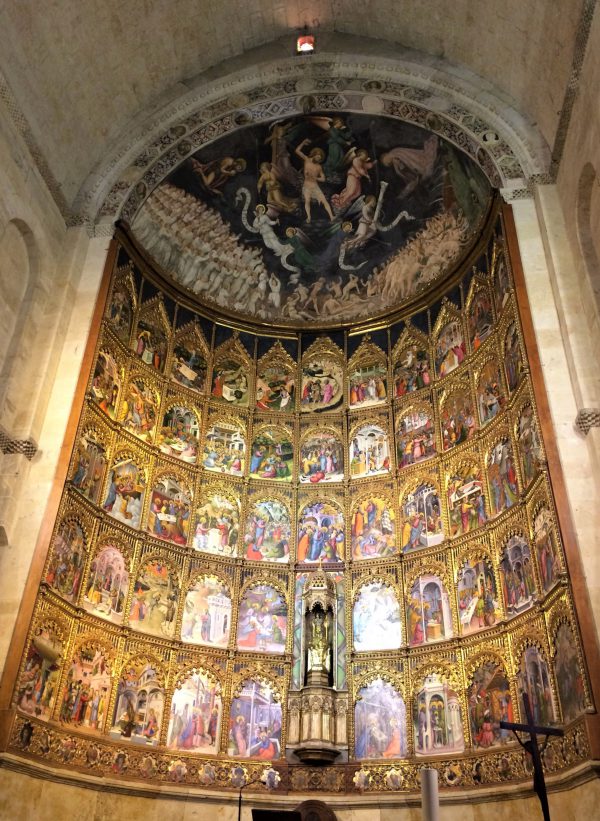
Ignacio Galán has presided over the act of switching on the new lighting of the Cathedral of Christ the Savior of Ávila, after having carried out a thorough renovation project in line with the needs and relevance of this temple declared an Asset of Cultural Interest.
The renovation project has been possible thanks to the collaboration agreement signed in April 2018 between our company, through Fundación Iberdrola España, and the City Council of Ávila. The temple thus improves its nighttime image, highlighting the distinctive elements of its architecture by limiting light pollution, and gains in energy efficiency, which will allow it to avoid the emission into the atmosphere of 4.8 tons of CO2 per year.
In addition, the most advanced LED technology has been applied to improve the night-time image of the church, the entire perimeter of the cathedral plus the roofs and towers, with a total installed power of 17 kilowatts (KW).
The project is part of Iberdrola’s Illuminations Program and the Avila City Council’s Master Plan for Illuminations of the Nightscape and is included in the events of the Teresian Jubilee Year.
The lighting of the cathedral of Ávila is another example of Iberdrola’s commitment to Castilla y León and its aim to promote the social value of culture and the protection and conservation of the region’s historical and artistic heritage.
The Cathedral of Christ the Savior was the first Gothic cathedral in Spain, designed as a temple and fortress, its apse being one of the cubes of the city wall.
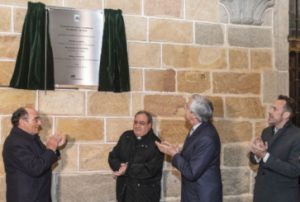
- The switch-on ceremony was attended by the Bishop of Salamanca, Carlos López; the chairman of Iberdrola, Ignacio Galán; the mayor of Salamanca, Carlos García Carbayo; the dean-president of the Cathedral Chapter, Florentino Gutiérrez, and the president of Fundación Iberdrola España, Fernando García.
- The most highly-advanced LED technology was used to draw attention to the vaulted ceilings in the lateral and central naves, the transept and the lantern tower and also to highlight specific items in the main chapel and altar.
- The refurbishment project, which has a total installed power of 6.9 kilowatts (kW), has improved the energy efficiency by 87%.
Salamanca. This afternoon, Fundación Iberdrola inaugurated the interior decorative lighting in Salamanca’s New Cathedral after carrying out meticulous refurbishment and installing a new lighting system to give greater prominence to the most important elements of this church, which has been declared a Cultural Heritage Site.
This refurbished lighting inside the New Cathedral will improve energy efficiency by 87%, the switch-on ceremony of which was attended by the Bishop of Salamanca, Carlos López; the chairman of Iberdrola, Ignacio Galán; the mayor of Salamanca, Carlos García Carbayo; the dean-president of the Catgedral Chapter, Florentino Gutiérrez, and the president of Fundación Iberdrola España, Fernando García.
berdrola’s chairman affirmed that this work was part of its Illumination Programme, “for which we allocate significant resources with the principle objective of preserving and conserving special buildings to contribute to enhancing the rich heritage of our country. The New Cathedral in Salamanca is one of the most important examples of the unique cultural heritage in this wonderful city”.
He went on to underline: “With this project, we are not only contributing to the artistic and cultural assets within the regions in which we operate, but we are also helping to boost their economies and promote care for the environment by using the most efficient technologies”.
The company has used the most highly-advanced LED technology, with 6.9 kilowatts (kW) total installed power, to draw attention to the vaulted ceilings in the lateral and central naves, the transept and the lantern tower and also to highlight specific items in the main chapel and altar.
The work entailed fitting 144 spotlights and 1,400 metres of wiring, which was expertly installed so as to not be visible to visitors to the triforia that encircle the cathedral’s naves.
Iberdrola’s strong commitment to Castilla y León
The interior decorative lighting of Salamanca’s New Cathedral is another example of Fundación Iberdrola’s commitment to Castilla y León and its enduring mission to promote the social value of the region’s culture and protect and conserve its historical-artistic heritage.
The company has close historical links with this region, in which it serves more than one and a half million customers. It has a generating capacity of over 5,700 megawatts (MW), almost all of which is from renewables, from wind farms such as Sierra de Dueña to large complexes such as the Aldeadávila hydroelectric plant, both of which are located in Salamanca province.
Almost 1,000 professionals -more than 200 in the province of Salamanca. This influence is also reflected in the nearly 100 million euros invested in this region last year, purchases from almost 800 local suppliers, worth 165 million euros, and a tax contribution of over 230 million euros.
Construction of the New Cathedral in Salamanca began in the 16th century and the works took over 200 years to complete; despite this, its original late Gothic style has been preserved throughout the whole structure. At the request of the Cathedral Chapter, the Catholic Monarchs were initially involved in developing the construction of the cathedral, with successive bishops subsequently acting as the main developer. The great master architects who directed the works for almost two and a half centuries include, among others, Juan and Rodrigo Gil de Hontañón, Juan de Álava, Juan Setién Güemes, Pantaleón Pontón, the Churriguera brothers and Juan de Sagarbinaga.
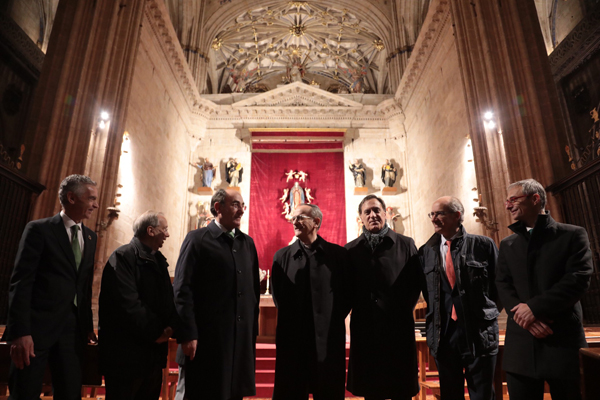
- The rector of the University of Salamanca, Ricardo Rivero; the chairman of Iberdrola, Ignacio Galán; the mayor of Salamanca, Carlos García Carbayo, and the president of Fundación Iberdrola España, Fernando García, all attended the switching on of the lights.
- The most advanced LED technology has been utilised to give lighting that highlights the altarpiece, the cupola of the dome, the vault and the side aisles and to emphasise the transept and achieve a uniform illumination that limits light pollution.
- The renovation project has improved energy efficiency by 65%.
The interior decorative lighting in the chapel of the Colegio Mayor de Arzobispo Fonseca in Salamanca is another example of Iberdrola’s commitment to Castilla y León and its enduring mission to promote the social value of the region’s culture and protect and conserve its historical-artistic heritage.
The company has close historical links with this region, in which it serves more than one and a half million customers. It has a generating capacity of over 5,700 megawatts (MW), almost all of which is from renewables, from wind farms such as Sierra de Dueña or large complexes such as the Aldeadávila hydroelectric plant, both of which are located in Salamanca province.
Through its activities, Iberdrola provides a powerful stimulus to the regional economy, where it employs almost 1,000 professionals -more than 200 of these in the province of Salamanca. A boost that is also reflected in the nearly 100 million euros invested in this community last year, purchases from almost 800 local suppliers worth 165 million euros and a tax contribution of over 230 million euros.
The Colegio Mayor de Arzobispo Fonseca, which belongs to the University of Salamanca, was founded in 1519 by Alonso de Fonseca, archbishop of Santiago de Compostela, so that Galician students had a College to study in at the University, and it was declared an Asset of Cultural Interest in 1931. It is a Plateresque style monastic building, built around a cloister and its chapel contains an exceptional altarpiece by Alonso de Berruguete. The architects Diego de Siloé, Gil de Hontañón and Juan de Álava participated in the construction work.
El Colegio Mayor del Arzobispo Fonseca, que pertenece a la Universidad de Salamanca, fue fundado en 1519 por Alonso de Fonseca, arzobispo de Santiago de Compostela, para que los estudiantes gallegos tuvieran un Colegio para estudiar en la Universidad, y declarado Bien de Interés Cultural en 1931. Es un edificio de estilo plateresco, de tipo conventual constituido alrededor de un claustro y en el que destaca la capilla con un excepcional retablo de Alonso de Berruguete. En los trabajos de construcción participaron los arquitectos Diego de Siloé, Gil de Hontañón y Juan de Álava.
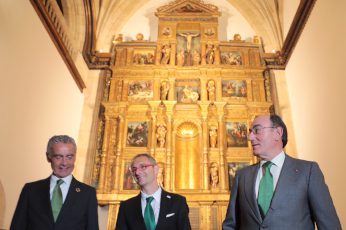
The Mayor of Ordizia, José Miguel Santamaría, and the director of the Iberdrola Spain Foundation, Ramón Castresana, signed a collaboration agreement this Monday, September 17, in Ordizia for the ornamental lighting of the facade of the Barrena Palace, to highlight the architecture and artistic elements of its facades. The president of Fundación Iberdrola, Mr. Fernando García Sánchez, the director of Iberdrola Distribución Región Norte, Mr. José Mª Grijalba and the councilor of Culture of Ordizia, Joseba Aranburu, accompanied the signing, which took place in the palace itself. The initiative is part of the program prepared for the commemoration of the 750th anniversary of the granting of the Town Charter to the town.
The investment, assumed by the Iberdrola Spain Foundation, will be 80,000 euros and the work will include the preparation of the lighting project, the supply of luminaires, the technical management, and execution of the installation of the luminaires. For its part, the Ordizia Town Council will assume the maintenance and conservation of the electrical installations and the costs of electricity consumption. It is estimated that this project will be completed in the first half of 2019.
The Barrena Palace, designated as an Asset of Cultural Interest in 1964 and the current house of culture and music school of the town, is a faithful exponent of the Basque urban palatial architecture of the seventeenth century. It is one of the most illustrious buildings of the Villa and its name means the house below and clearly indicates the situation it occupies. It was once in communication, by means of a gallery, with the house called Jaques until the last Carlist civil war, when the gallery was demolished, separating the two buildings, the works were directed by the famous architect Juan de Herrera. It is a rectangular building with a first floor and three floors. It has different architectural styles in its three facades, being an almost unique case of architecture in the Basque Country.
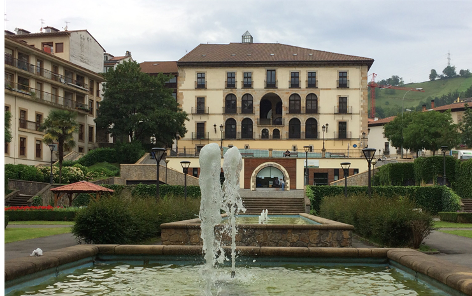
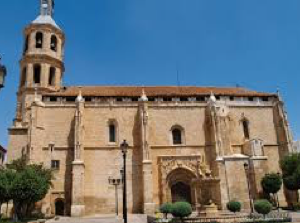
Fundación Iberdrola España is contributing to improving the illumination in Santísimo Cristo church in Valdepeñas.
Los orígenes de este The origins of this church date back to the late 12th and early 13th centuries, when it was originally part of the fortress of the Knights of Calatrava. The façades have two sturdy buttresses and several doors. The Plaza de España gate opens into the southern façade which looks on to the “Puerta del Sol”. It dates from the second half of the 15th century and is dedicated to the Assumption.
This church is in the Isabelline Flamboyant Gothic style. The so-called “Puerta de los Catecúmenos“, of possible Romanesque origin, appears framed by a lintel that housed an image of the Pietà.
This project is, currently, in the execution phase.
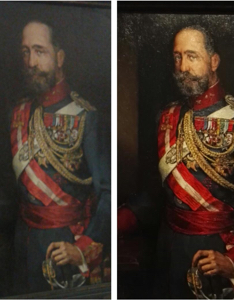
The Spanish Army Museum needed to renew its interior lighting and prepare some spaces to house collections.
We have participated in the project to modify the lighting of the Army Museum’s collection, which needed to address the interior lighting in its display cases, the paintings and panels and the Flags-Artillery-Arms collections, as well as to set up certain spaces to accommodate collections. This project reduced energy consumption and optimised the chromatic reproduction index and reliability of the control system.
To improve the interior lighting in the display cases, we replaced fluorescent luminaires with LED lights and changed the smart control system for another with a timer as well as undertaking subsequent modifications to the electrical panels.
Due to the large number of collections on display, we have fitted out different rooms that were not previously equipped to hold exhibitions. To do this, we installed suspended rails with indirect LED lighting to the ceiling and specific rails that allow adjustable LED spotlights to be placed below them.
In order to enhance the lighting of certain paintings and panels, new rails were installed, existing ones were enlarged and an appropriate number of spotlights supplied. Finally, the lighting for the Artillery, Flag and part of the Arms collections involved the installation of suspended rails with indirect LED lighting to the ceiling that also allowed adjustable LED spotlights to be placed below them.
We replaced fluorescent luminaires with LEDs and changed the smart control system to improve the interior lighting in the display cases.
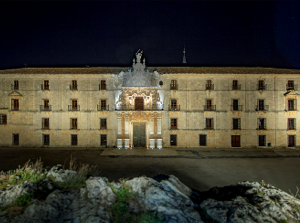
Uclés Monastery has new outdoor lighting thanks to the project promoted by Fundación Iberdrola España.
The installation of the new exterior lighting for the main portal in the southern façade of the Monastery of the Order of Santiago in Uclés, Cuenca, involved renovating the decorative lighting to highlight, on the one hand, the volume of the façade and, on the other, the architectural details of this monument that was built in 1735. This initiative also included the lighting of the keep in Albar Llana Castle, an old fortress of Arab origin located close to the monastery.
The design of the decorative lighting for this Churrigueresque doorway, which is attributed to Pedro de Ribera and is one of the best preserved Baroque examples still existing, combines flood lighting that highlights the general volume of the façade and spot lighting that highlights its architectural details. The combination of optics and colour temperatures in the selected floodlights helps to enhance the unique elements.
This project involved the installation of a total of 18 LED luminaires, with a total power rating of 1,640 W, with a reduction of 55% compared to the previously installed lighting. This will result in significant savings in energy expenditure and avoid the emission of up to one tonne of CO2 into the atmosphere annually.
We inaugurated this project on 9 May 2018, along with the Diocese of Cuenca, in a ceremony attended by José María Yanguas (Bishop of Cuenca) Emiliano García-Page (President of the Regional Government of Castilla-La Mancha), Ignacio Galán (Chairman of Iberdrola ) and Félix Sanz Roldán (Secretary of State Director of the National Intelligence Centre).
Media error: Format(s) not supported or source(s) not found
Download File: https://cdnapisec.kaltura.com/p/1843481/sp/184348100/playManifest/entryId/1_p10wyz61/flavorId/1_9irsbz96/format/url/protocol/https/a.mp4?_=2The renovation project for the new decorative lighting for the Royal Pantheon in San Isidoro de León Collegiate Church was undertaken thanks to a collaboration agreement that we signed in 2017 with the San Isidoro de León Collegiate Church Chapter. The objective of this agreement was to develop and execute a lighting project to highlight the outstanding nature of this chapel, which was built in the 11th century, and the cultural assets it hosts.
Media error: Format(s) not supported or source(s) not found
Download File: https://cdnapisec.kaltura.com/p/1843481/sp/184348100/playManifest/entryId/1_hr3hehn0/flavorId/1_7wct0k2k/format/url/protocol/https/a.mp4?_=3The lighting project in detail
LED spotlights were used with over 98% colour rendering, which makes it possible to achieve full colour fidelity at a colour temperature of 3000 ºK, which is very similar to sunlight. It is also interesting to note that the benefits of LED technology were fully utilised, as this type of lighting is kinder to paintings since it does not emit infrared or ultraviolet light.
The design of the decorative lighting of the vaulting uses interlaced beams of light to ensure perfect uniformity as well as avoiding high light concentration at the source of the beams, thus lessening the light levels the paintings are exposed to.
In addition, three natural light sensors were installed to automatically adjust the light level in the Royal Pantheon’s interior. This was achieved by installing a centralised control system to regulate light intensity.
This lighting project was inaugurated on 18 April 2018.
About the Royal Pantheon in Saint Isidore church
Located at the foot of the Collegiate Church, it has a quadrangular plan with three naves and two central columns. The capitals have a variety of decorations; some have zoomorphic figures, others have vegetable decorations and two of them have evangelical scenes -the resurrection of Lazarus and the healing of the leper.
The kings and queens of León were buried here in the Middle Ages. It is decorated with highly important paintings, both in terms of their quality as well and also for their state of preservation, leading it to be called the “Sistine Chapel of Romanesque art“.
- The paintings portray different religious scenes and the arcades are decorated with ornamental elements. The paintings in the vaulting include: the Annunciation, the Slaughter of the Innocents, The Last Supper, the Trial and Passion of Christ, the Book of Revelation and the Prologue, and the Christ Pantocrator, all of them in an excellent state of conservation.
LED spotlights were used for this lighting project to provide a totally reliable colour perception and uniform illumination with crossed beams.
Together with the Royal Tapestry Factory, we have renovated the lighting system in the restoration workshop of this institution, which was founded at the beginning of the 18th century by King Philip V. The installation concluded a comprehensive transformation process using the most advanced LED technology in line with the workshop’s needs and importance. The new workshop lighting system will reduce electricity consumption by over 47% and save CO2 emissions of close to 3.5 tonnes per year.
Media error: Format(s) not supported or source(s) not found
Download File: https://cdnapisec.kaltura.com/p/1843481/sp/184348100/playManifest/entryId/0_kj2vdxb5/flavorId/0_3emhbr9k/format/url/protocol/https/a.mp4?_=4It is expected that this new and modern technological solution will set a precedent among restoration facilities, as it has not yet been applied to many factories in the world and, especially textile factories. The project provides ideal lighting to preserve textiles, thereby improving efficiency and the conservation conditions for the pieces in the workshop.
Cutting edge LED technology
This new lighting has the most modern LED technologies, which guarantees the sustainability of the installation, one of the main objectives for Iberdrola within our commitment to caring for the environment and the fight against climate change.
- For the workshop lighting project, a total of 28 sustainable energy-efficient LED were installed, the lamps were suspended from the ceiling, significantly increasing lighting levels in the room.
- The lighting has been further enhanced at six work benches, through the design and assembly of made-to-measure metal structures that ensure colour rendition in excess of 98%, and over 80% light uniformity. These structures also include the possibility of regulating the light level, according to the needs of each restorer. Prior to the project, the lighting consisted of 28 halogen bulbs and eight fluorescent lights with a total power of 11,488 W. After the renovation, it has been possible to reduce consumption by more than 47%.
- Lastly, a new lighting system has been installed in the Dyeing Room, featuring 12 LED lamps which provide the same colour temperature and rendition as in the workshop.
This project was undertaken thanks to an agreement we signed with the Royal Tapestry Factory in 2017 to renovate the restoration workshop lighting, continuing a collaboration that began in 2013 with the Restoration of the tapestries of the Patriarch in the Royal College of Corpus Christi in Valencia.
About the Royal Tapestry Factory
Founded in 1721, the Royal Tapestry Factory has 300 years of experience in the production and restoration of tapestries, carpets, and ornamental embroidery.
In the early 18th century, the Factory was the European benchmark for luxury fabrics, thanks to the collaboration between weavers and renowned painters, such as Goya, Mengs, and Bayeu. In 1889, the urban growth of Madrid forced the factory to relocate to the outskirts of the capital: the site chosen was an olive grove and orchard known as Atocha, where the Royal Tapestry Factory is still located to this day.
In 1996, the institution became the Royal Tapestry Factory Foundation. The Foundation is dedicated to preserving handicrafts, the conservation and restoration of Spain’s textile heritage, and the general promotion of all cultural activities that contribute to an understanding of the art of tapestry.
The new LED lighting guarantees the sustainability of the installation and helps the restorers to carry out their work in greater comfort.
In 2016, Fundación Iberdrola España and the Cathedral Chapter signed an agreement to update the lighting in the Chapel of the Holy Chalice, thus continuing a collaboration that began in 1999 with the lighting of Valencia Cathedral. A total of 38 spotlights and 28 metres of highly efficient and sustainable LED technology strips were installed, substantially improving the overall lighting in the room. Two specific lights for the reading area were added and the fluorescent lights in the niche of the Holy Chalice were replaced. Previously, the lighting consisted of 28 halogen and fluorescent bulbs with a total power rating of 4,500 W.
Media error: Format(s) not supported or source(s) not found
Download File: https://cdnapisec.kaltura.com/p/1843481/sp/184348100/playManifest/entryId/1_rvxxgqtd/flavorId/1_bc5h4j1x/format/url/protocol/https/a.mp4?_=5After the renovation, electricity consumption was reduced by over 60%. In addition, the versatility of this new installation allows the chapel to be partially lit, so daily power use will be less. A control system with a touch screen has also been installed to programme the illumination of the scenes in the altarpiece, or areas in the chapel.
The project’s decorative lighting design centred on a series of elements: the ribbed vault, the front of the alabaster altarpiece, the niche containing the Holy Chalice, contrast lighting for the altarpiece, illumination in the area around the altar and general illumination in the chapel. This design combines cold white and warm white lighting to highlight specific elements and the existing rails have been reused respecting their location, thereby minimising impact on the walls.
The project, which also included the cleaning of the alabaster altarpiece prior to its lighting, was inaugurated by Ignacio Galán, Chairman of Iberdrola.
Chapel of the Holy Chalice in Valencia Cathedral
The Chapel of the Holy Chalice was built between 1365 and 1369. It measures 13 metres wide by 16 high and is covered with a high ribbed vault in the shape of a star whose ribs extend to rest on polychrome corbels. In 1916, the Holy Chalice was moved to the chapterhouse, which became the current chapel.
The chapel is in the Flamboyant Gothic style (14th century). It has a square floor and smooth walls, of carved stone. The twelve Apostles and the Coronation of the Virgin Mary in heaven after the Assumption are represented in the vault’s keystones. The cathedral is dedicated to the Assumption.
This space was not affected by the neoclassical refurbishment in the 18th century when the alabaster altarpiece was placed in the 15th century choir entrance. On the walls it is possible to see the Adoration of the Kings, a fresco painting by Nicolás Florentino (1472), and the chains that closed the port of Marseilles, which were brought to Spain by Alfonso V the Magnanimous in the 15th century.
The lighting project for the Chapel of the Holy Chalice included decorative lighting which combines lighting in cold white and warm white.
The new architectural lighting for the main façade of Irún Town Hall has achieved an energy efficiency of 83% compared to the previous lighting, thanks to the new system that we implemented in 2017. Built in the 17th century, this Baroque building has a main façade made of stone ashlar with keystones on the ground floor and corners, topped with a stone cornice on which there is a balustrade divided by a large shield carved from limestone. On the ground floor, a five-arched arcade gives access to the interior of the building; and crowned effigies appear on each of the arches. On the main floor, there is a large balcony, supported by corbels, onto which five doors topped with pediments open.
As a result of an agreement signed in 2016, the goal was to design the decorative lighting according to aesthetic and efficiency criteria, using LED technology and, particularly, RGB luminaires that allow dynamic colour changes and the programming of different light scenes. As well as the general lighting, the intention was to create a contrast between areas such as the porch and balustrade, and to use the lighting to accentuate particular elements such as the coat-of-arms that crowns the upper floor.
This project consisted of the design and installation of a decorative lighting system that met aesthetic and energy efficiency requirements.
We installed 11 500 W floodlights, which use less electricity than a domestic microwave, 12 120-cm strips and 31 metres of RGB-technology LED strips that will allow dynamic colour changes. The design is completed with a control system using a DMX installation which allows the colour scenes and combinations to be programmed from a touch screen within the building, making the control system easy to operate.
Towards the end of 2016, we signed a collaboration agreement with the General Directorate of Fine Arts and Cultural, Archive and Library Heritage, part of the Spanish Ministry of Education, Culture and Sport, to plan and execute an architectural lighting project for the church of the Royal Monastery of Santa María in El Paular.
Media error: Format(s) not supported or source(s) not found
Download File: https://cdnapisec.kaltura.com/p/1843481/sp/184348100/playManifest/entryId/1_yoel733y/flavorId/1_81i5xtvw/format/url/protocol/https/a.mp4?_=6Following the signing ceremony, we began the renovation of the decorative lighting within the monastery’s church, which began to be constructed in 1390 and would take several centuries. LED technology was used as the basis for this project in order to meet the sustainability and energy saving criteria. But the project’s main objective was to enhance its unique elements, specifically the 15th century altarpiece, the ashlar masonry and the vaults, by means of general and accent lighting.
The project was based on technical criteria including:
- To give the length of the nave a sense of continuity with lighting above the top cornice at the base of the vaulting to provide overall medium illumination and avoid excess light in the area, respecting the atmosphere of the surroundings and the natural light.
- To avoid glare and light pollution and reduce intrusive or unpleasant lighting.
- To achieve a design that could ensure that the installation could be easily maintained.
As the altarpiece is the church’s most important element, the lighting design was versatile and dynamic to cover the different uses made of the church: worship, sightseeing, events, etc. A total of 28 spotlights were, therefore, installed which provide more subdued general lighting and partial, accent lighting for different scenes in the altarpiece, which aid informative descriptions during tourist visits.
To make this dynamic illumination of the different scenes on the altarpiece possible, a control system was installed incorporating a programmable touch screen with editing via buttons to adjust the visual effect in the different areas of the church and altarpiece, together with software that allows it to be programmed from a computer or mobile telephone using a custom-made app. The programming system installed is designed to make it compatible with the different uses of this holy place (worship, tourism, events, etc.).
Finally, the total power required for the new church illumination is just 2.4 kW, compared to 9.1 kW for the former lighting. From an environmental point of view, this greater energy efficiency reduces CO2 emissions by 2.1 tonnes annually.
Special attention was paid to the altarpiece during this project as it is the most important element in the church; a total of 28 spotlights were installed around it to provide general and partial lighting.
One of the most important initiatives undertaken under the agreement between Iberdrola and the Fundación San Sebastián 2016 – Capital Europea de la Cultura was the project to provide the decorative lighting for the main façade of the Donostia/San Sebastián Town Hall. Fundación Iberdrola España designed and implemented the project as part of our Lighting Programme.
Media error: Format(s) not supported or source(s) not found
Download File: https://cdnapisec.kaltura.com/p/1843481/sp/184348100/playManifest/entryId/0_7yzny1bh/flavorId/0_441ykp7u/format/url/protocol/https/a.mp4?_=7The objective of this project was to provide architectural lighting that would bring the town hall’s main façade to life at night (the town hall was built in 1887). To achieve this, the latest generation LED luminaires were installed, as these are characterised by their efficiency and the quality of their chromatic reproduction. In addition to controlling the night-time glare and light pollution, they also reduce intrusive or unpleasant light.
At the request of the City Council, the project was based on RGB luminaires and the DMX data system that allows coloured lighting to be used and different lighting scenes to be programmed. The lighting is produced from luminaires placed around the building, in particular, among its ledges, cornices, balusters, etc., which, due to their size, can house the necessary luminaires.
The project’s aim was to provide architectural lighting that would bring the town hall’s main façade to life at night.
We financed this project with 45,000 euros to roll out new exterior decorative lighting for the Palace of the Spires, located in the historic centre of Logroño and which currently houses the headquarters of the Riojanos Study Institute (IER). The design of the project aimed to highlight the monument’s façade, enhancing its architectural and volumetric compositions through the installation of 98 LED technology luminaires.
The decorative lighting for the Palace of the Spires aimed to highlight the historic building’s architectural and volumetric compositions.
Distributed across the building’s five levels, the luminaires highlight elements such as its windows, cornices and spires, taking care to integrate them into with the surrounding urban environment. In addition, the total installed power for this decorative lighting is only 1,800 W, ensuring greater energy efficiency and a reduction in the maintenance cost for this 16th century palace, which is one of the most emblematic buildings in the capital of the La Rioja region.
The lighting system in several of the rooms at the San Fernando Royal Academy of Fine Arts needed to be renewed and the fluorescent luminaires replaced with LED technology. Through our support, we have contributed to this transformation, which has resulted in the following advantages:
- An improvement in the appreciation of the exhibited works, allowing them to be admired in all their fullness, which implies a more enriching experience for visitors.
- An improvement in the protection for works exposed to the light.
- Reduced energy consumption compared to conventional lighting systems.
- A decrease in polluting effects, with the consequent benefit in terms of environmental conservation.
The use of LED lighting in a museum setting improves the conservation conditions for the works of art as the luminaires do not emit infrared or ultraviolet radiation. The luminaires light up instantaneously and their performance is not influenced by the number of on/off cycles they are subjected to. They also produce light with a visual effect that is nearly equivalent to that of natural light and they reproduce colours with great fidelity, with a chromatic index of 80 out of 100. Another added advantage is that LED luminaires do not generate as much heat as traditional systems, an essential requirement in a museum to achieve energy savings on seasonal air conditioning.
Media error: Format(s) not supported or source(s) not found
Download File: https://cdnapisec.kaltura.com/p/1843481/sp/184348100/playManifest/entryId/1_zpg4gdoe/flavorId/1_n6m9mgsy/format/url/protocol/https/a.mp4?_=8In the museum, general ambient lighting was combined with partial, accent lighting, to highlight the works of art. Visitors now perceive a uniformly-lit serene space free from the shadows, which can be caused by overhead lighting, recreating the appearance of natural light. For the accent lighting, LED spotlights were used for those works that required it due to their importance or aesthetic qualities.
The combination of general ambient lighting with partial, accent lighting, highlights the works of art.
LED lighting offers different shades of light (from cold to warm) that can be adapted to all types of environments. In the museum, cold lighting has been chosen, since a detailed analysis of the colour spectrum guarantees that blues and reds are reduced, the resulting light is as close as possible to natural light, thus improving the perception of the works of art.
Built around 1180, this Mudejar building has five naves separated by pillars on which horseshoe arches rest and it stands out for the contrast between the sobriety of the synagogue’s exterior and its elaborate interior.
Media error: Format(s) not supported or source(s) not found
Download File: https://cdnapisec.kaltura.com/p/1843481/sp/184348100/playManifest/entryId/1_6rcv9fyt/flavorId/1_4swe0t9v/format/url/protocol/https/a.mp4?_=9The lighting project carried out was unique due to the building’s characteristics. The aim was to provide the synagogue with modular lighting that allows:
- The tonality of the white light to be varied to simulate daylight depending on the time of day.
- Different scenes and transitions to be created.
- Contrasts to be made between the up lighting from the ground and the down lighting.
Visitors are, therefore, able to experience how light modifies the perception of the monument.
Individual or different scenes in the synagogue’s lighting can be controlled or programmed from a touch screen.
Fundación Iberdrola España, therefore, designed custom-made luminaires that combined the latest generation LEDs with three different colour temperatures: from 3000 ºK, which produce a warm light close to gold, passing through 4000 ºK, with a neutral white, up to 6000 ºK, whose emission is a cold white light close to blue.
A total of 174 light sources were installed: 54 spotlights in the paving at the base of the columns and 120 strips installed in the upper arches. In addition, each of them can be individually controlled, or different scenes can be programmed that are activated from a touch screen located in the visitor control centre.
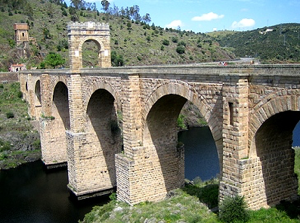
Fundación Iberdola España illuminated Alcántara Bridge with 36 low-energy lighting fixtures.
The project resulted in uniform and environment-friendly lighting. Thanks to this initiative, the electricity consumed by the bridge’s lighting system has decreased by 84%, after the installation of 36 LED-technology lights. In addition, the new layout of the lighting will highlight the horizontal nature of the bridge structure, thus reducing light pollution. This new lighting makes it possible to spend less on maintenance work, since these lighting devices have a lifespan of over 10 years.
With the aim of enhancing the bridge’s architectural elements, the new lighting combines general lighting of the sides of the 195-metre bridge with specific illumination for the six arches, including the central triumphal arch, which reaches a height of 14 metres.
A total of 36 low consumption luminaires were installed.
- Of these, 24 were placed on the sides and bridge abutments (replacing the previous ones), with the intention of emphasizing the horizontal nature of the monument, thus maintaining the projection from a distance while reducing both light pollution and the power rating of the lighting.
- The other 12 light fittings were located in pairs in the inside support of each arch, to reveal the hidden side of these elements and cause them to be reflected on the water of the Tagus.
Project details:
- LED technology luminaires were used, which provide for the future sustainability and energy savings of the installation.
- Glare and light pollution were limited and intrusive or unpleasant light reduced. This was achieved by lowering the power rating and regulating the lighting based on the reflection of the light according to the formal characteristics, roughness and material of each illuminated element.
- The current projection from a distance was combined with the placement of new spotlights inside the bridge arches, to provide definition and generate a new, more architectural concept, based on specifically enhancing certain of the bridge’s compositional elements and locating some of the lights on the bridge itself.
- The installation’s control and protection system was reduced.
- 84% energy efficiency.
The project has allowed the bridge’s architectural elements to be enhanced, with both general lighting of its sides and focused lighting of the arches.
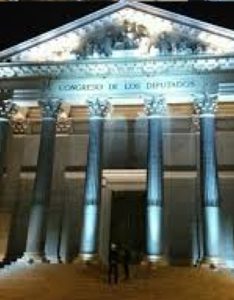
The artistic lighting for the main façade of the Congress of Deputies building consumes barely 1,400 watts.
The Congress of Deputies building was fitted with a new low consumption LED technology lighting system in 2014. Thanks to an agreement promoted by the former first vice-president of the Lower Chamber, Celia Villalobos, which was signed in September 2012, Fundación Iberdrola España financed, designed and installed the new exterior artistic lighting system, which has an installed power rating of 1,400 watts and is 25% lower than conventional bulbs.
This LED lighting makes the building stand out at night from its surroundings in the Plaza de las Cortes by highlighting this neoclassical building’s most significant elements. This project has not only brought the Congress building to life at night, but it also opted for sustainability and energy saving by installing low consumption luminaires. The project inauguration ceremony was attended by the former president of the Congress, Jesús Posada; Iberdrola chairman Ignacio Galán and the president of Fundación Iberdrola España, Manuel Marín.

